Samsung Electronics Co XE700T1A Nike Tablet User Manual Nike Tab eng indb
Samsung Electronics Co Ltd Nike Tablet Nike Tab eng indb
Contents
- 1. User Manual P1
- 2. User Manual P2
User Manual P1
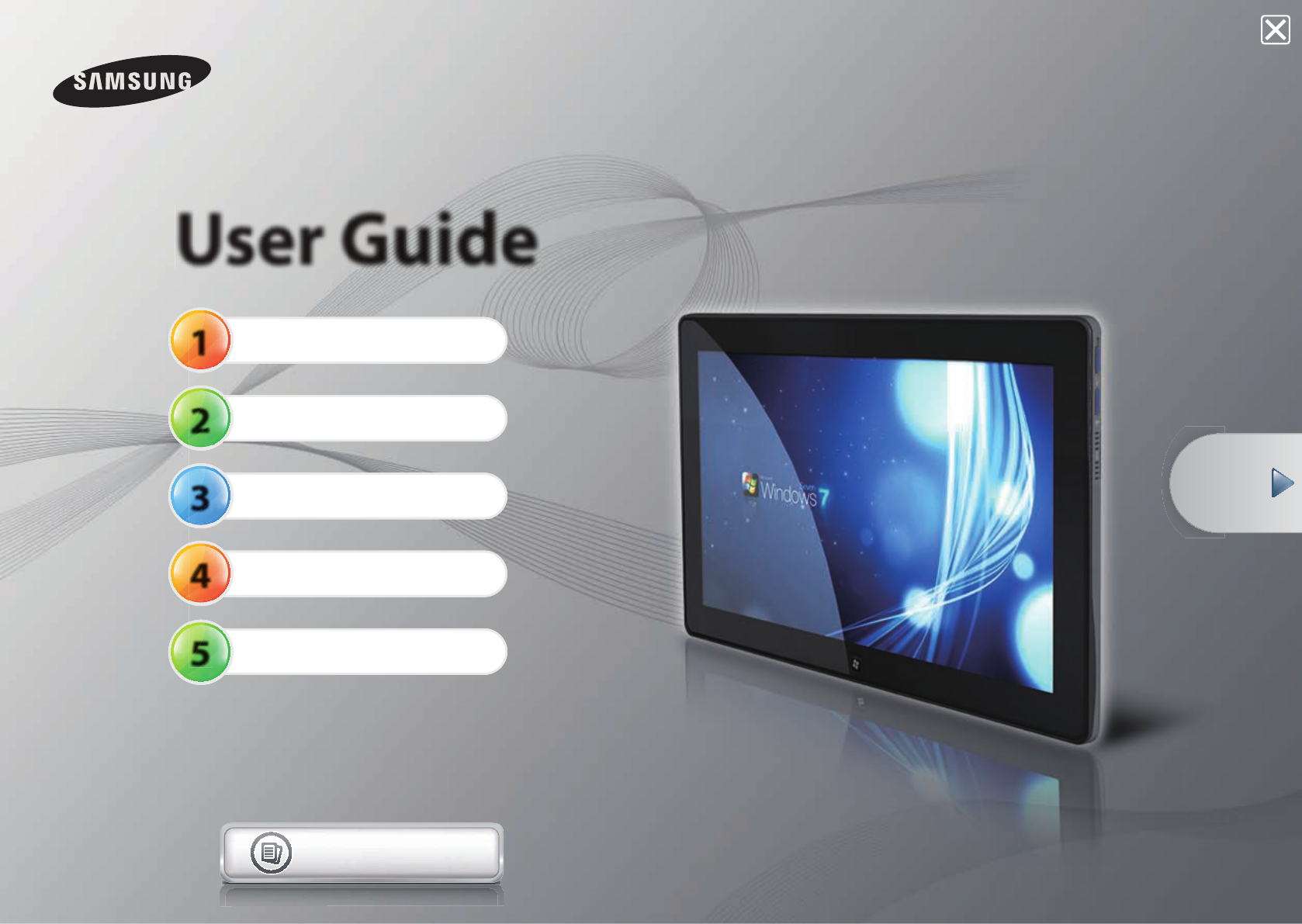
1
2
3
4
5
User Guide
Getting Started
Using the Computer
Settings and Upgrade
Backup / Restore
Appendix
Contents
Start
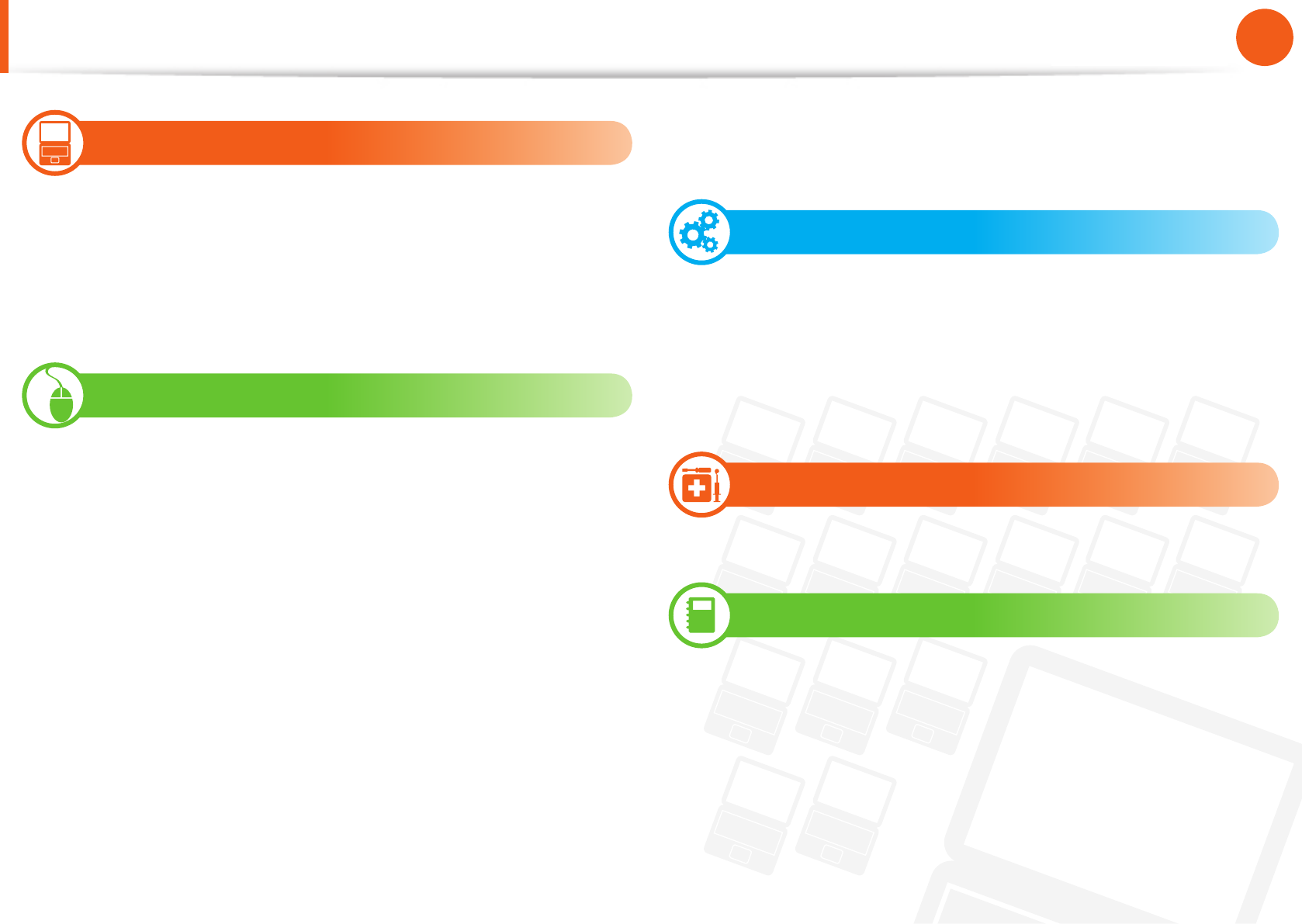
1
Chapter 1.
Getting Started
Contents
Chapter 1. Getting Started
3 Before You Start
6 Safety Precautions
21 Proper Posture During Computer Use
24 Overview
28 Turning the Computer On and O
Chapter 2. Using the Computer
35 Using the Touch Screen
(For Windows 7 touch screen models only)
41 Entering Letters Using the Touch Screen
(For Windows 7 touch screen models only)
43 Using the Touch Launcher
(For Windows 7 touch screen models only)
44 Using the Touch Supporter
(For Windows 7 touch screen models only)
46 Using the camera
48 Keyboard (Optional)
50 Micro SD Card Slot (Optional)
52 Connecting an External Display Device
57 Connecting an External Digital Device
58 Adjusting the Volume
60 Wired Network (Optional)
63 Wireless Network (Optional)
67 Using the Slate PC Dock (Optional)
Chapter 3. Settings and Upgrade
71 LCD Brightness Control
73 Easy Settings (Optional)
74 BIOS Setup
76 Changing the Boot Priority
77 Battery
Chapter 4. Backup / Restore
83 Samsung Recovery Solution (Optional)
Chapter 5. Appendix
96 Important Safety Information
98 Replacement Parts and Accessories
100 Regulatory Compliance Statements
115 WEEE Symbol Information
116 Product Speci cations
118 Glossary
122 Index
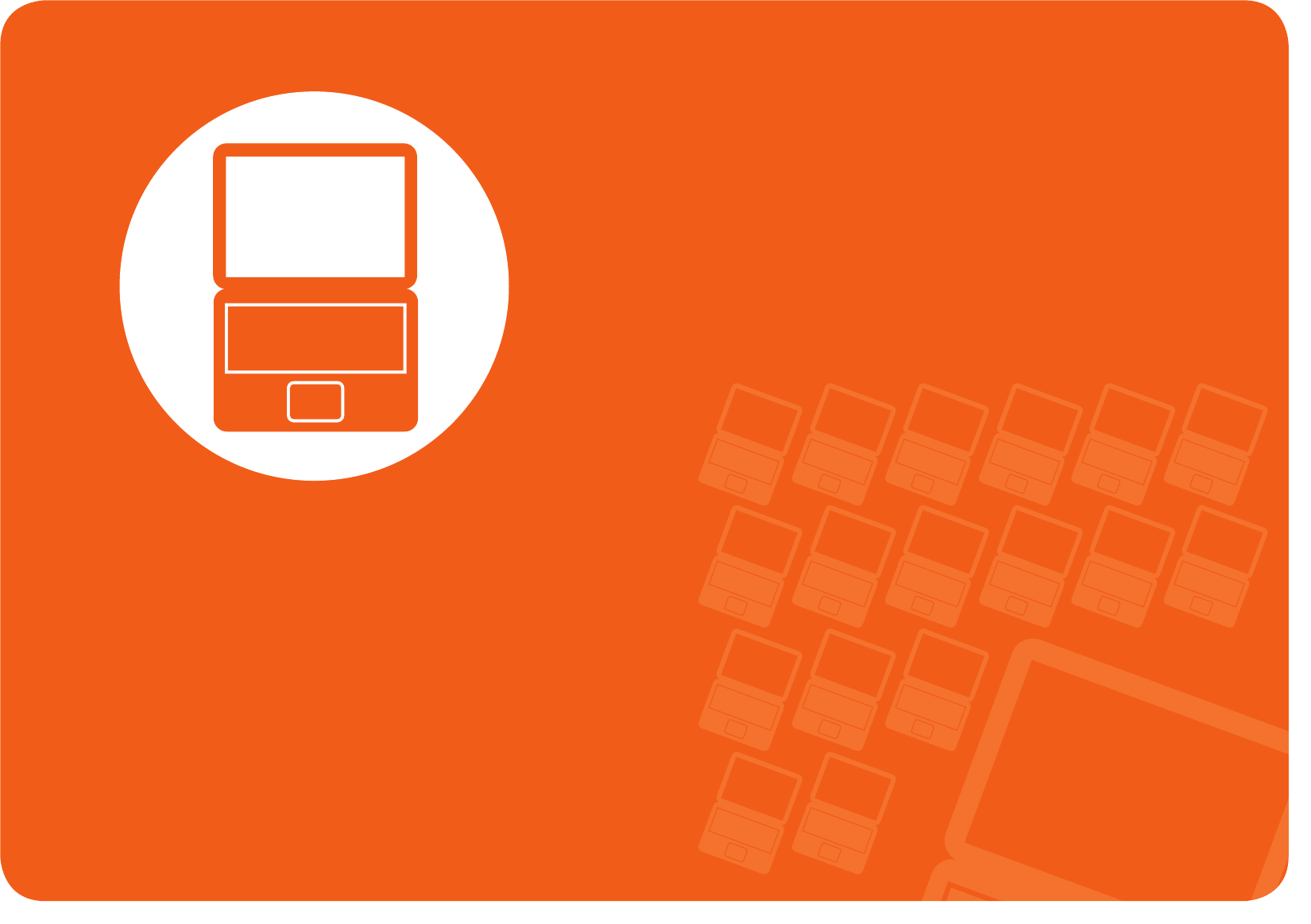
Before You Start 3
Safety Precautions 6
Proper Posture During Computer Use 21
Overview 24
Turning the Computer On and O 28
Chapter 1.
Getting Started
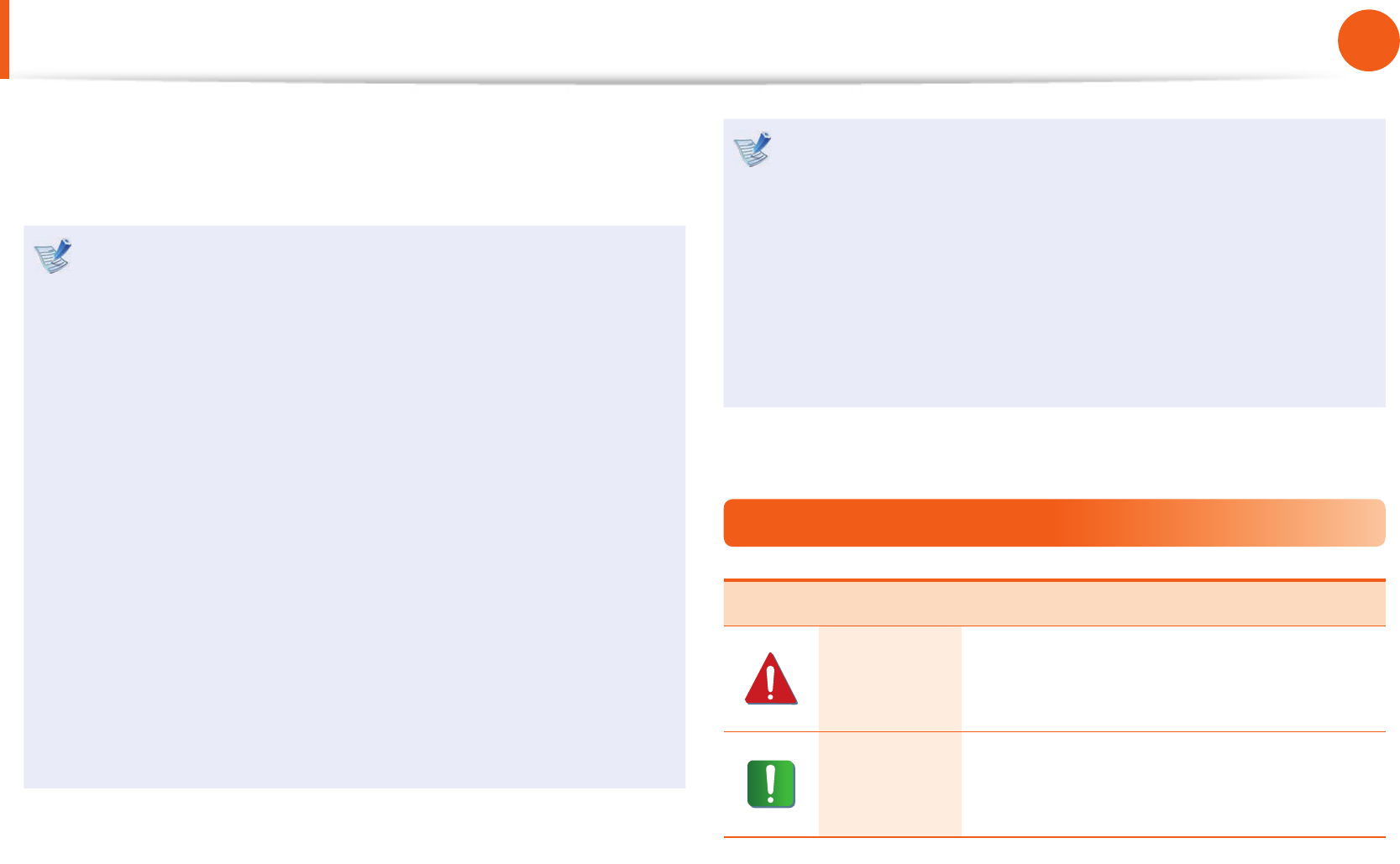
3
Chapter 1.
Getting Started
Before You Start
Before reading the User Guide, rst check the following
information.
Optional items, some devices and software referred to in •
the User Guide may not be provided and/or changed by
upgrade.
Note that the computer environment referred in the User
Guide may not be the same as your own environment.
The pictures used for the cover and the main body in the •
User Manual are those of the representative model of each
series and may di er from the actual appearance of the
product.
This guide decribes procedures for using both the mouse •
and the touch screen.
The User Guide describes information on the basis of the •
touch screen.
This manual has been written for the Windows 7 operating •
system. The descriptions and gures may di er depending
on the installed operating system.
The User guide supplied with this computer may vary •
depending on your model.
Using the software
The software described in the main text can be launched •
using the following menu path.
- Start > All Programs
- Start > All Programs > Samsung
When the programs are not installed, select • Samsung
Recovery Solution > System Software to install the
programs. (Only for models supplied with Samsung
Recovery Solution)
Safety Precaution Notations
Icon Notation Description
Warning
Failure to follow instructions marked with
this symbol, may cause personal injury
and or fatality.
Caution
Failure to follow instructions marked with
this symbol, may cause slight injury to
yourself or damage your property.
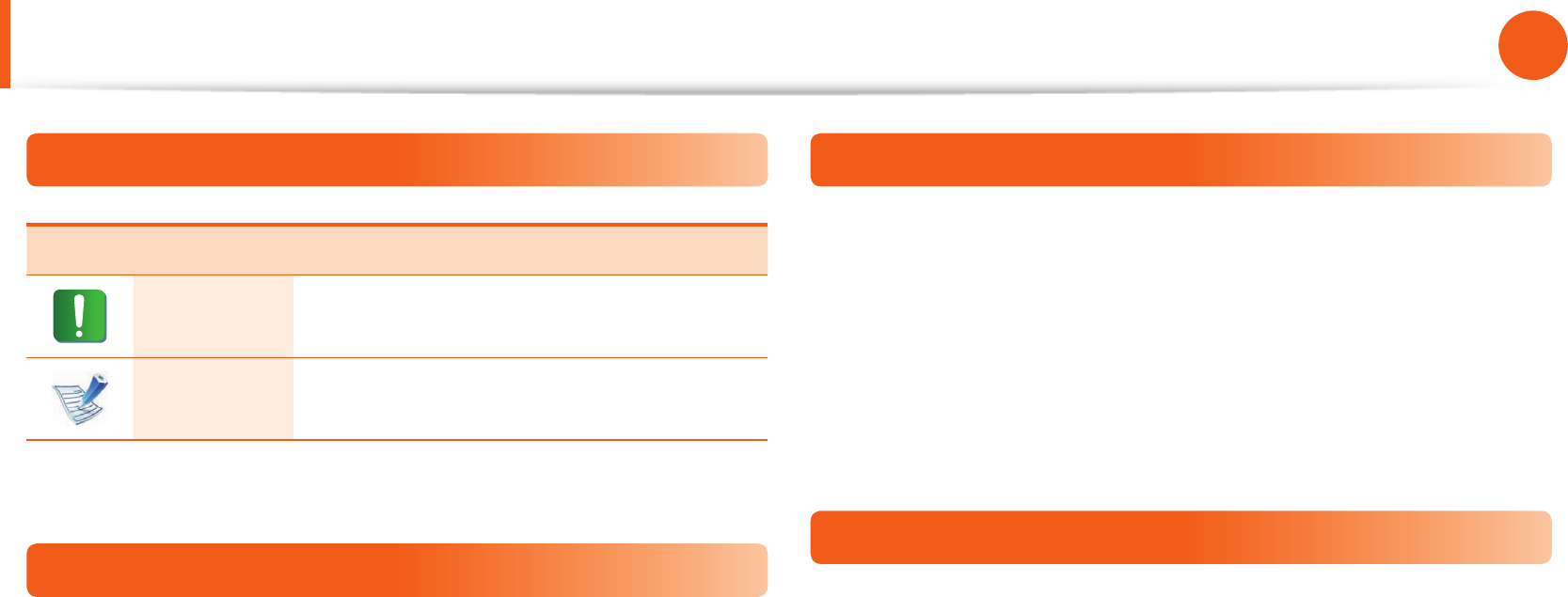
4
Chapter 1.
Getting Started
Before You Start
Text Notations
Icon Notation Description
Caution Content included in this section includes
information required about the function.
Note Content included in this section includes
helpful information to use the function.
Copyright
© 2011 Samsung Electronics Co., Ltd.
Samsung Electronics Co., Ltd. owns the copyright of this manual.
No part of this manual may be reproduced or transmitted in any
form or by any means, electronic or mechanical, without the
consent of Samsung Electronics Co., Ltd.
The information in this document is subject to change without
notice due to improving the performance of the product.
Samsung Electronics shall not be liable for any data loss. Please
take care to avoid losing any important data and backup your data
to prevent any such data loss.
Precautions for Operating System Support
If a problem occurs because of the reinstallation of other
operating systems(OS) or a previous version of an OS pre-installed
on this computer, or a software that does not support the OS, the
company will not provide technical support, a replacement or
refund, and if our service engineer visits you due to this problem,
a service charge will be applied.
Performance Restrictions
Online games and some games(3D,2D) may not be supported and
Full HD video and some high bit rate HD video playback may be
slow and stutter on this computer.

4
5
Chapter 1.
Getting Started
About the Product Capacity Representation
Standard
About the capacity representation of the storage
The capacity of the storage device (HDD, SSD) of the manufacturer
is calculated assuming that 1KB=1,000 Bytes.
However, the operating system (Windows) calculates the storage
device capacity assuming that 1KB=1,024 Bytes, and therefore the
capacity representation of the HDD in Windows is smaller than the
actual capacity due to the dierence in capacity calculation.
(E.g. For a 80GB HDD, Windows represents the capacity as 74.5GB,
80x1,000x1,000x1,000 byte/(1,024x1,024x1,024)byte = 74.505GB)
In addition, the capacity representation in Windows may be even
smaller because some programs such as Recovery Solution may
reside in a hidden area of the HDD.
About Memory Capacity Representation
The memory capacity reported in Windows is less than the actual
capacity of memory.
This is because BIOS or a video adapter uses a portion of memory
or claims it for further use.
(E.g. For 1GB(=1,024MB) memory installed, Windows may report
the capacity as 1,022MB or less)
For more information, refer to the Samsung Recovery Solution
section.
Before You Start
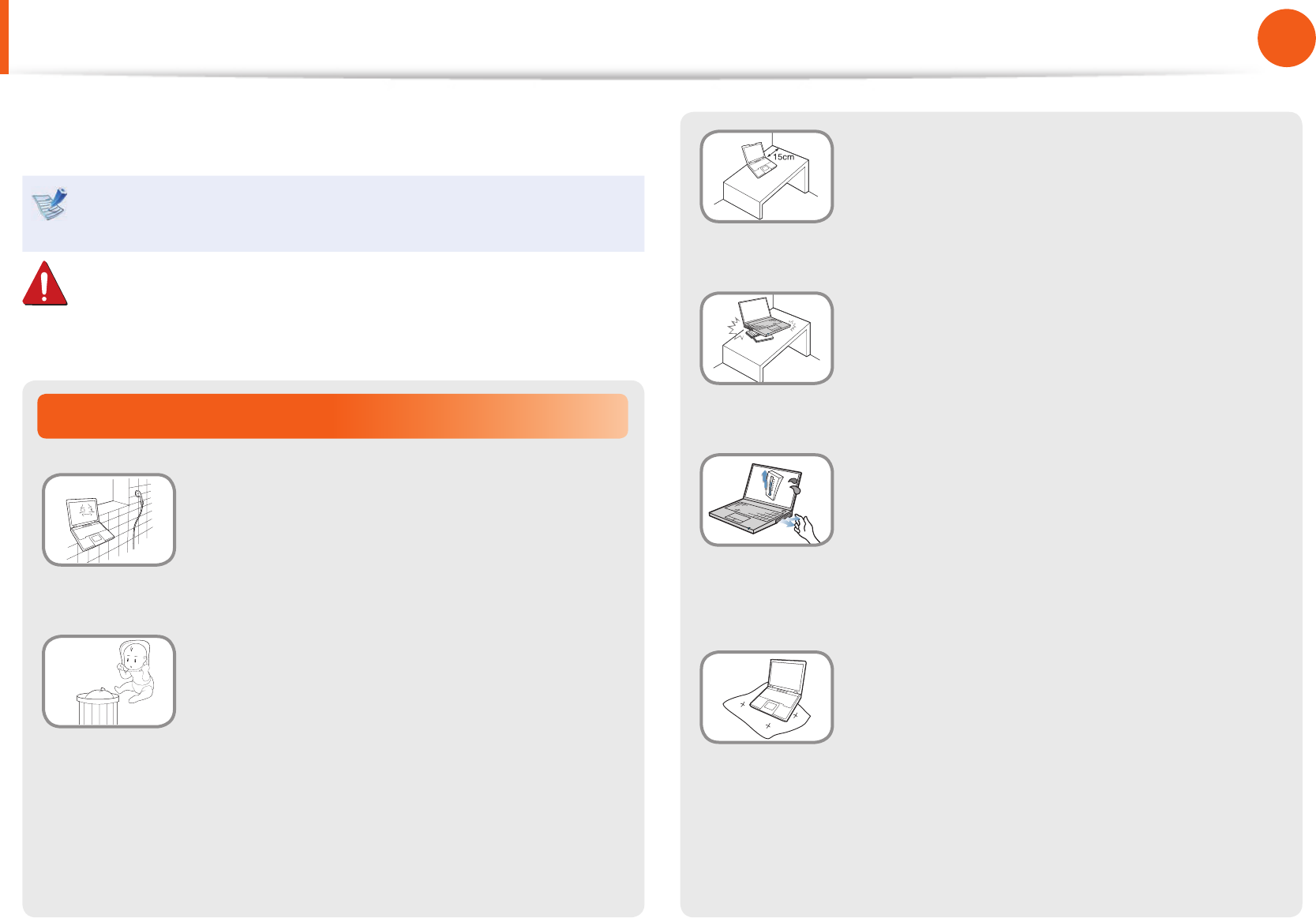
6
Chapter 1.
Getting Started
Installation Related
Do not install the product in places exposed
to humidity such as a bathrooms.
There is a danger of electric shock. Use the
product within the operating conditions
speci ed in the Manufacturers User Guide.
Keep the plastic bags out of the reach of
children.
There is a danger of su ocation.
Safety Precautions
Keep a distance of 15cm or more between
the computer and the wall and do not place
any objects between them.
This may increase the internal temperature of
the computer and may cause an injury.
Do not install the computer on a slant or a
place prone to vibrations, or avoid using the
computer in that location for a long time.
This increases the risk that a malfunction or
damage to the product will occur.
Avoid exposing any part of your body to the
heat from the computer vent or AC adapter
for a long time when the computer is on.
Exposing a part of your body close to the heat
from the vent or AC adapter for long periods of
time may cause a burn.
Avoid blocking the vent at the bottom or
side of the computer when using it on a bed
or cushion.
If the vent is blocked, there is a danger of
damaging the computer or overheating the
inside of the computer.
For your security and to prevent damage, please read the
following safety instructions carefully.
Since this is commonly applied to Samsung Computers,
some pictures may di er from actual products.
Warning
Failure to follow instructions marked with this symbol may
cause personal injury and even fatality.
NB Ver 2.7
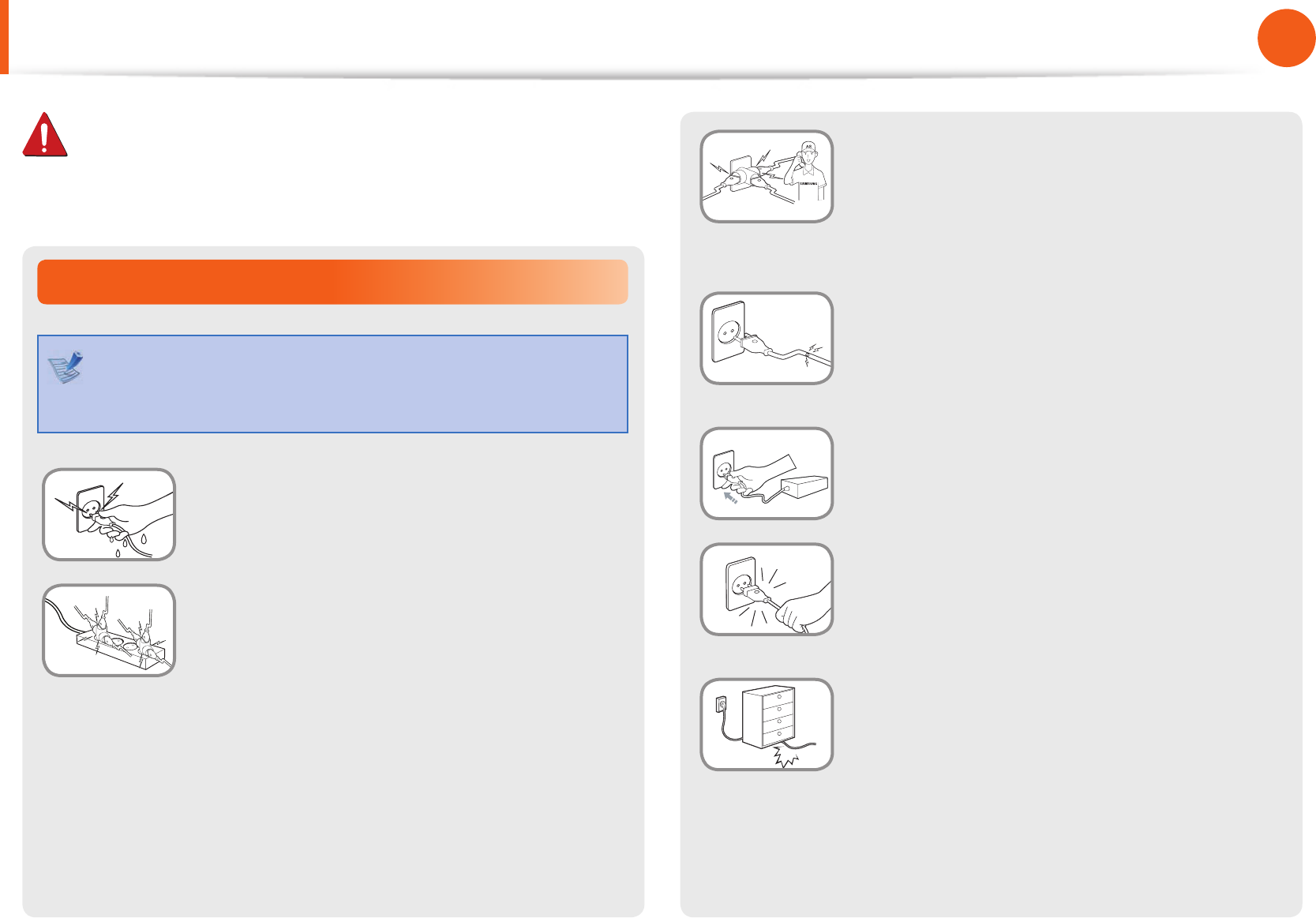
6
7
Chapter 1.
Getting Started
If the power cord or power outlet makes a
noise, disconnect the power cord from the
wall outlet and contact a service center.
There is a danger of electric shock or re
hazard.
Do not use a damaged or loose main plug or
power cord or power outlet.
There is a danger of electric shock or re
hazard.
Plug the power cord rmly into the power
outlet and AC adapter.
Failure to do so may cause re hazard.
Do not unplug the power cord by pulling
the cable only.
If the cord is damaged, it may cause electric
shock.
Do not bend the power cord excessively or
do not place a heavy object over the power
cord. It is especially important to keep the
power cord out of reach of infants and pets.
If the cord is damaged, it may cause electric
shock or re.
Power Related
The power plug and wall outlet gures may di er
depending on the country speci cations and the product
model.
Do not touch the main plug or power cord
with wet hands.
There is a danger of electric shock.
Do not exceed the standard capacity
(voltage/current) of a multiplug or power
outlet extension when using it for the
product.
There is a danger of electric shock or re
hazard.
Safety Precautions
Warning
Failure to follow instructions marked with this symbol may
cause personal injury and even fatality.
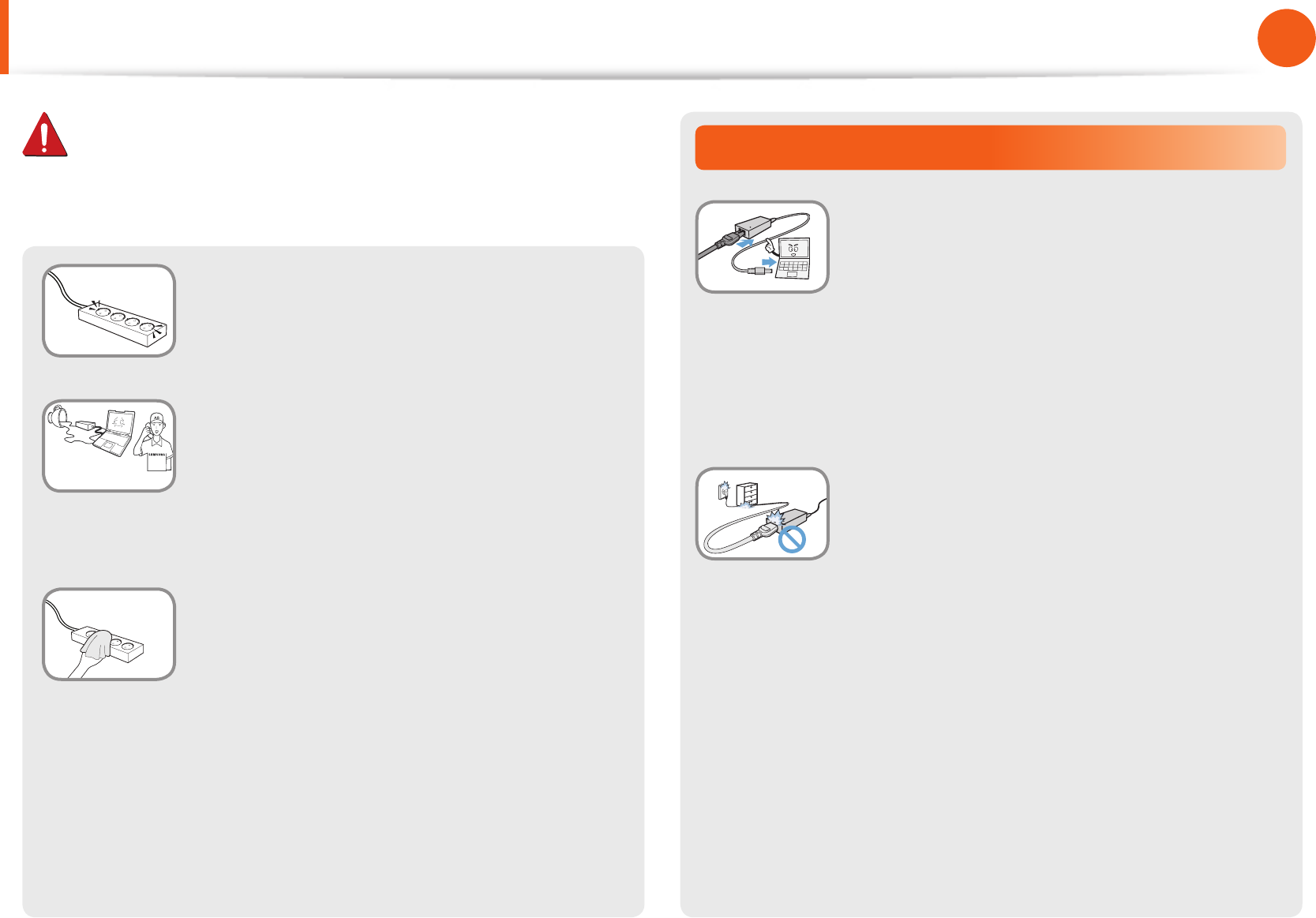
8
Chapter 1.
Getting Started
Connect the power cord to an outlet or
multiple power plug (extended cable) with
a ground terminal.
Failure to do so may result in electric shock.
If water or a foreign substance enters
the power jack, adapter or computer,
immediately separate the power cord and
battery and call the service center.
Damage to the device within the computer
may cause electric shock or re hazard.
Keep the power cord or outlet clean so that
they are not covered with dust.
Failure to do so may result in re.
AC Adapter Usage Precautions
Connect the power cord to the AC adapter
rmly.
Otherwise, there is a danger of re due to an
incomplete contact.
Use only the AC adapter supplied with the
product.
Using another adapter may cause the screen to
icker.
Do not place heavy objects or step onto
the power cord or AC adapter to avoid
damaging the power cord or AC adapter.
If the cord is damaged, there is a danger of
electric shock or re.
Warning
Failure to follow instructions marked with this symbol may
cause personal injury and even fatality.
Safety Precautions
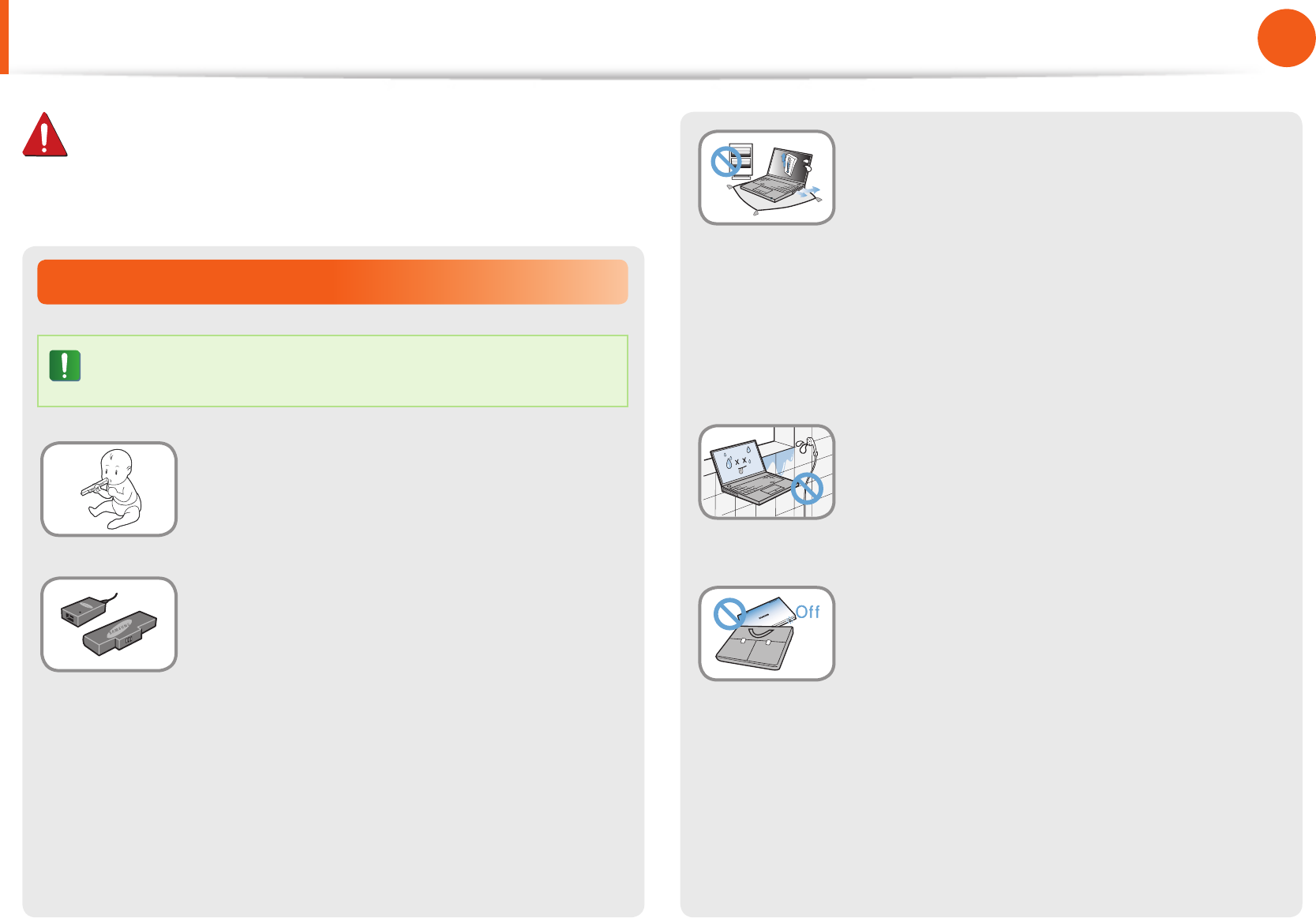
8
9
Chapter 1.
Getting Started
Battery Usage Related
Please charge the battery fully before using the
computer for the rst time.
Keep the battery out of the reach of infants
and pets, as they could put the battery into
their mouths.
There is a danger of electric shock or choking.
Use an authorized battery and AC adapter
only.
Please use an authorized battery and adapter
approved by Samsung Electronics.
Unauthorized batteries and adapters may not
meet the proper safety requirements and may
cause problems or malfunctions and result in
an explosion or re.
Warning
Failure to follow instructions marked with this symbol may
cause personal injury and even fatality.
Safety Precautions
Do not use the computer in a badly
ventilated location such as on bedding, on a
pillow or cushion, etc, and do not use it in a
location such as room with oor heating as
it may cause the computer to overheat.
Take care that the computer vents (on the side
or the bottom) are not blocked especially in
these environments. If the vents are blocked,
the computer may overheat and it may cause a
computer problem, or even an explosion.
Do not use the computer in a humid
location such as a bathroom or sauna.
Please use the computer within the
recommended temperature and humidity
range (10~32ºC, 20~80% RH).
Do not close the LCD panel and put the
computer into your bag to move it when it
is still turned on.
If you put the computer into your bag without
turning it o, the computer may overheat and
there is a danger of re. Shut the computer
down properly before moving it.
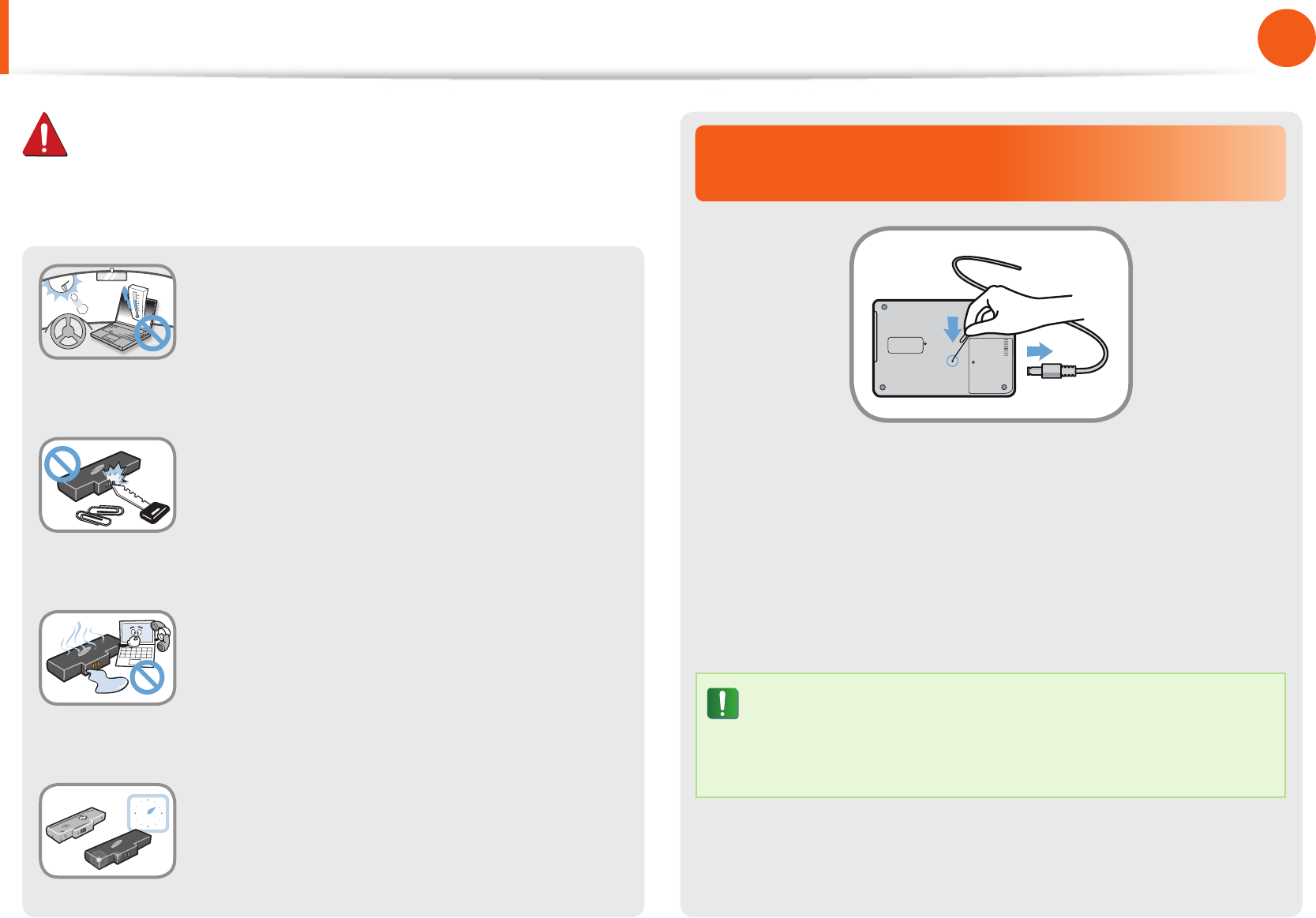
10
Chapter 1.
Getting Started
Cutting the power to the internal battery
(for corresponding models only.)
For products with built-in batteries, customers cannot remove • the battery.
In the case of ooding, lightning or explosions, you can cut the • battery power by inserting an object such as a paper clip into
the [Emergency Hole] at the bottom of the computer.
Disconnect the AC adapter and insert an object such as a • paper clip into the hole at the bottom of the computer to cut
the battery power.
In the case of ooding, lightning or explosions, cut
the battery power, do not reconnect the AC adapter,
and immediately contact Samsung Electronics so that
the appropriate countermeasures can be taken.
Never heat the product(or battery) or put
the product(or battery) into a re. Do not
put or use the product(or battery) in a hot
location such as a sauna, inside a vehicle
exposed to the heat, and so on.
There is a danger of an explosion or re.
Take care not to allow metal objects such as
a key or clip to touch the battery terminal
(metal parts).
If a metal object touches the battery terminals,
it may cause excessive current ow and it may
damage the battery, or result in a re.
If liquid leaks out of the product(or battery)
or there is a funny smell coming from
the product(or battery), remove the the
product(or battery) the computer and
contact a service center.
There is a danger of an explosion or re.
To use the computer safely, replace a dead
battery with a new, authorized battery.
Safety Precautions
Warning
Failure to follow instructions marked with this symbol may
cause personal injury and even fatality.
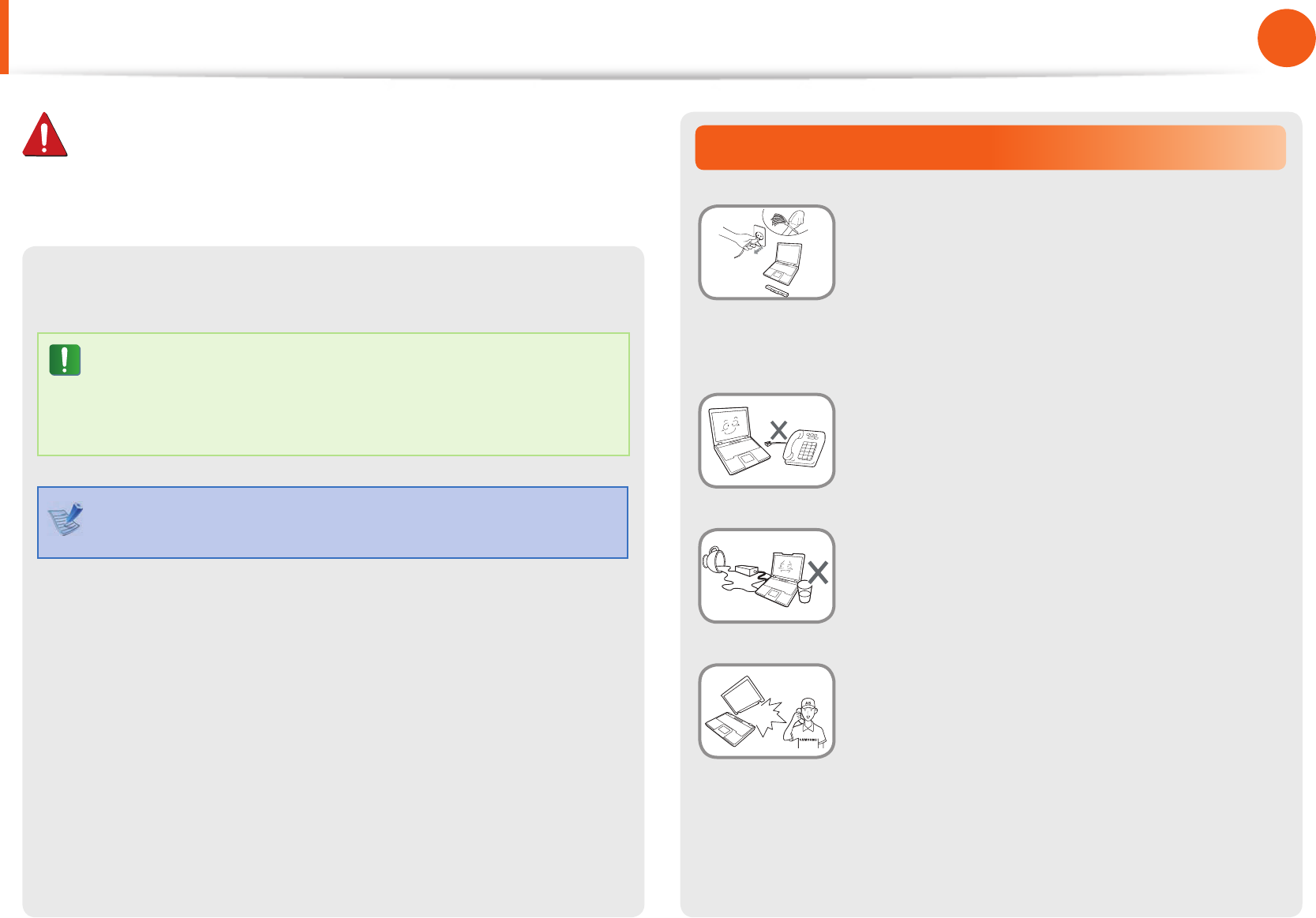
10
11
Chapter 1.
Getting Started
Safety Precautions
Warning
Failure to follow instructions marked with this symbol may
cause personal injury and even fatality.
Thereafter, if you connect the AC adapter, the battery power • will be supplied again.
Do not cut the battery power under normal •
conditions.
This may result in data loss or a product •
malfunction.
The location of the Emergency Hole may di er depending
on the model.
Usage Related
Disconnect all cables connected to the
computer before cleaning it. If your
notebook is external & removable battery
type, remove the external battery.
There is a danger of electric shock or damage
to the product.
Do not connect a phone line connected to a
digital phone to the modem.
There is a danger of a electric shock, re or
damage to the product.
Do not place any container lled with water or
chemicals over or near the computer.
If water or chemicals enter the computer, this
may cause re or electric shock.
If you drop or damage the computer,
separate the power cord and battery and
ask the service center to perform a safety
check.
Using a broken computer may cause electric
shock or re hazard.
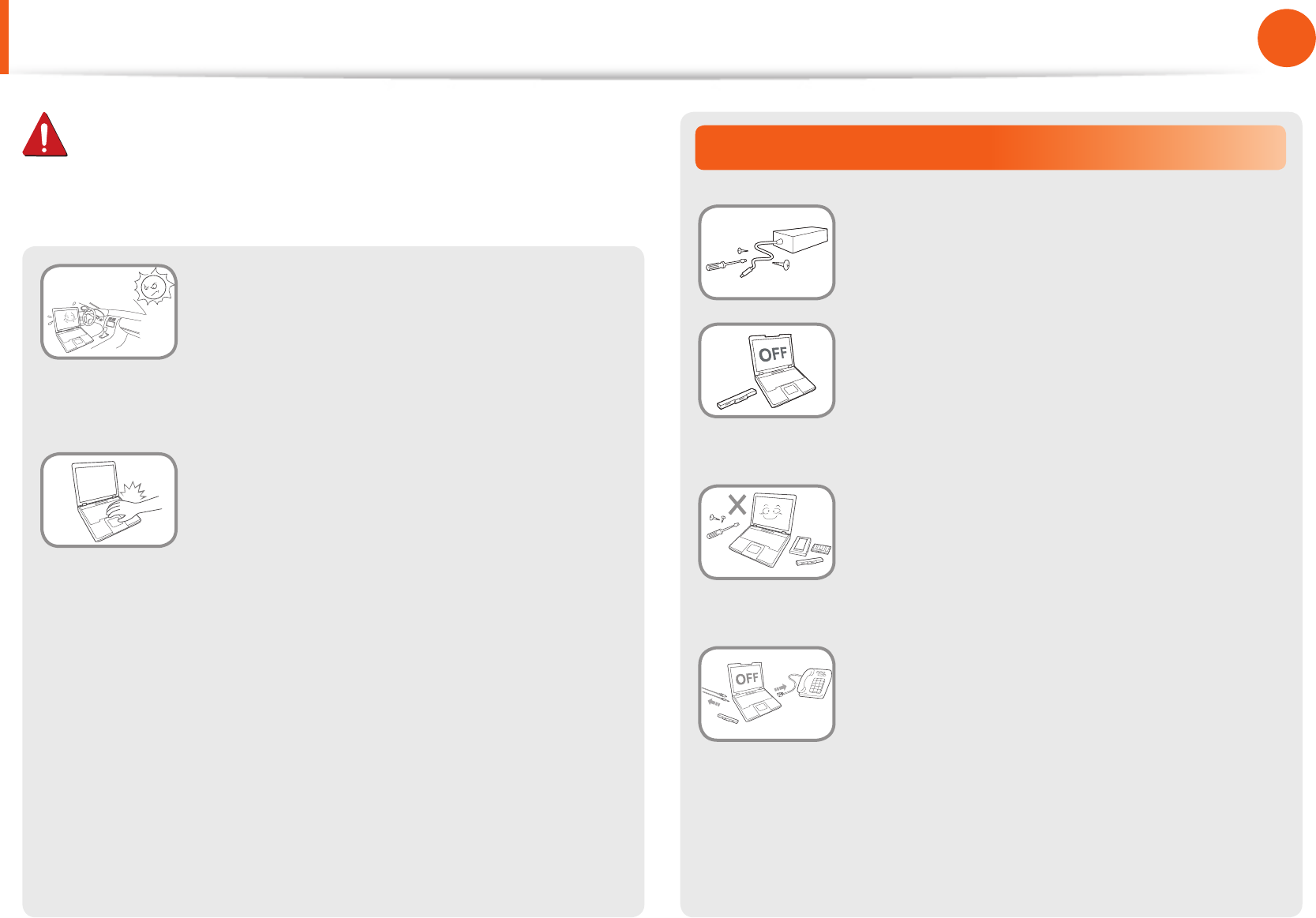
12
Chapter 1.
Getting Started
Upgrade Related
Never disassemble the power supply or AC
adapter.
There is a danger of electric shock.
When removing the RTC (Real Time Clock)
battery, keep it out of the reach of children
as they could touch and/or swallow it.
There is a danger of choking. If a child has
swallowed it, contact a doctor immediately.
Use only authorized parts (multi-
plug, battery and memory) and never
disassemble parts.
There is a danger of damaging the product,
electric shock or re hazard.
Shut down the computer and disconnect
all cables before disassembling the
computer. If there is a modem, disconnect
the phone line. If your notebook is external
& removable battery type, remove the
external battery.
Failure to do so, may cause electric shock.
Avoid direct sunlight when the computer
is in an air-tight location such as inside a
vehicle.
There is a danger of a re hazard. The computer
may overheat and also present opportunity to
thieves.
Do not use your notebook PC for long
periods of time while any part of your
body is making direct contact with it. The
temperature of the product may increase
during normal operation.
This may result in harming or burning your skin.
Safety Precautions
Warning
Failure to follow instructions marked with this symbol may
cause personal injury and even fatality.
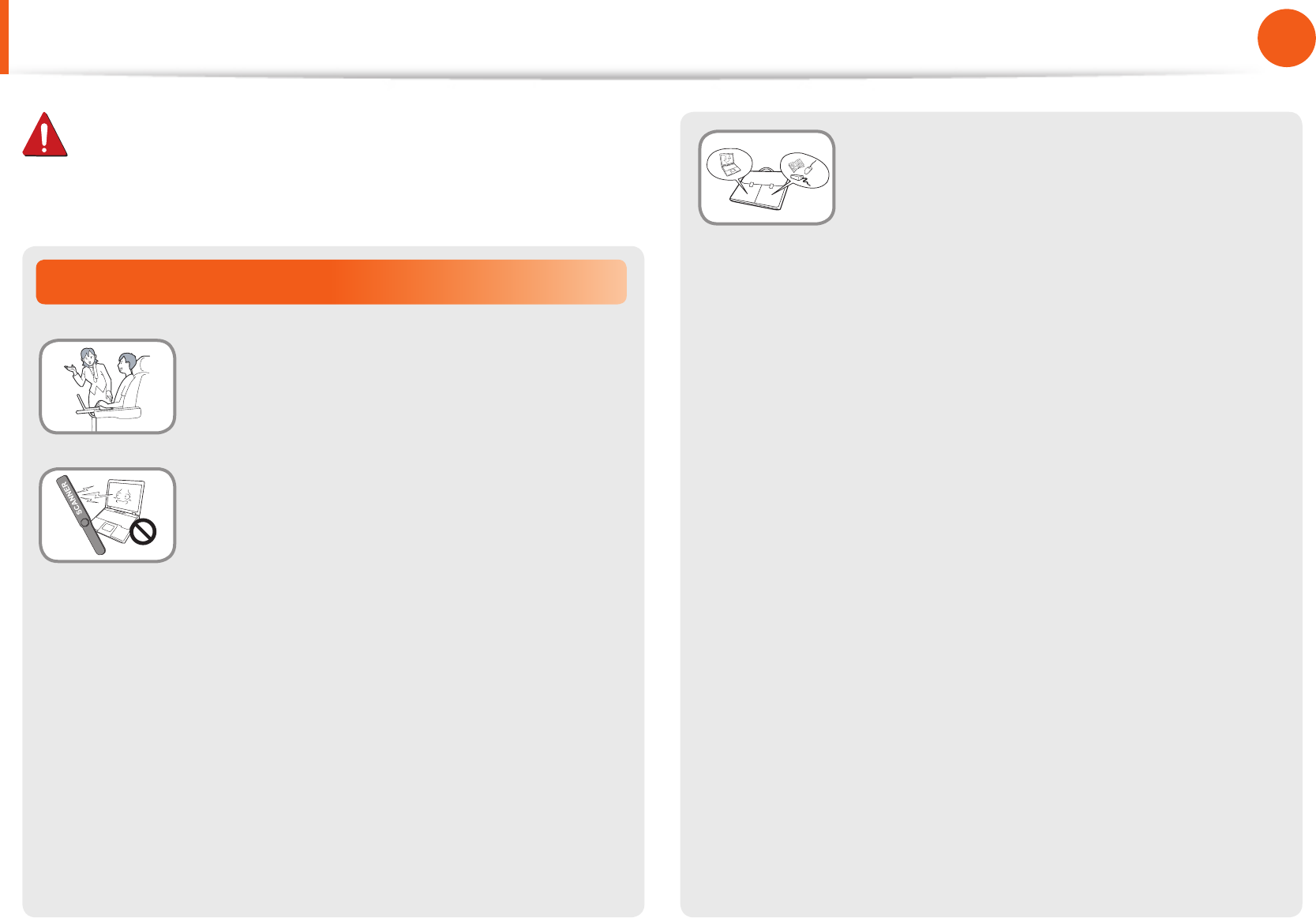
12
13
Chapter 1.
Getting Started
When carrying the notebook computer
with other items, such as the adapter,
mouse, books etc, take care not to press
anything against the notebook computer.
If a heavy object is pressed against the
notebook computer, a white spot or stain may
appear on the LCD. Therefore, take care not to
apply any pressure to the notebook.
In this case, place the notebook computer in
a separate compartment away from the other
objects.
Security and Movement Related
Follow the instructions for the relevant
location (e.g. airplane, hospital, etc.) when
using a wireless communication device
(wireless LAN, Bluetooth, etc.).
Avoid exposing a drive to magnetic elds.
Security devices with magnetic elds in-
clude airport walk-through devices and se-
curity wands.
The airport security devices that check car-
ry-on luggage, such as conveyor belts, use
x-rays instead of magnetism and will not
damage a drive.
Safety Precautions
Warning
Failure to follow instructions marked with this symbol may
cause personal injury and even fatality.
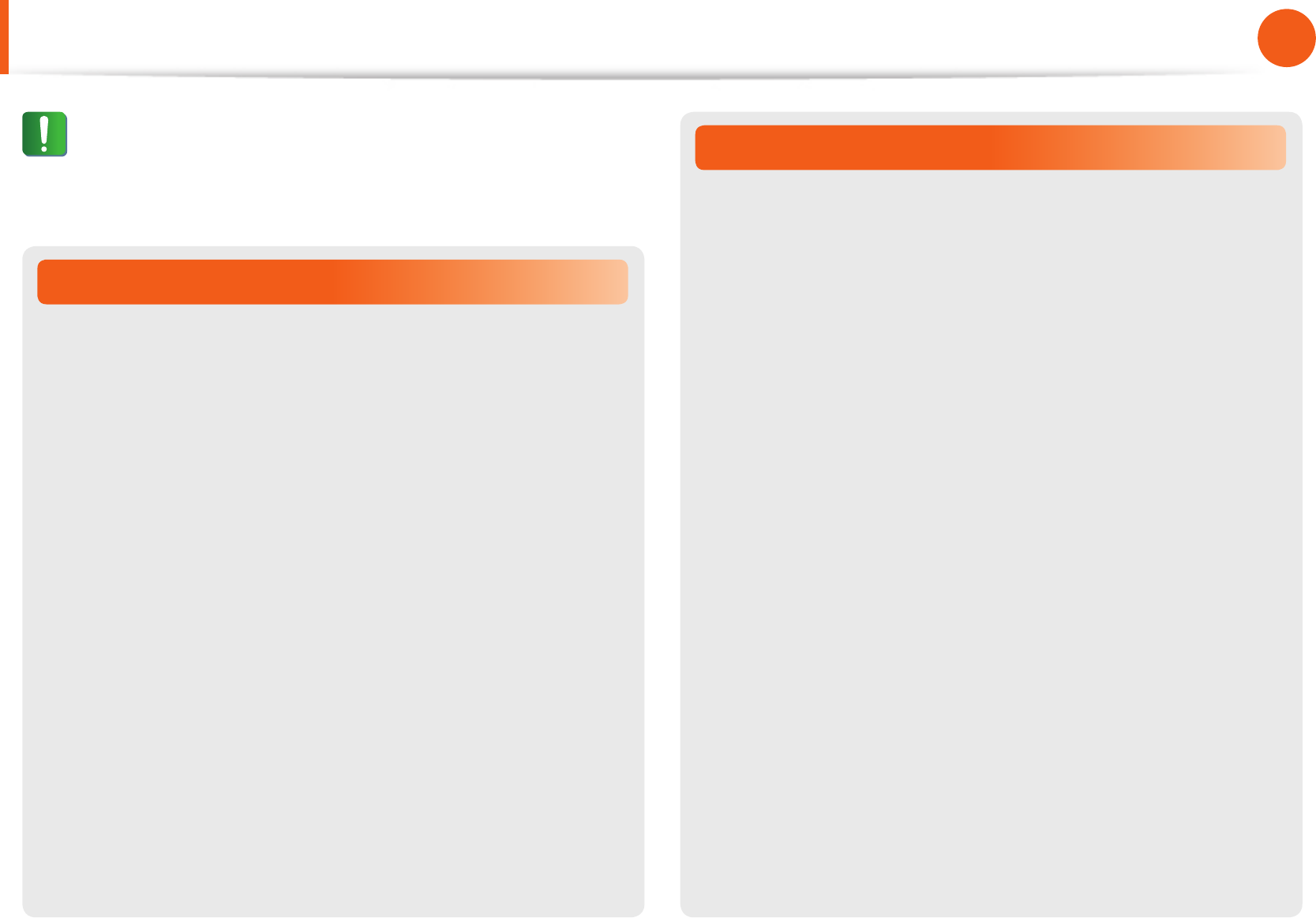
14
Chapter 1.
Getting Started
Safety Precautions
Installation Related
Do not block the ports (holes), vents, etc. of the product and
do not insert objects.
Damage to a component within the computer may cause electric
shock or re.
When using the computer with it lying on its side, place it so
that the vents face upwards.
Failure to do so, may cause the internal temperature of the
computer to rise and the computer to malfunction or halt.
Do not place a heavy object over the product.
This may cause a problem with the computer. In addition, the
object may fall and cause injury, or damage the computer.
Battery Usage Related
Dispose of worn-out batteries properly.
There is a danger of re or explosion.•
The battery disposal method may dier depending on •
your country and region. Dispose of the used battery in an
appropriate way.
Do not throw or disassemble the battery and do not put it
into water.
This may cause an injury, re or explosion.
Use only a battery authorized by Samsung Electronics.
Failure to do so may cause an explosion.
Avoid contact with metal objects such as car keys or clips
when keeping or carrying a battery.
Contact with a metal may cause excessive current and a high
temperature and may damage the battery or cause a re.
Charge the battery according to the instructions in the manual.
Failure to do so, may cause an explosion or re from damage to
the product.
Do not heat the product(or battery) or expose it to heat (e.g.
inside a vehicle during the summer).
There is a danger of explosion or re.
Caution
Failure to follow instructions marked with this symbol may
cause slight injury or damage to the product.

14
15
Chapter 1.
Getting Started
Usage Related
Do not place a candle, light cigar, etc. over or on the product.
There is a danger of re.
Use a wall outlet or multi-plug with a grounding part.
Failure to do so may cause electric shock hazard.
Make sure to have the product tested by a safety service
engineer after repairing the product.
Authorized Samsung Repair Centers will carry out safety checks
after a repair. Using a repaired product without testing it for
safety may cause an electric shock or re.
In case of lightning, immediately turn the system o,
disconnect the power cord from the wall outlet and phone
line from modem. Do not use a modem or phone.
There is a danger of electric shock or re.
Do not use your computer and AC-Adapter on your lap or
soft surfaces.
If the computer temperature increases, there is a danger of
burning yourself.
Connect only permitted devices to the connectors or ports
of the computer.
Failure to do so, may cause electric shock and re.
Close the LCD panel only after checking if the notebook
computer is turned o.
The temperature may rise and it may cause overheating and
deformation of the product.
Do not press the Eject Button while the Floppy Disk/CD-ROM
drive is in operation.
You might lose data and the disk might be suddenly ejected and
could cause an injury.
Take care not to drop the product while using it.
This may cause personal injury or loss of data.
Do not touch the antenna with electricity facility such as the
power outlet.
There is a danger of electric shock.
When handling computer parts, follow the instructions on
the manual supplied with the parts.
Failure to do so, may cause damage to the product.
Safety Precautions
Caution
Failure to follow instructions marked with this symbol may
cause slight injury or damage to the product.

16
Chapter 1.
Getting Started
If the computer emits smoke, or there is a burning smell,
disconnect the power plug from the wall outlet and contact
a service center immediately. If your notebook is external &
removable battery type, remove the external battery.
There is a danger of re.
Do not use a damaged or modied CD/Floppy Disk.
There is a danger of damaging the product or personal injury.
Do not insert your ngers into the PC Card Slot.
There is a danger of injury or electric shock.
Use recommended computer cleansing solution when
cleaning the product and only use the computer when it is
completely dried.
Failure to do so may cause electric shock or re.
Emergency disk eject method using paperclip should not
be used while the disk is in motion. Make sure to use the
emergency disk eject method only when the Optical Disk
Drive has stopped.
There is a danger of injury.
Do not place your face close to the Optical Disk Drive tray
when it is operating.
There is a danger of injury due to an abrupt ejection.
Check CDs for cracks and damage prior to use.
It may damage the disc and cause disorder of device and injury of
user.
Safety Precautions
Caution
Failure to follow instructions marked with this symbol may
cause slight injury or damage to the product.
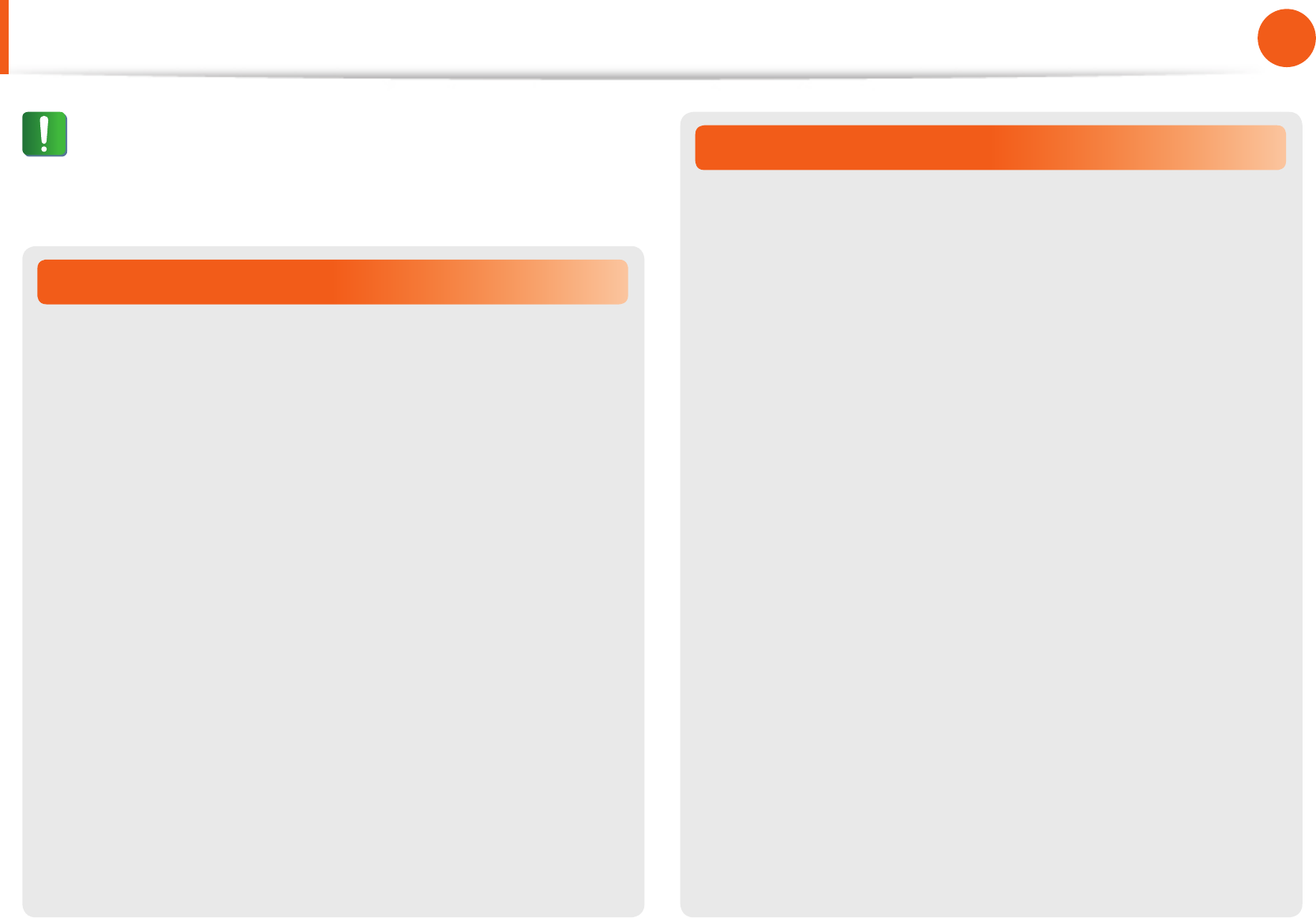
16
17
Chapter 1.
Getting Started
Upgrade Related
Take care when touching the product or parts.
The device may be damaged or you may be injured.
Take care not to throw or drop a computer part or device.
This may cause injury or damage to the product.
Make sure to close the computer cover before connecting
the power after a reassembly.
There is a danger of electric shock if your body touches an
internal part.
Use parts authorized by Samsung Electronics only.
Failure to do so, may cause re or damage the product.
Never disassemble or repair the product by yourself.
There is a danger of electric shock or re.
To connect a device that is not manufactured or authorized
by Samsung Electronics, enquire at your service center
before connecting the device.
There is a danger of damaging the product.
Security and Movement Related
When moving the product, turn the power o and separate
all connected cables rst.
The product might be damaged or users may trip over the cables.
For long periods of not using the notebook computer,
discharge the battery and preserve as it is detached.
(For external & removable battery type)
The battery will be preserved at its best condition.
Do not operate or watch the computer while driving a
vehicle.
There is a danger of a trac accident. Please concentrate on
driving.
Safety Precautions
Caution
Failure to follow instructions marked with this symbol may
cause slight injury or damage to the product.

18
Chapter 1.
Getting Started
Cautions on Preventing Data Loss
(Hard Disk Management)
Take care not to damage the data on a hard disk drive.
A hard disk drive is so sensitive to external impact that an •
external impact may cause loss of data on the surface of the
disk.
Take extra care, because moving the computer or an impact •
on the computer when it is turned on may damage the data of
the hard disk drive.
The company is not liable for any loss of data on the hard disk •
drive.
Causes that may damage the data of a hard disk drive and
the hard disk drive itself.
The data may be lost when an external impact is applied to the •
disk while disassembling or assembling the computer.
The data may be lost when the computer is turned o or reset •
by a power failure while the hard disk drive is operating.
The data may be lost and irrecoverable due to a computer virus •
infection.
The data may be lost if the power is turned o while running a •
program.
Sudden impact or movement to the computer while the hard •
disk drive is operating, may cause les to be corrupted or bad
sectors on the hard disk.
To prevent data loss due to damage to the hard disk drive,
please backup your data frequently.
Safety Precautions
Caution
Failure to follow instructions marked with this symbol may
cause slight injury or damage to the product.
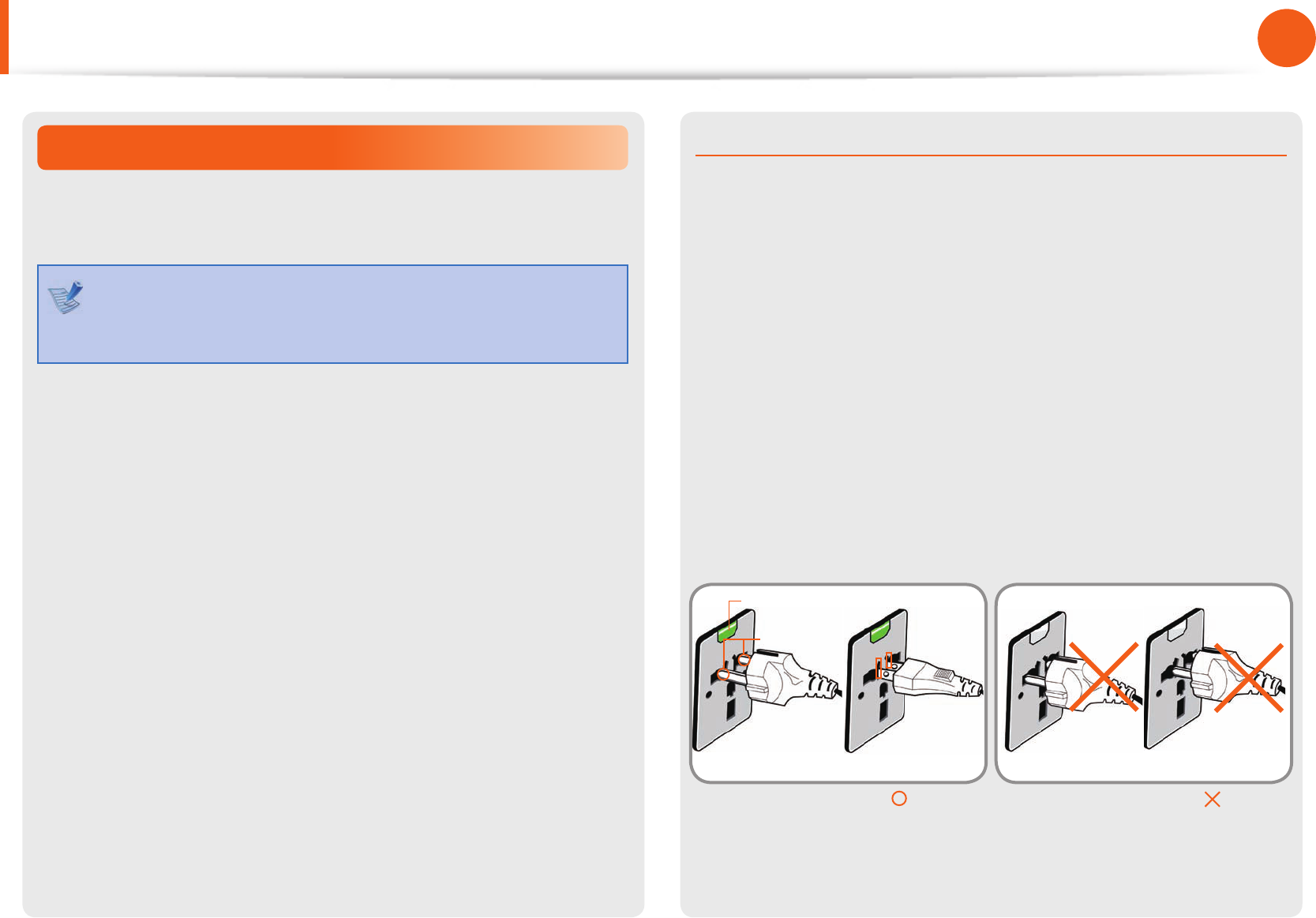
18
19
Chapter 1.
Getting Started
Safety Precautions
Using the power supply in an airplane
Since the power outlet type di ers depending on the type of
airplane, connect the power appropriately.
Since the representative gures of the power plug and
the auto adapter are used, they may di er from the actual
parts.
When using the AC power plug
Connect the power plug pins perpendicular into the center of the
power outlet.
If the plug pins are not inserted into the center of the holes, the •
plug pins are only inserted up to half their length. In this case,
reconnect the power plug.
You have to insert the power plug into the outlet when the •
power indicator (LED) of the power outlet is lit green. If the
power is connected properly, the power indicator (LED)
remains green.
Otherwise, the power indicator (LED) is turned o . In this case,
unplug the power, check if the power indicator (LED) is green,
and then reconnect the power plug.
Wrong Example
Good Example
220V Power Plug 110V Power Plug
Center
Holes
Power Indicator (LED)
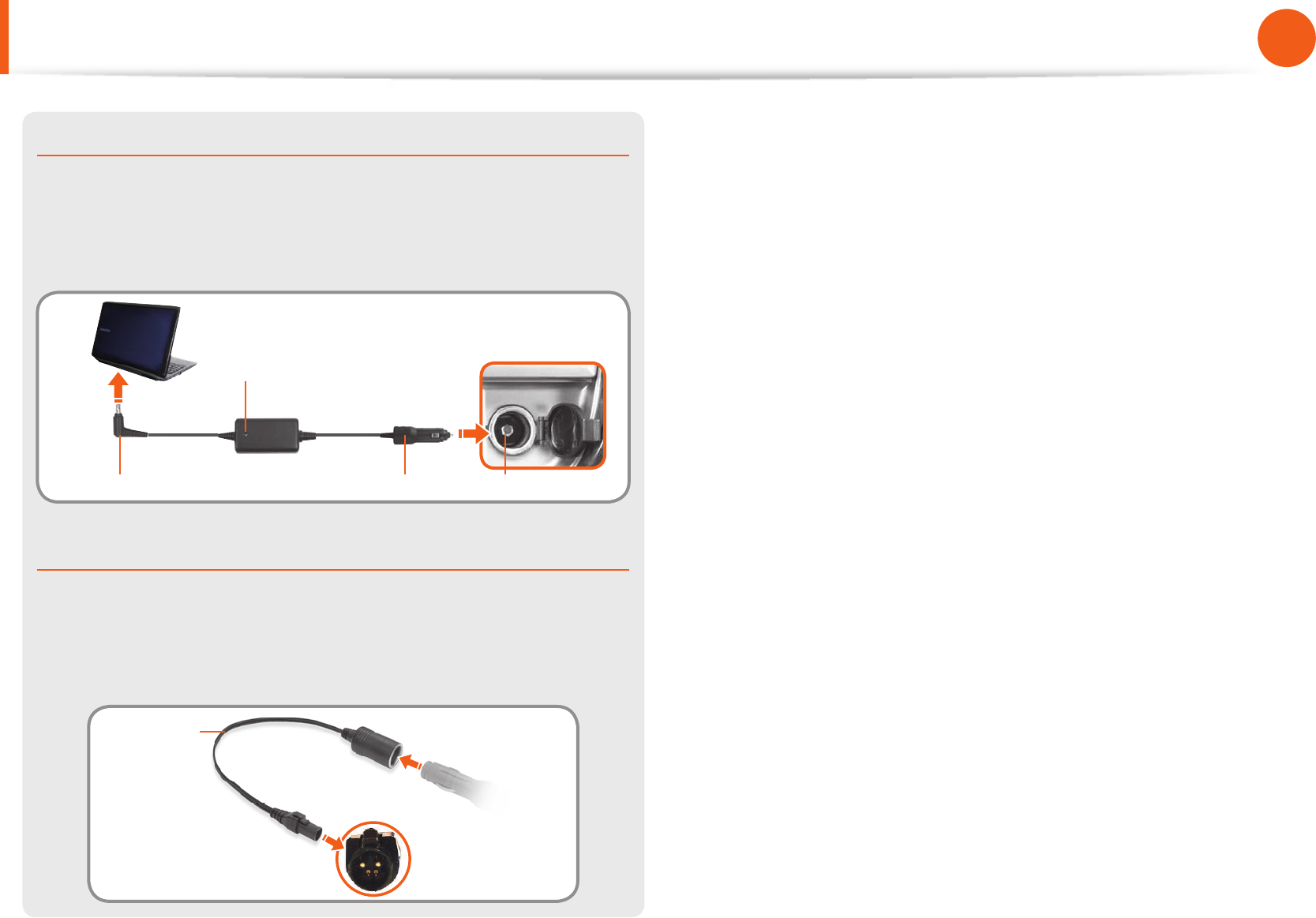
20
Chapter 1.
Getting Started
Safety Precautions
When using the auto adapter
When the cigar socket is provided, you have to use the auto
adapter (optional). Insert the cigar plug of the auto adapter into
the cigar socket and connect the DC plug of the auto adapter to
the power input port of the computer.
Auto Adapter
In- ight Cigar SocketCigar PlugDC Plug
When using the Airplane Charging Converter
Depending on the airplane, you have to use the auto adapter
and charging converter. Connect the airplane charging converter
(optional) to the auto adapter (optional) and then insert the
airplane power input jack into the power outlet.
Charging
Converter 1Connect this end to
the auto adapter.
Connect the airplane power
input jack to the power
outlet of the airplane.
2
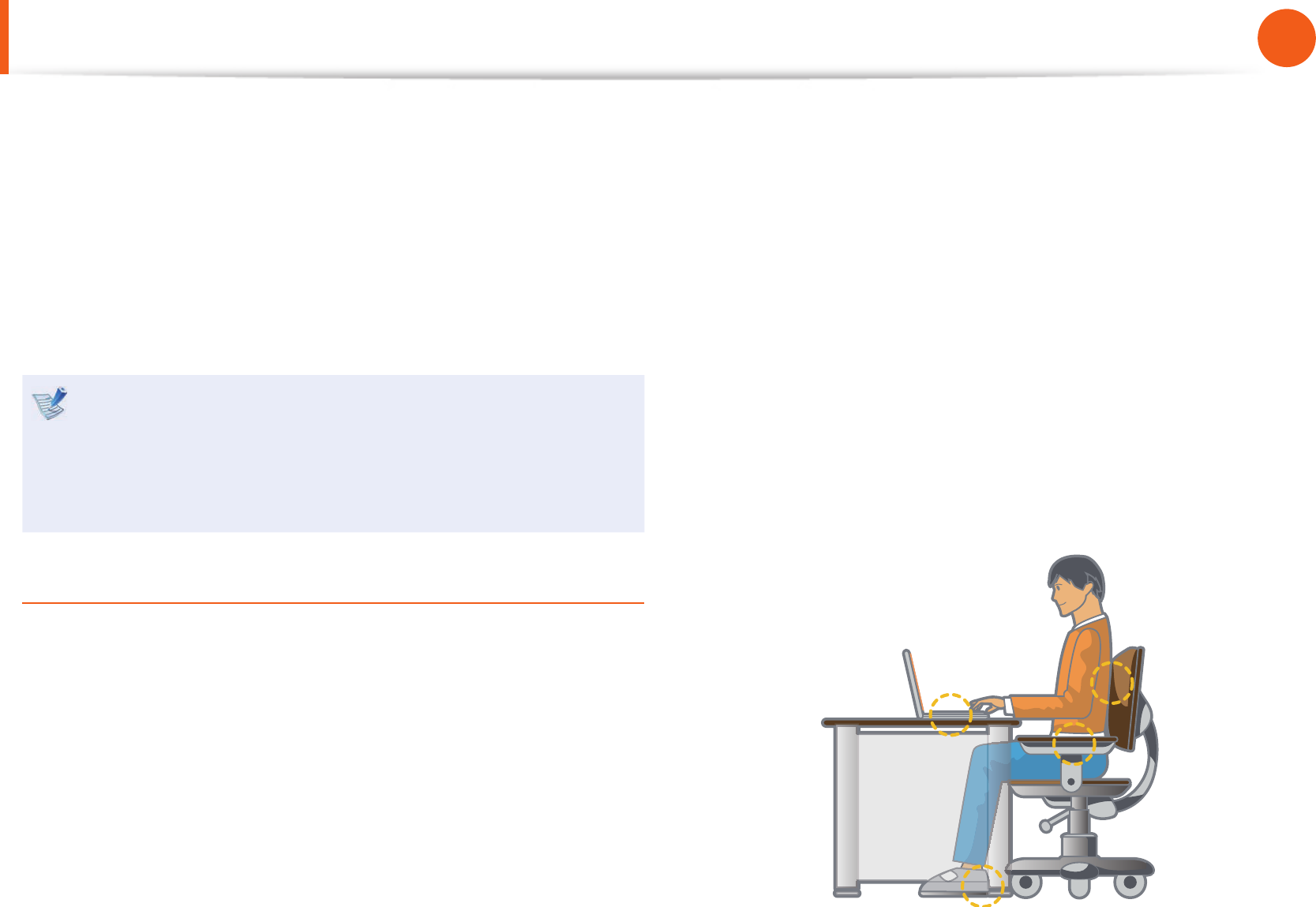
20
21
Chapter 1.
Getting Started
Proper Posture During Computer Use
Maintaining a proper posture during computer use is very
important to prevent physical harm.
The following instructions are about maintaining a proper posture
during computer use developed through human engineering.
Please read and follow them carefully when using the computer.
Otherwise, the probability of (RSI: Repetitive Strain Injury) from
repeated operations may increase and serious physical harm may
be caused.
The instructions in this manual have been prepared so that •
they can be applied within the coverage of general users.
If the user is not included in the coverage, the •
recommendation is to be applied according to the user’s
needs.
Proper Posture
Adjust the heights of desks and chairs appropriate to your
height.
The heights are to be adjusted so that your arm forms a right
angle when you place your hand over the keyboard while sitting
down on a chair.
Adjust the height of chair so that your heel is comfortably placed
on the oor.
Do not use the computer while you are lying down, but only •
while you are sitting down.
Do not use the computer on your lap. If the computer •
temperature increases, there is a danger of burning yourself.
Work while keeping your waist straight.•
Use a chair with a comfortable back.•
Keep the center of your leg weight not on the chair but on •
your feet when you are sitting on a chair.
To use the computer while talking over the telephone, use a •
headset. Using the computer with the phone on your shoulder
is bad for posture.
Keep frequently used items within a comfortable work range •
(where you can reach them with your hands).
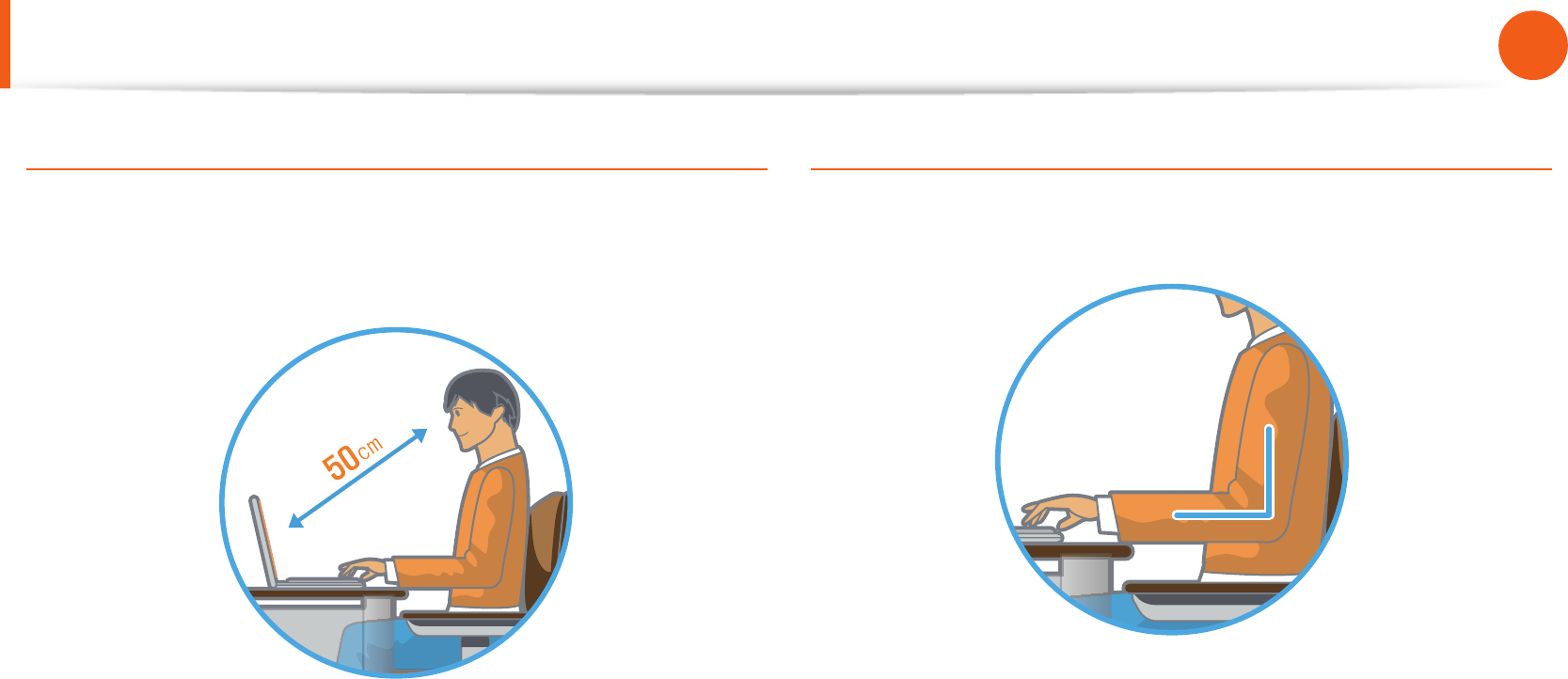
22
Chapter 1.
Getting Started
Proper Posture During Computer Use
Eye Position
Keep the monitor or LCD away from your eyes by at least
50cm.
Adjust the height of the monitor and the LCD screen so that its •
top height is equal to or lower than your eyes.
Avoid setting the monitor and LCD excessively bright.•
Keep the monitor and LCD screen clean.•
If you wear glasses, clean them before using the computer.•
When entering contents printed on a paper into the computer, •
use a static paper holder so that the height of the paper is
almost equal to that of the monitor.
Hand Position
Keep your arm at a right angle as shown by the gure.
Keep the line from your elbow to your hand straight.•
Do not place your palm over the keyboard while typing.•
Do not hold the mouse with excessive force.•
Do not press the keyboard, touchpad or mouse with excessive •
force.
It is recommended connecting an external keyboard and •
mouse when using the computer for long periods of time.
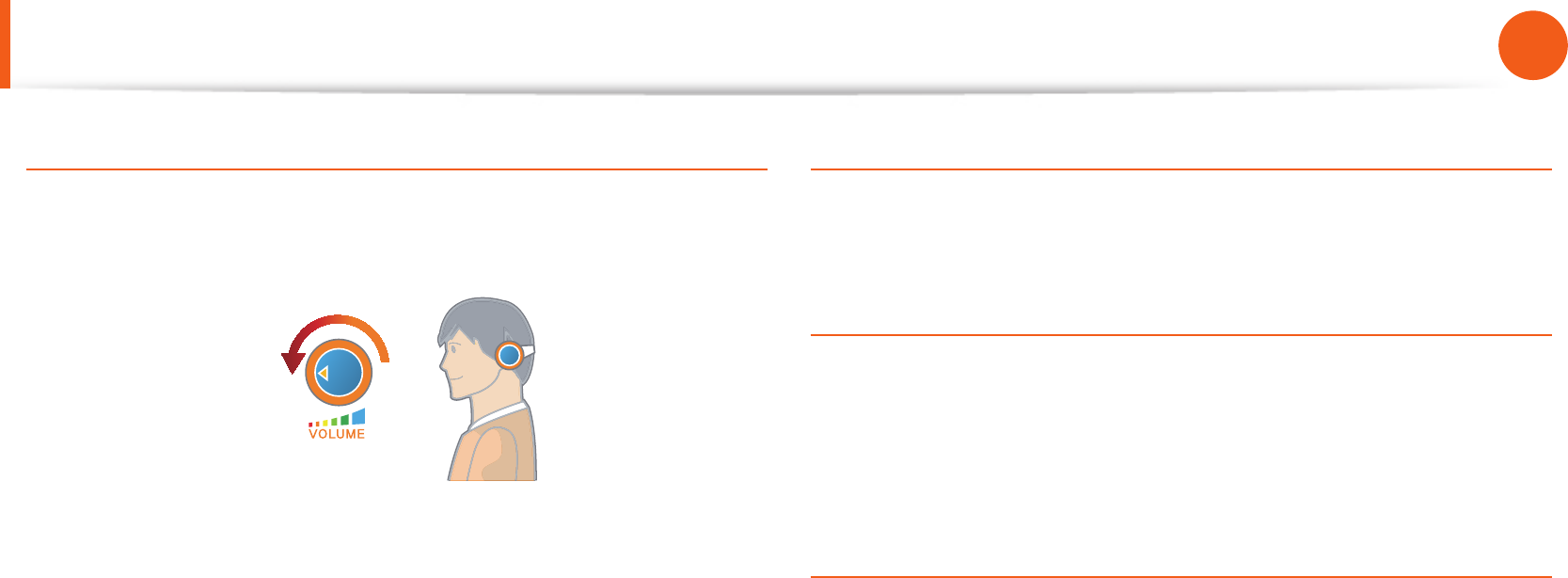
22
23
Chapter 1.
Getting Started
Proper Posture During Computer Use
Volume Control (Headphones and Speakers)
Check your volume rst to listen to music.
Check your
volume!
Check if the volume is too loud before using headphones.•
It is not recommended using headphones for long periods of •
time.
Any deviation from the equalizer default setting could cause •
hearing impairment.
The default setting can be changed through software and •
driver updates without your intervention. Please check the
equalizer default setting before rst usage.
Use Time (Break Time)
Take a break for 10 minutes or more after a 50-minute period •
when working for more than one hour.
Illumination
Do not use the computer in dark locations. The illumination •
level for computer use must be as bright so for reading a book.
Indirect illumination is recommended. Use a curtain to prevent •
re ection on the LCD screen.
Operation Condition
Do not use the computer in hot and humid locations.•
Use the computer within the allowed temperature and •
humidity range speci ed in the User Guide.
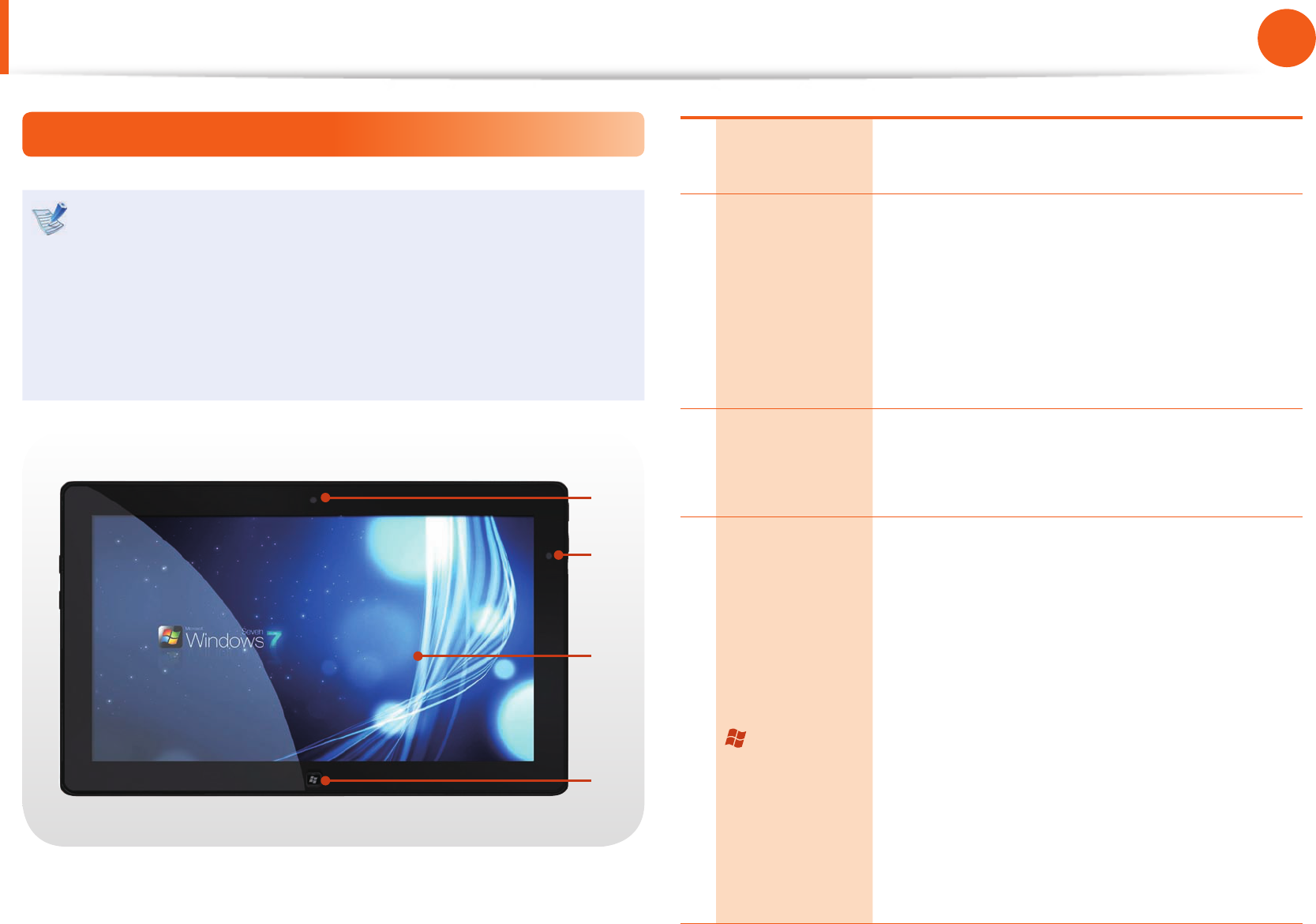
24
Chapter 1.
Getting Started
Overview
Front View
The pictures used for the cover and the main body in the •
User Manual are those of the representative model of each
series. Therefore the colors and appearance of the pictures
may di er from the actual appearance of the product
depending on the model.
The actual color and appearance of the computer may •
di er from the pictures used in this guide.
1
3
2
4
1Camera
(Optional)
Using this camera, you can take still pictures
and record video.
2Illumination
Sensor
This sensor detects the ambient illumination
around the PC.
If the ambient illumination decreases,
the touch screen brightness is set to low.
Conversely, if the ambient illumination
increases, the touch screen brightness is set to
high.
3Touch Screen
The screen images are displayed here.
This works as a touch screen in models that
support touch screens (Optional).
4Home button
You can switch to Windows Desktop mode or
touch mode.
Press the button once:• Shows the
Windows Desktop screen.
Press and hold the button once for a •
short while: Launches the Touch Launcher.
Press the button twice:• Performs the
function of pressing the windows and tab
key combination.
Press and hold the button for 4 seconds •
+ press the power button: Performs the
function of pressing the ctrl + alt + del key
combination.
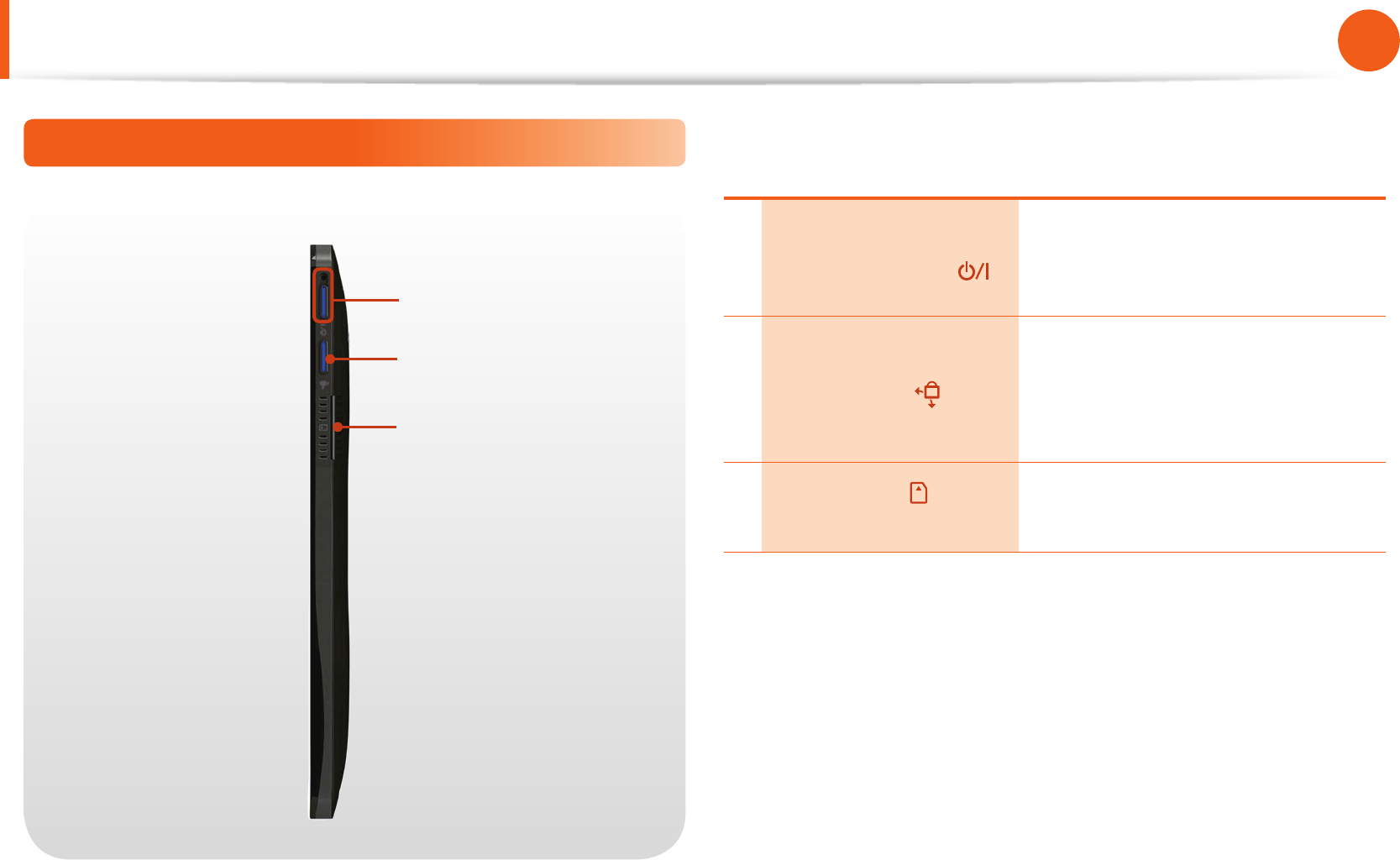
24
25
Chapter 1.
Getting Started
Overview
Right View
3
2
1
1Power Button /
Power Button LED
Turns the computer on and o.
When the computer is on, the power
button LED is lit.
2Rotation Lock
Locks the screen rotation so that the
screen does not automatically rotate
according to the orientation function
of the product.
3SIM Card Slot
(Optional) This slot is for SIM cards.
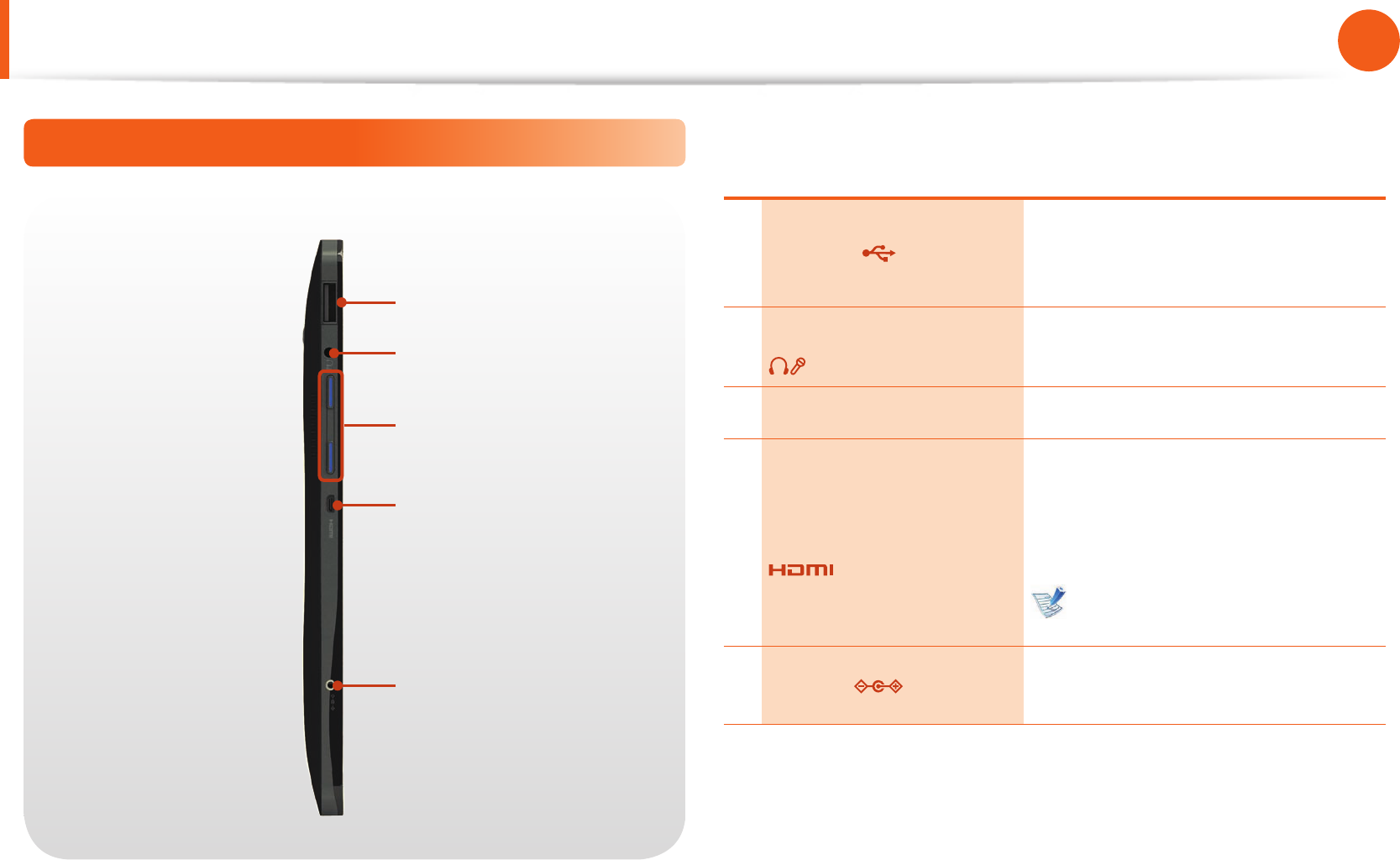
26
Chapter 1.
Getting Started
Overview
Left View
2
1
3
4
5
1USB Port
You can connect USB devices to the
USB port such as a keyboard/mouse,
digital camera, etc.
2Ear-set / headset Jack
This is the jack for connecting an ear-
set or headset.
3Volume Control Button Controls the volume.
4
Micro Digital Video /
Audio Port (Micro HDMI)
(Optional)
This is the port for a micro HDMI.
You can enjoy digital video and
audio by connecting the computer
to a TV.
You can connect a VGA adapter
(optional).
5DC Jack A jack to connect the AC adapter
that supplies power to the computer.
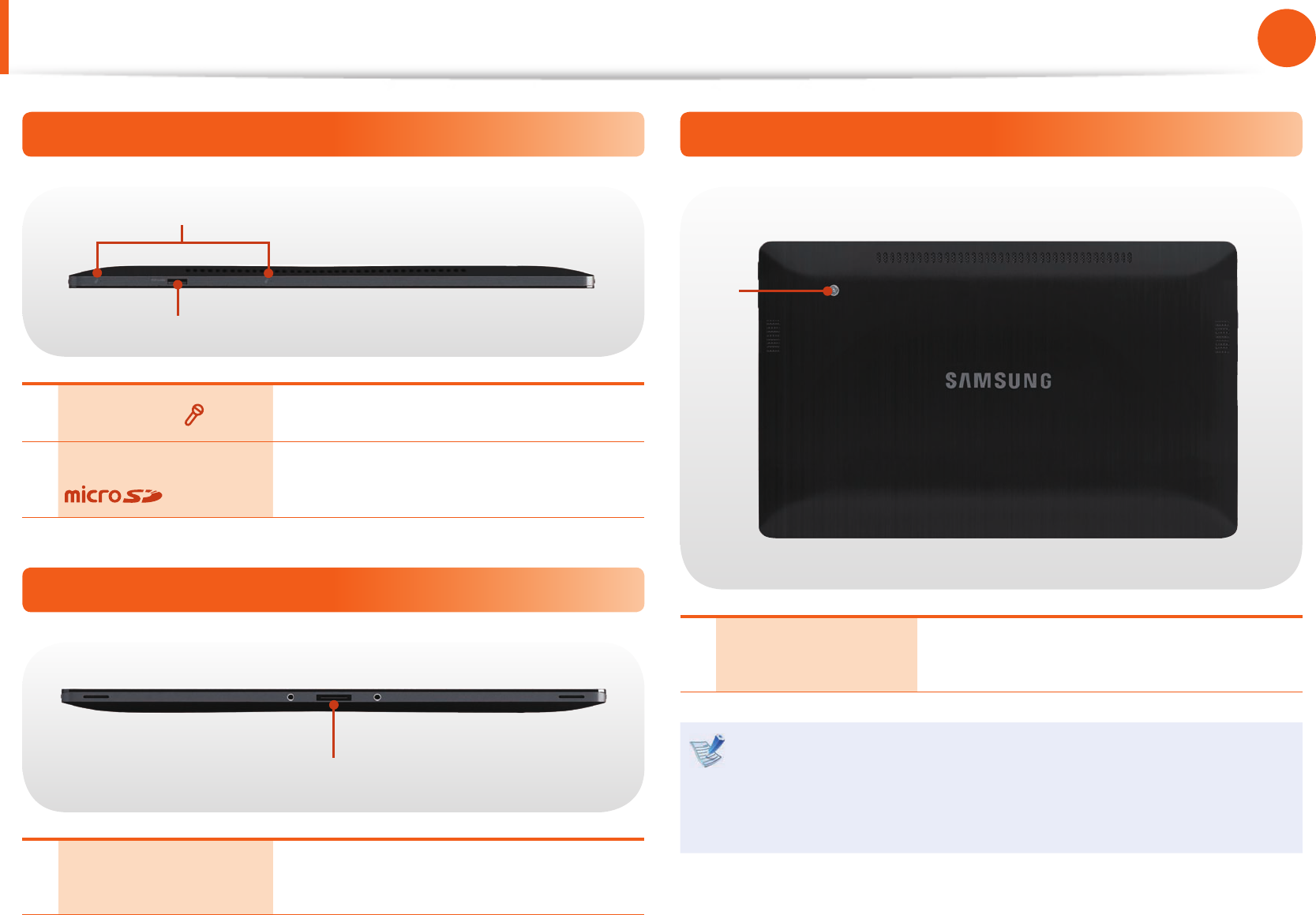
26
27
Chapter 1.
Getting Started
Top View
1
2
1Microphone You can use the built-in microphone.
2Micro SD Card Slot
(Optional) This slot is for micro SD cards.
Bottom View
1
1Slate PC Dock Port
(Optional)
This port is for external devices (Slate
PC Dock (optional)).
Rear View
1
1Camera (Optional) Using this camera, you can take still
pictures and record video.
If you replace the bottom of the product, the model name,
serial number and some logos etched into the bottom of the
product will no longer be there.
For more information, talk to a service engineer.
Overview
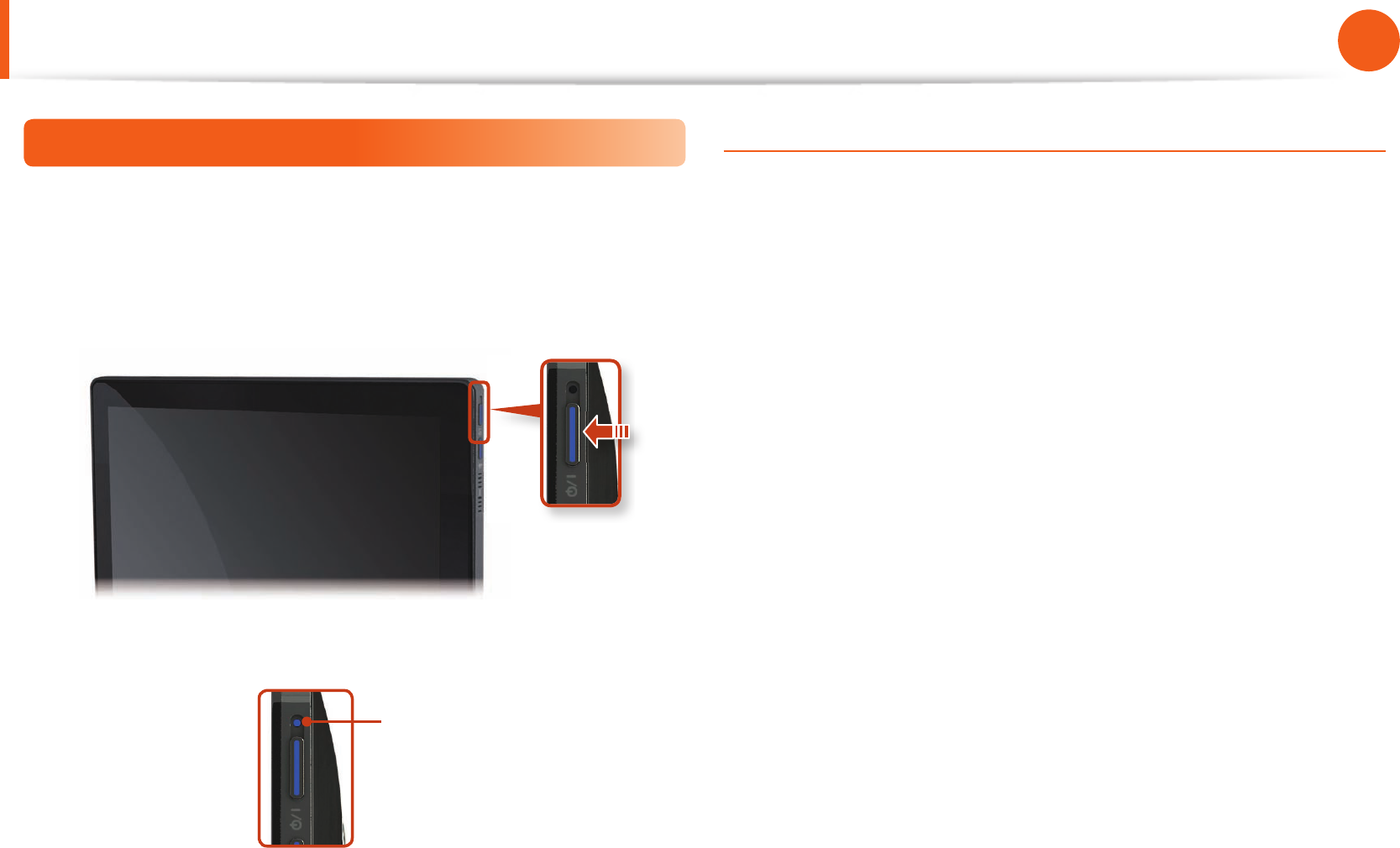
28
Chapter 1.
Getting Started
Turning the Computer On and O
Turning the computer on
1 Connect the AC adapter.
2 Press the Power button to turn the computer on.
3 Power button LED is lit while the computer is turned on.
LED
Entering Sleep mode
When the computer is turned on, press the computer’s power
button once brie y.
If the computer enters power-saving mode, the power button
LED blinks blue.
To wake the computer up, brie y press the Power button of the
computer again.
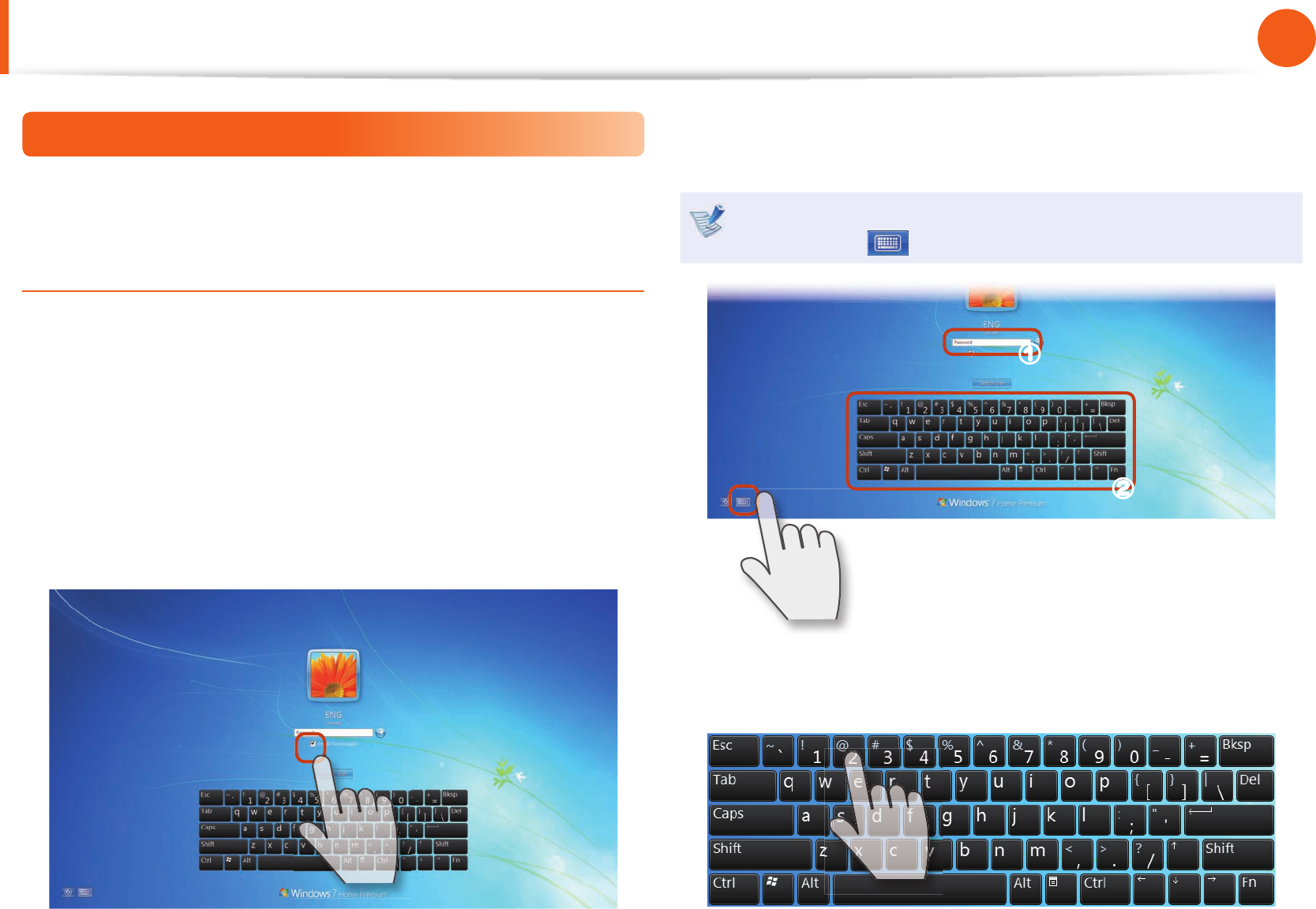
28
29
Chapter 1.
Getting Started
Using the Touch Logon function
Using the Touch Logon program, you can easily log on using your
ngers.
Con guring the Touch Logon
To use the Touch Logon function, you have to con gure the Touch
Logon function in the Windows logon screen.
1 Press the power button to turn the computer on.
2 If the Windows logon screen appears, select the account for
which you will con gure the Touch Logon function and check
the Enable Touch Logon option.
3 If you touch the Windows logon password, the Tablet PC
input panel appears.
If the Tablet PC input panel does not appear, press the
keyboard icon at the bottom left of the screen.
z
x
4 Touch the corresponding buttons in the Tablet PC input panel
to enter the Windows password.
Turning the Computer On and O
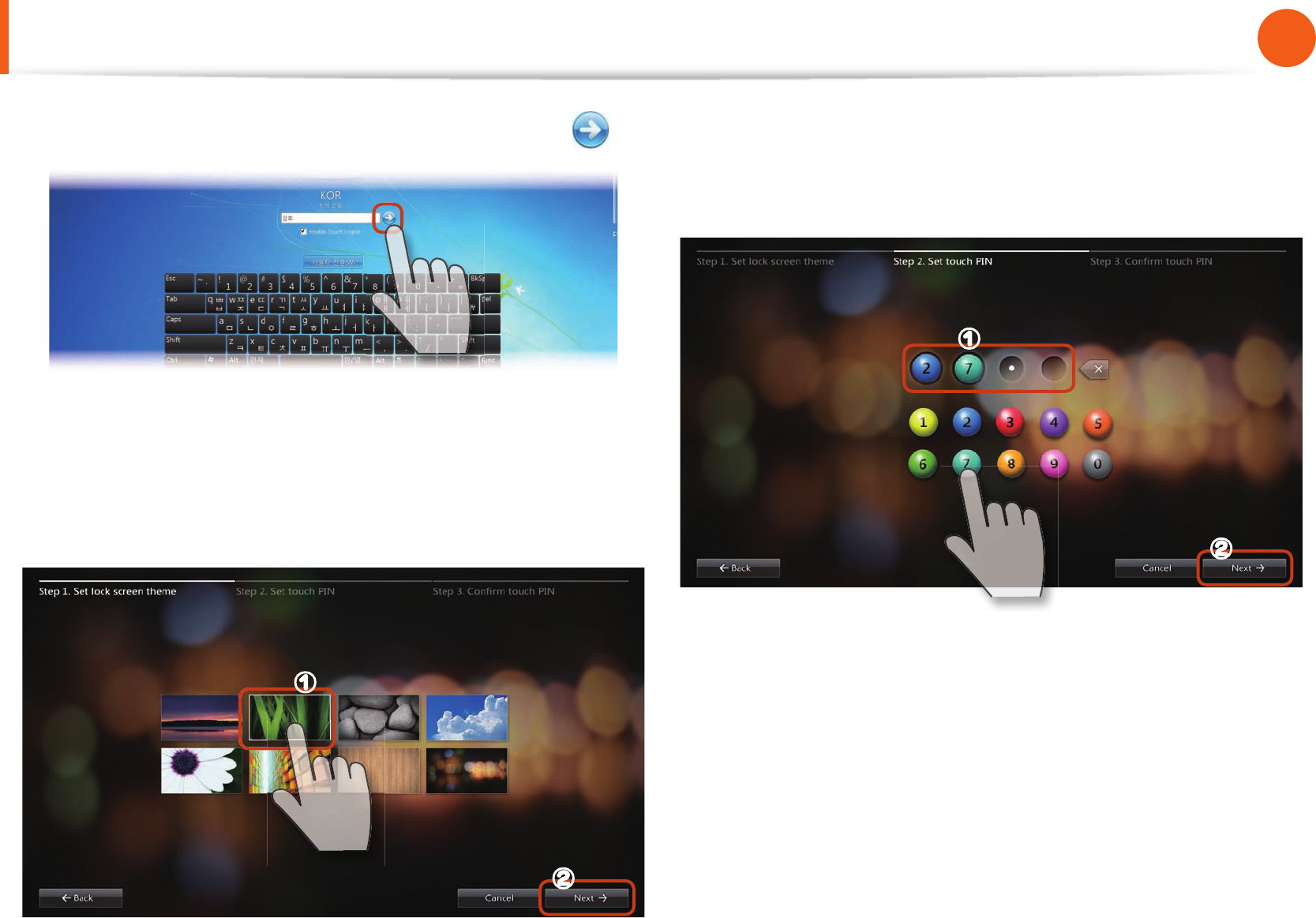
30
Chapter 1.
Getting Started
5 When you have nished entering the password, press .
Start con guring the Touch Logon settings.
6 Select a Touch Logon background screen.
Select a background screen by touching it and then touch
Next.
z
x
7 Set the Touch Logon password.
Touch the 4 digits to be used as the password.
When you have nished entering the password, press Next.
z
x
8 Re-enter the Touch Logon password.
Touch the password digits again.
When you have nished entering the password, press Next.
9 The Touch Logon setting has been completed. You can now
use the Touch Logon function when you logon next.
Turning the Computer On and O
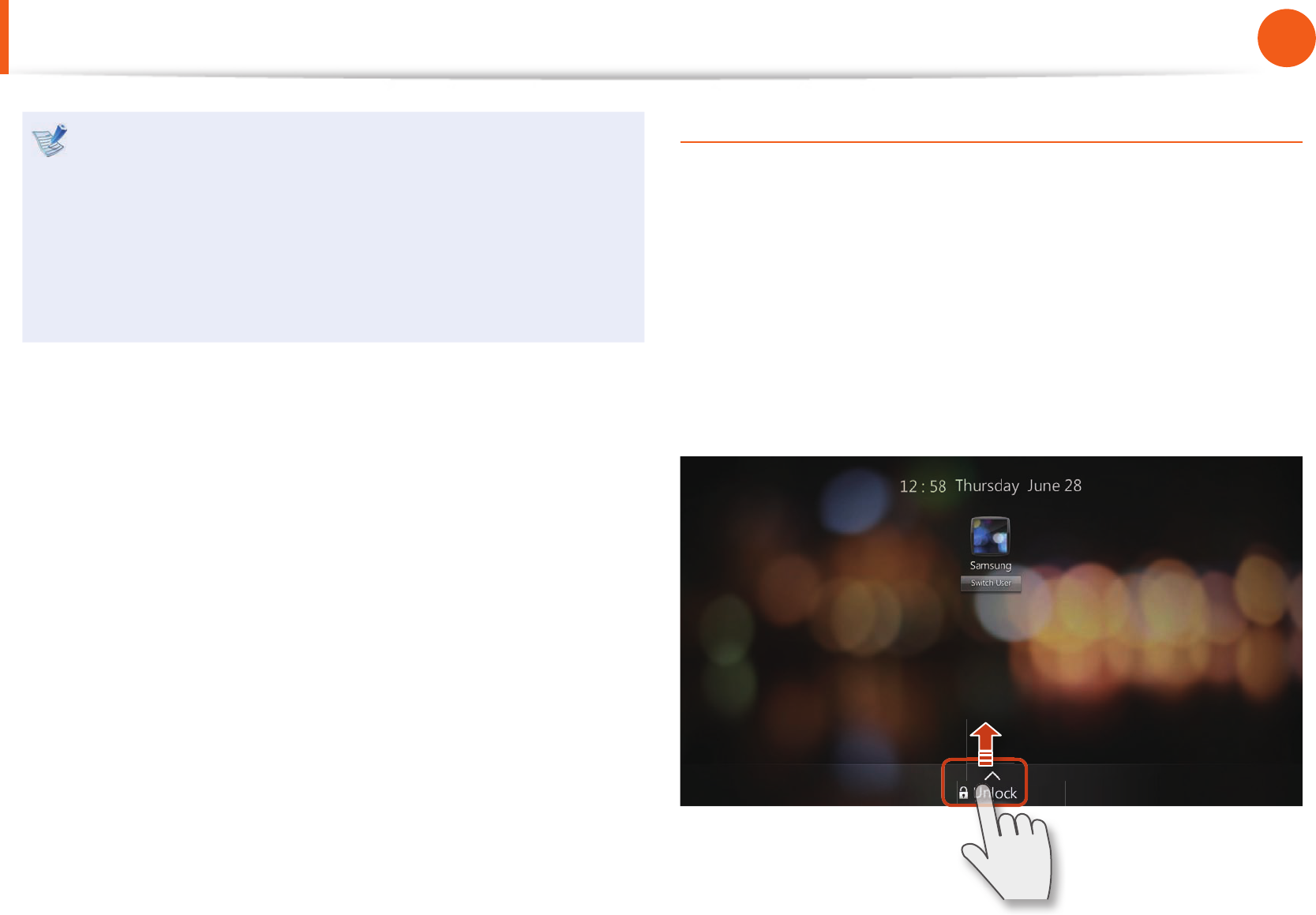
30
31
Chapter 1.
Getting Started
When you do not have a Windows account password
1. Click Start > All Programs > Samsung > Touch Logon >
Touch Logon Options.
2. Select the Enable Touch Logon item and click OK.
3. Select a background for the touch logon function by
touching the background of your choice and click Next.
The touch logon settings have been completed.
Using the Touch Logon
Logging on to the Windows logon screen by touch
1 Press the power button to turn the computer on.
2 If the Windows logon screen appears, press the account
which you want to log into by touch.
3 Touch Unlock at the bottom of the screen and then drag it to
the top of the screen.
Turning the Computer On and O
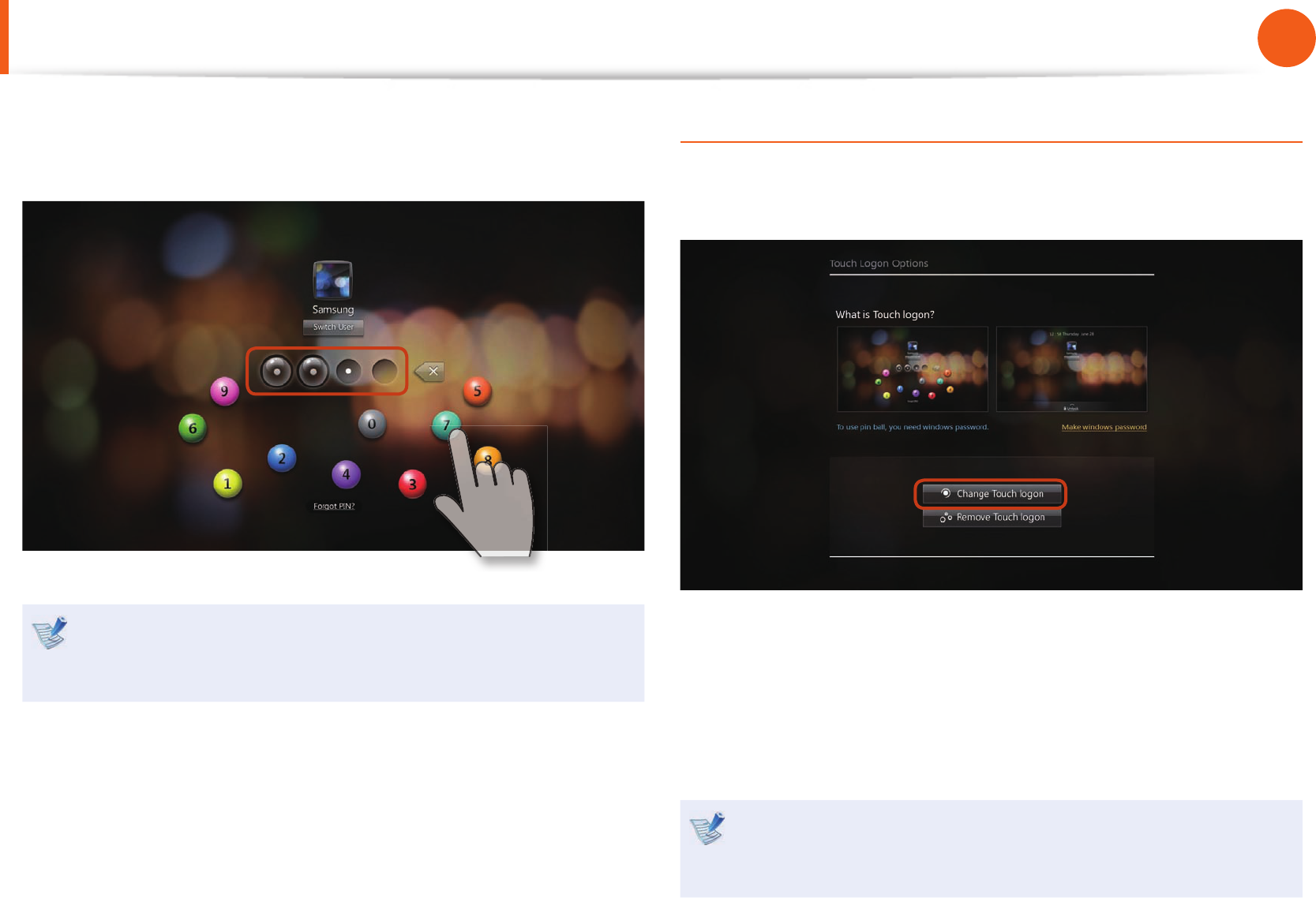
32
Chapter 1.
Getting Started
4 Touch the Touch Logon password and sequentially drag them
to the Touch Logon input eld.
If there is no con gured Windows account password, it is
immediately Unlocked without requiring you to enter a
password.
Disabling/changing the Touch Logon function
Using the Touch Logon Options, you can enable, disable and
con gure the Touch Logon function.
1 Click Start > All Programs > Samsung > Touch Logon >
Touch Logon Options.
2 After launching the Touch Logon Options, you can
con gure, disable or change the Touch Logon function.
If you register, remove or change the Windows password in
the User Accounts item in the Control Panel, the Touch Logon
function is disabled.
Turning the Computer On and O
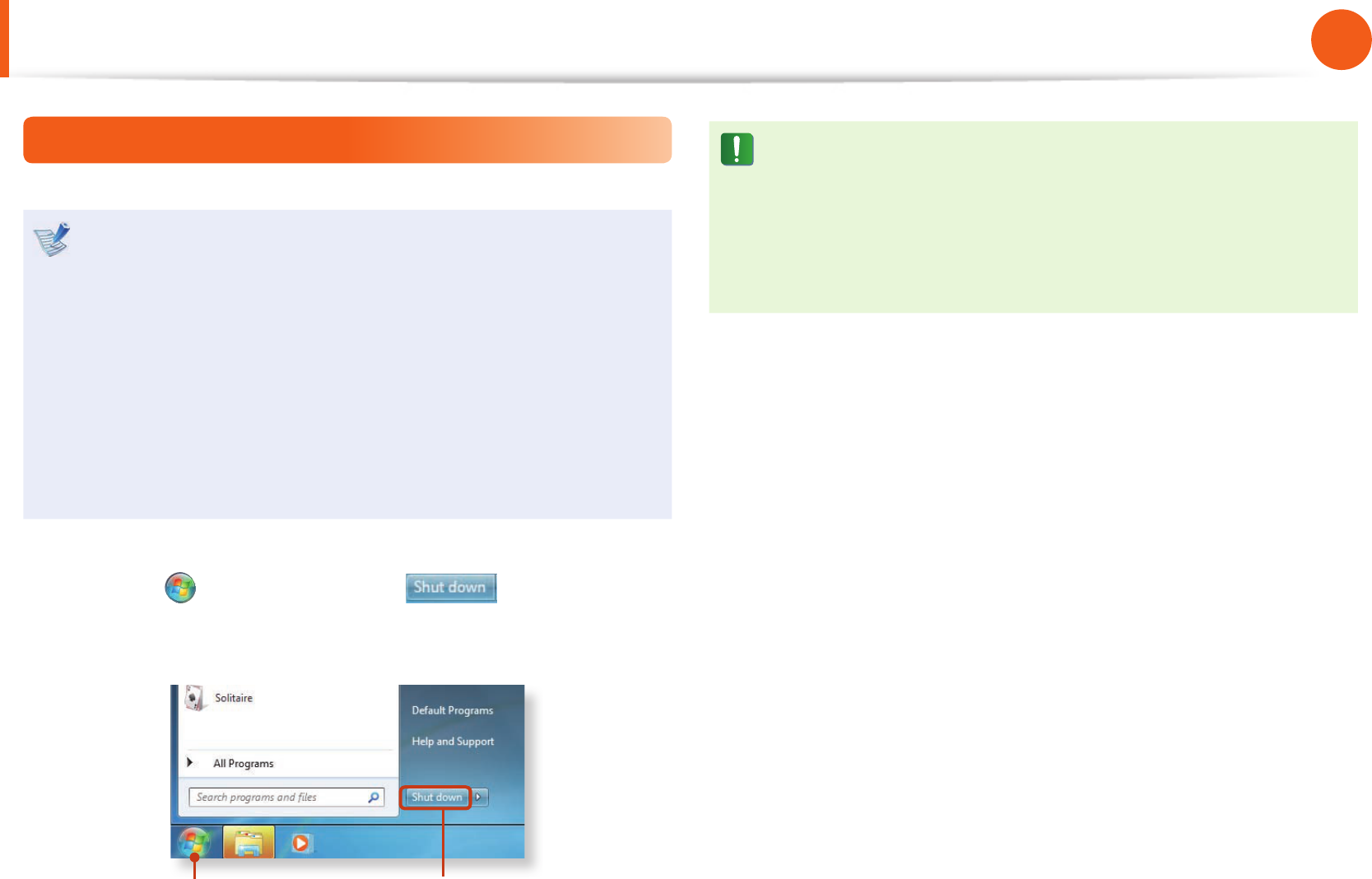
32
33
Chapter 1.
Getting Started
Turning the computer o
Since the procedures to turn the computer o may di er •
depending on the installed operating system, please turn
the computer o according to the procedures for the
purchased operating system.
Save all your data before clicking on • Shut down.
These descriptions are written based on Windows 7, the •
latest operating system. Therefore, some descriptions and
gures may di er from your operating system. But as the
usage is similar to other Windows operating systems, you
can use these descriptions for reference.
Click Start > Shut down mode to shutdown the
computer.
1 2
If the computer cannot be shut down due to a system error,
press and hold the power button for at least 4 seconds to
shut it down by force.
Please note that the system diagnosis program may run when
you turn the computer on after you have shut the computer
down by holding the power button down.
Turning the Computer On and O

Using the Touch Screen
(For Windows 7 touch screen models only) 35
Entering Letters Using the Touch Screen
(For Windows 7 touch screen models only) 41
Using the Touch Launcher
(For Windows 7 touch screen models only) 43
Using the Touch Supporter
(For Windows 7 touch screen models only) 44
Using the camera 46
Keyboard (Optional) 48
Micro SD Card Slot (Optional) 50
Connecting an External Display Device 52
Connecting an External Digital Device 57
Adjusting the Volume 58
Wired Network (Optional) 60
Wireless Network (Optional) 63
Using the Slate PC Dock (Optional) 67
Chapter 2.
Using the computer
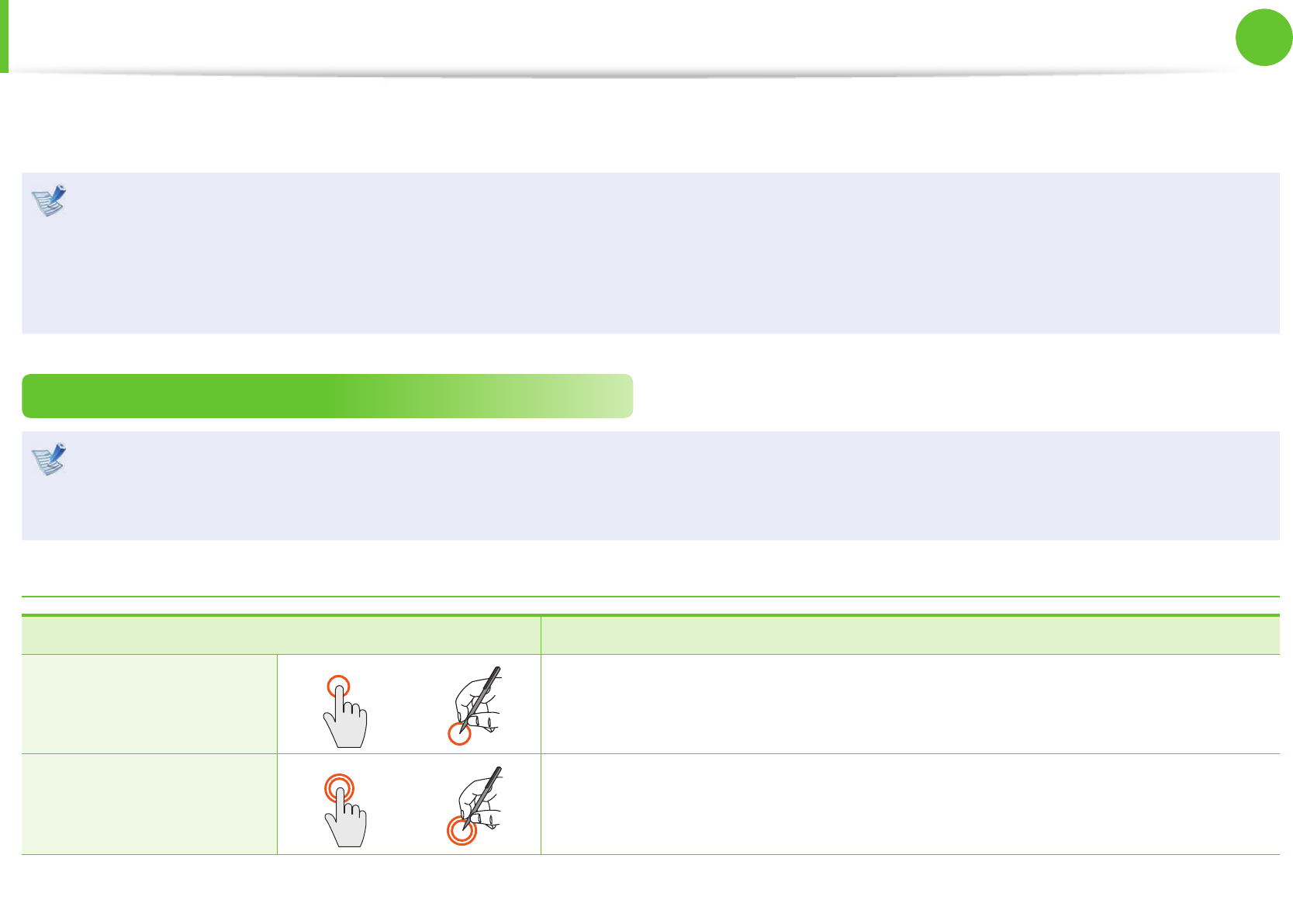
35
Chapter 2.
Using the computer
You can use the computer using the touch screen only, without using the keyboard and mouse.
The touch screen function is only supported for models which have the function installed at the factory.
Use only your ngers for the touchscreen. Other tools such as a ballpoint pen are not recognized and using sharp objects may •
damage or scratch the surface of the LCD.
If a digitizer pen (optional) is provided, you can use the digitizer pen instead.•
Since touching the touch screen with a conductive material such as a metallic object may cause a malfunction, take care not to •
touch the screen with this kind of object.
Using the Touch Screen
This function is provided by touch screen models running Windows 7 and will only work for some applications.•
In addition, note that the supported functions are dependant on the application.•
You can use the digitizer pen (optional) as you use your ngers. The descriptions here are for using your ngers.•
Learning basic touch screen operations
Touch Operation Function
Single-tap (click) To select an item, tap over the item with your nger. This is the same as left-
clicking once with a mouse.
Double-tap
(double-click)
To run an item, quickly tap the item twice with your nger. This is the same as
double-clicking once.
Using the Touch Screen (For Windows 7 touch screen models only)
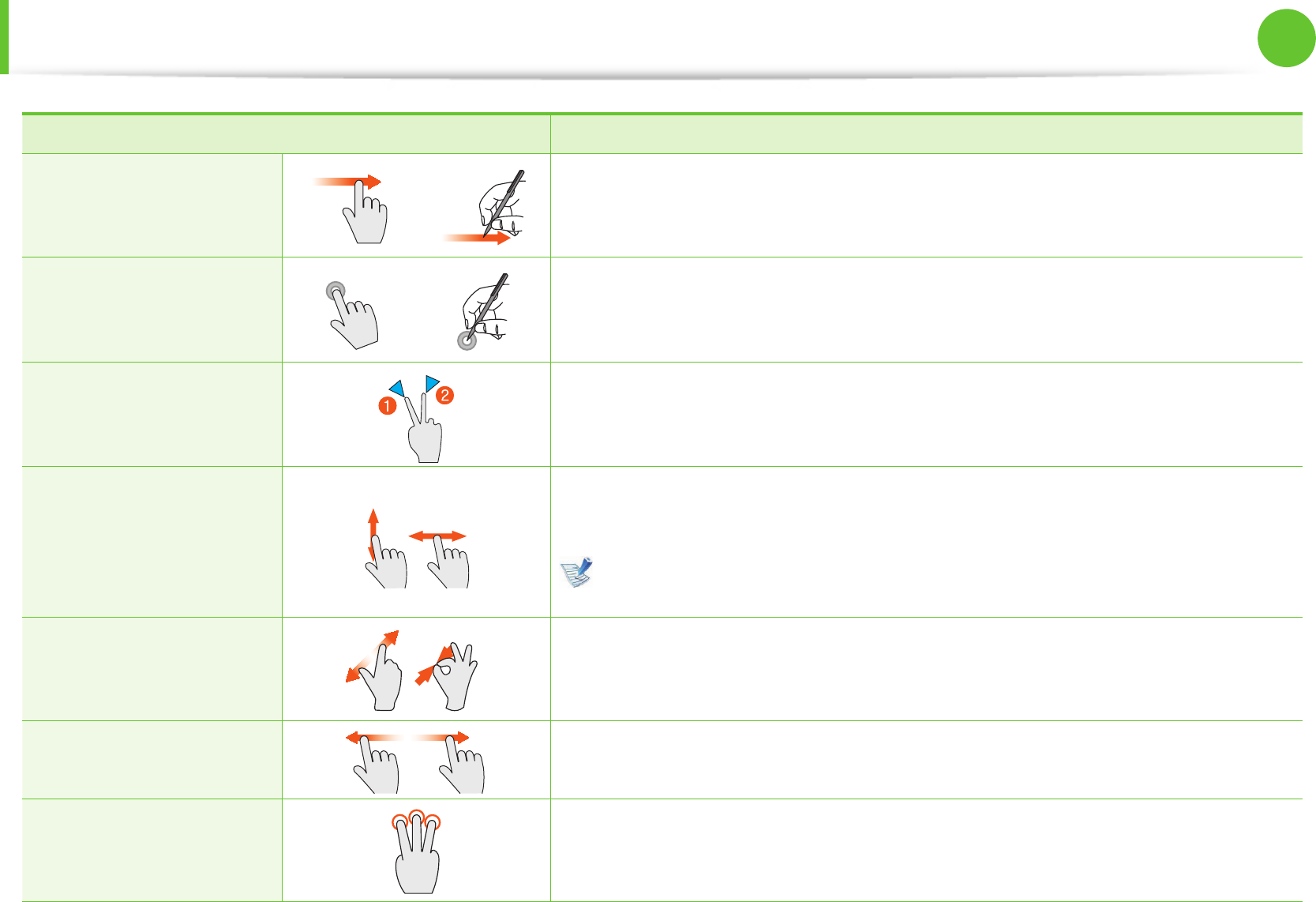
36
Chapter 2.
Using the computer
Using the Touch Screen (For Windows 7 touch screen models only)
Touch Operation Function
Moving (drag) To drag an item, place your nger over the item and drag it to the new location.
This is the same as dragging using a mouse.
Press and take off
(mouse right-click)
If you press and hold the screen for approximately 3 seconds, the pop-up menu
appears. This is the same as right-clicking with the mouse.
Tapping two fi ngers in
succession
(mouse right-click)
Tap with one nger and then tap with another nger while holding down the
rst nger. A pop-up menu appears.
This is equivalent to right-clicking a mouse.
Moving fi nger
(scroll)
Move your nger up and down, left or right to move on the screen accordingly.
This is the scroll function of the mouse.
This operation may perform a di erent function depending on the
application program.
Drag two fi ngers apart /
together
(zoom-in/zoom-out)
Drag apart or together two ngers to zoom-in or -out of a picture or image.
Flick one fi nger fast Flick one nger quickly to the left or right in order to move to the previous or
next page.
Tapping three fi ngers
(Launching the Touch
Supporter)
Tapping three ngers simultaneously launches the touch support program.
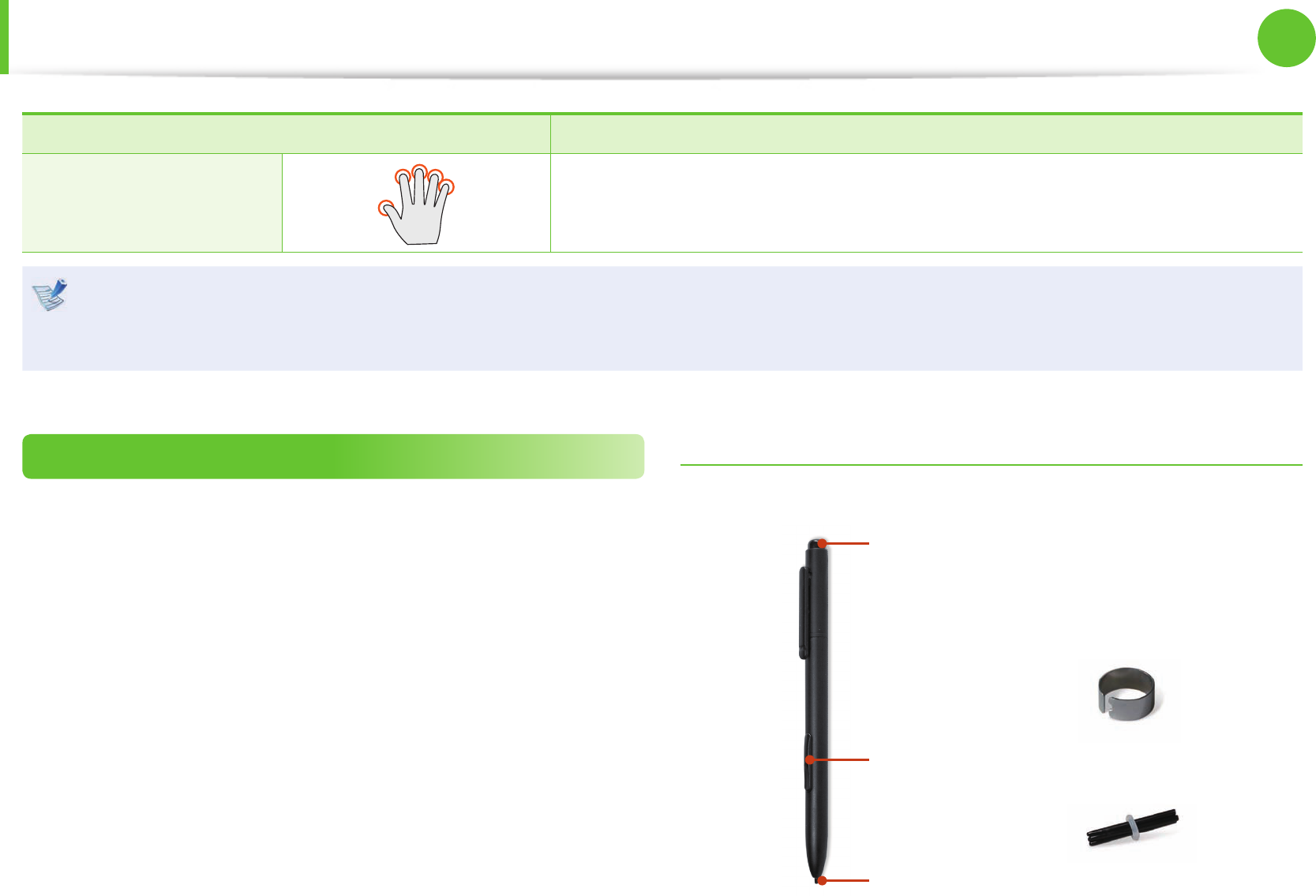
36
37
Chapter 2.
Using the computer
Touch Operation Function
Tapping fi ve fi ngers
(Launching the keyboard
program)
Tapping ve ngers simultaneously launches the keyboard program.
Learning about touch operations
Select Start > Control Panel > Hardware and Sound > Pen and Touch > Flicks tab and select Practice using icks to learn about
the various touch operations.
Using the Touch Screen (For Windows 7 touch screen models only)
Using the digitizer pen (optional)
If a digitizer pen is supplied with the product, you can operate the
computer with the pen instead of your ngers.
You can use the digitizer pen as you would use your ngers.
Digitizer pen structure and functions
Pen eraser
Pen button
Pen tip Pen tip
Ring
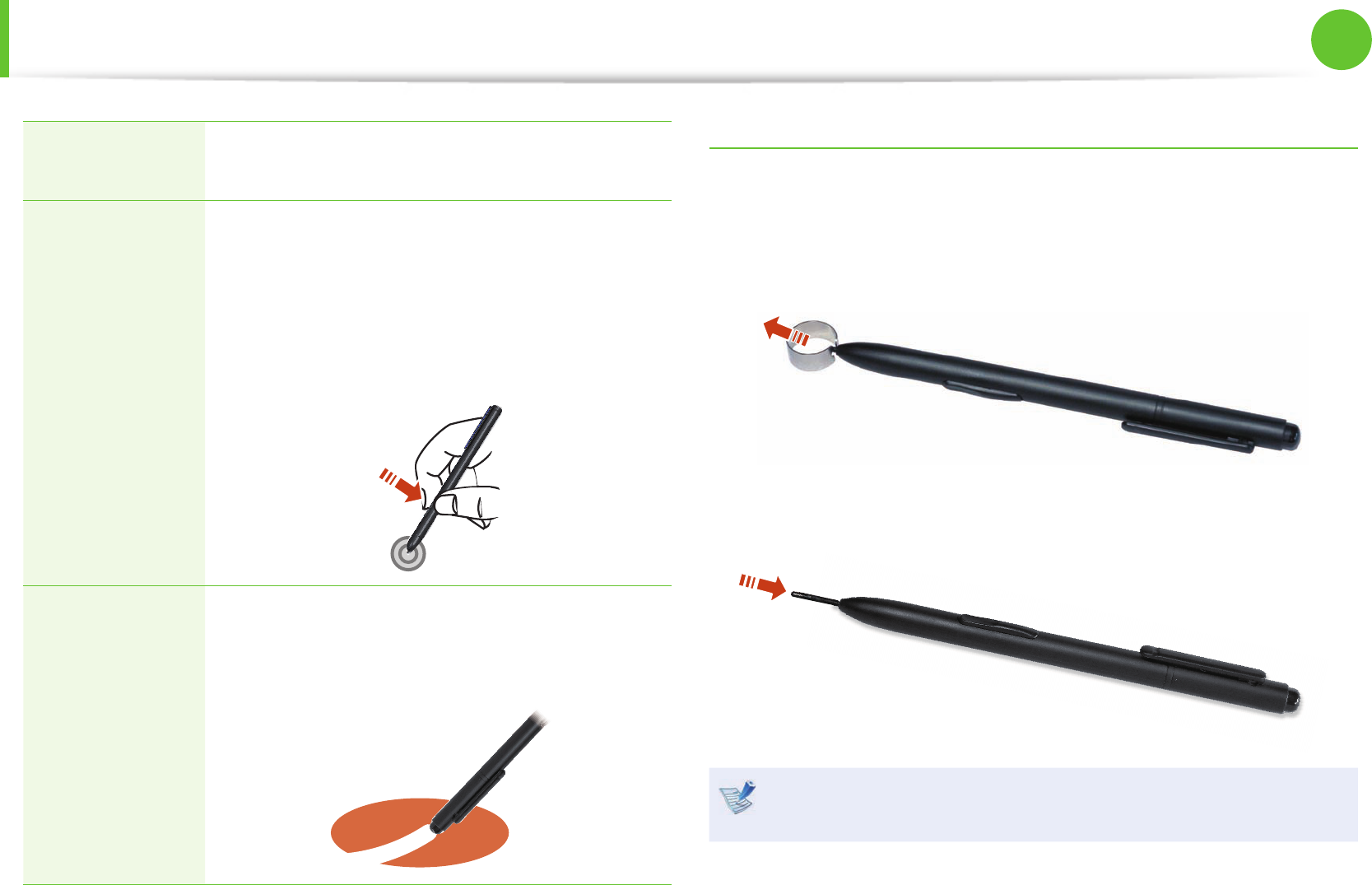
38
Chapter 2.
Using the computer
Using the Touch Screen (For Windows 7 touch screen models only)
Pen tip This performs the function of your nger tip
when you touch the screen.
Pen button
If you press the pen button when the digitizer
pen tip is on the screen, circles appear around
the pointer on the screen. Touch the screen with
the digitizer pen while holding down the pen
button.
This performs the right-click function.
Pen eraser
Erases letters with the top end of the digitizer
Pen.
This performs the function of an eraser.
Replacing the pen tip
If the pen tip is damaged, you can replace the pen tip as follows:
1 Hold the pen tip by inserting it into the hole of the ring and
remove the tip by pulling it out.
2 Insert the new pen tip into the digitizer pen.
Take care so that the pen tip does not spring out when taking
it out.
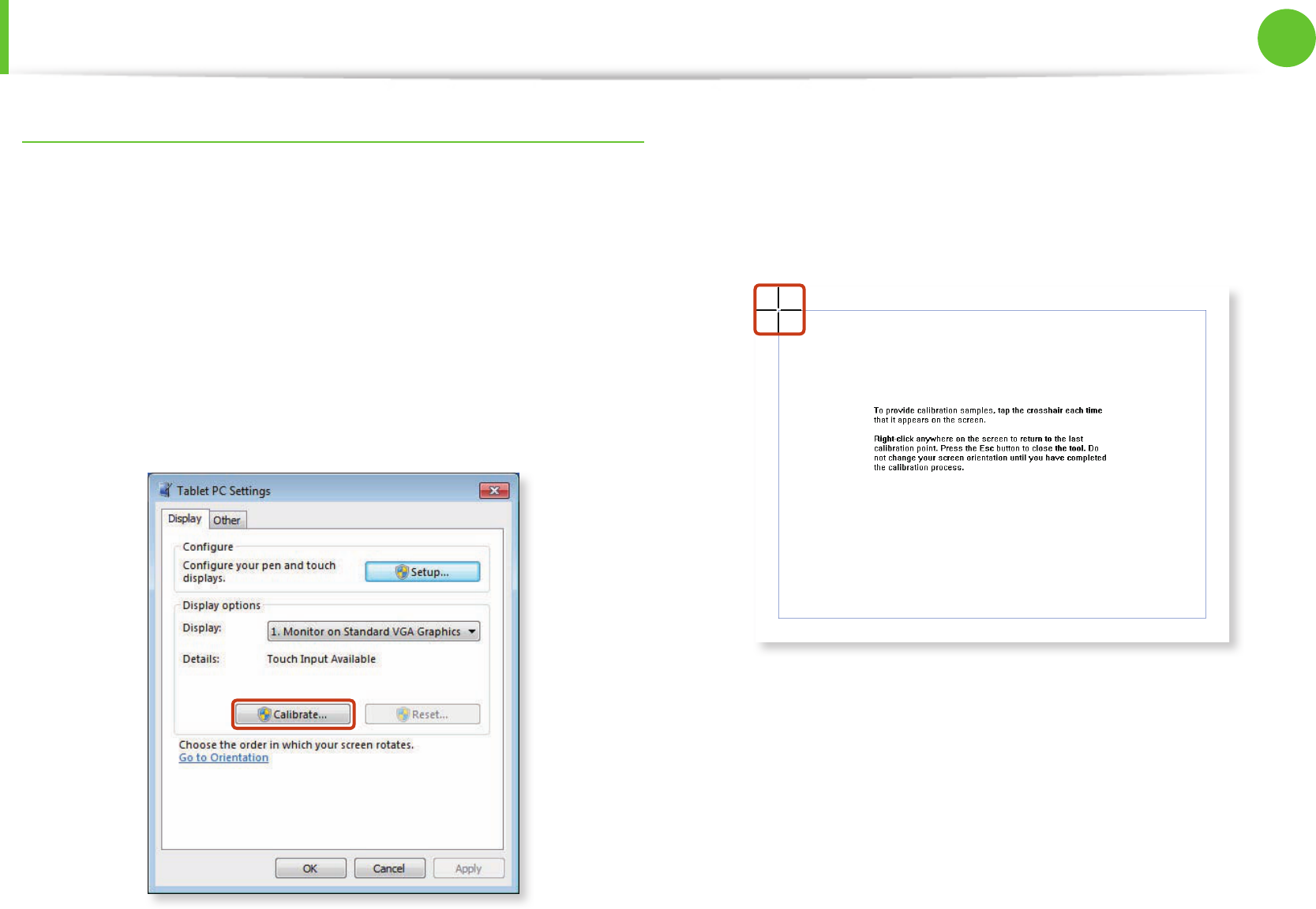
38
39
Chapter 2.
Using the computer
Using the Touch Screen (For Windows 7 touch screen models only)
Screen Calibration
When you use the touch screen for the rst time or the pointer
on the screen does not precisely match the points you touch,
calibrate the touch screen using the Tablet PC Settings menu.
The calibration process for the touch screen may di er depending
on the operating system and may not be available in some
operating systems. The following descriptions assume the
Windows 7 operating system.
1 Click Start > Control Panel > Hardware and Sound >
Tablet PC Settings > Display > Calibrate.
2 Select the screen type to calibrate. If the Calibration screen
appears, touch the point represented by the “+” mark and
then remove your nger.
The “+” mark appears sequentially from the top left to the
bottom right of the screen.
3 When the Do you want to save the calibration data?
window appears, click Yes.
The touch screen input points are calibrated.

40
Chapter 2.
Using the computer
Using the Touch Screen (For Windows 7 touch screen models only)
Touch screen use precautions
Use the touch screen with clean and dry hands. In a humid •
environment, remove the moisture from your hands and the
touch screen surface before use.
Avoid directly spraying liquid cleansing solution onto the touch •
screen. The liquid solution may enter the touch screen through
the bottom edge.
When using a liquid cleansing solution, dampen a cloth in
the solution and clean the screen with the cloth (a cleansing
solution or cloth containing abrasives may damage the touch
screen.)
Do not apply a severe impact to the touch screen or press the •
screen with a sharp object such as a ball-point pen.
This may damage the touch screen.
If your nger only touches the touch screen slightly, your touch •
may not be recognized.
If you wish to use a pen, please use the provided digitizer pen •
(optional). Otherwise, the computer may not work properly.
Take care that you do not drop the digitizer pen as this may •
damage the pen tip.
When pressing the touch screen, press over an item precisely •
taking care not to press other items.
If the touch screen is contaminated by a foreign substance •
such as a bug or water, the touch screen will not work properly.
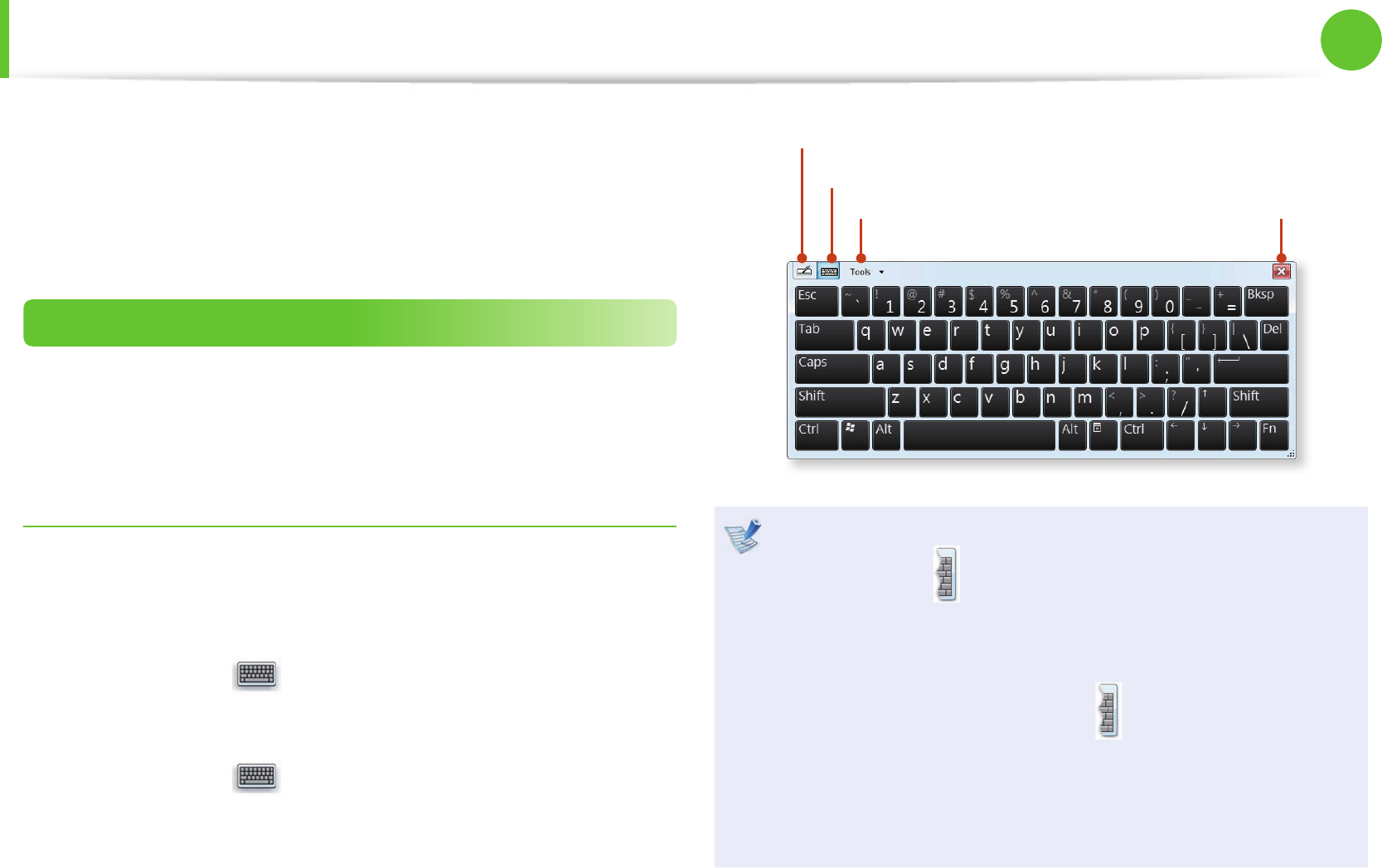
40
41
Chapter 2.
Using the computer
You can enter letters using either the Tablet PC input panel.
The procedures to enter letters for the Notepad will be described
below as an example.
Using the Tablet PC input panel
The Tablet PC Input Panel is an on-board character input panel
provided by Windows.
You can enter letters in 2 ways through the Tablet PC Input Panel.
Launching the Tablet PC input panel
1 Click Start > All Programs > Accessories > Notepad to
launch Notepad.
2 If you touch the Notepad screen with your nger, the
appears on the Notepad with the cursor.
3 If you touch the with your nger, the Tablet PC Input
Panel appears.
Tools Close
Writing Pad Mode
Touch keyboard
If you touch the touch screen with your nger, the Tablet PC
Input Panel tab appears with the cursor at the bottom
left on the Desktop. If you touch the Tablet PC Input Panel
tab, the Tablet PC Input Panel appears.
If the Tablet PC Input Panel Tab does not appear,
click start > Control Panel > Hardware and Sound >
Tablet PC Settings > Other tab and select [Go to Input
Panel Settings], select the “Use the Input Panel tab” in the
Options window and then click OK.
Entering Letters Using the Touch Screen
(For Windows 7 touch screen models only)
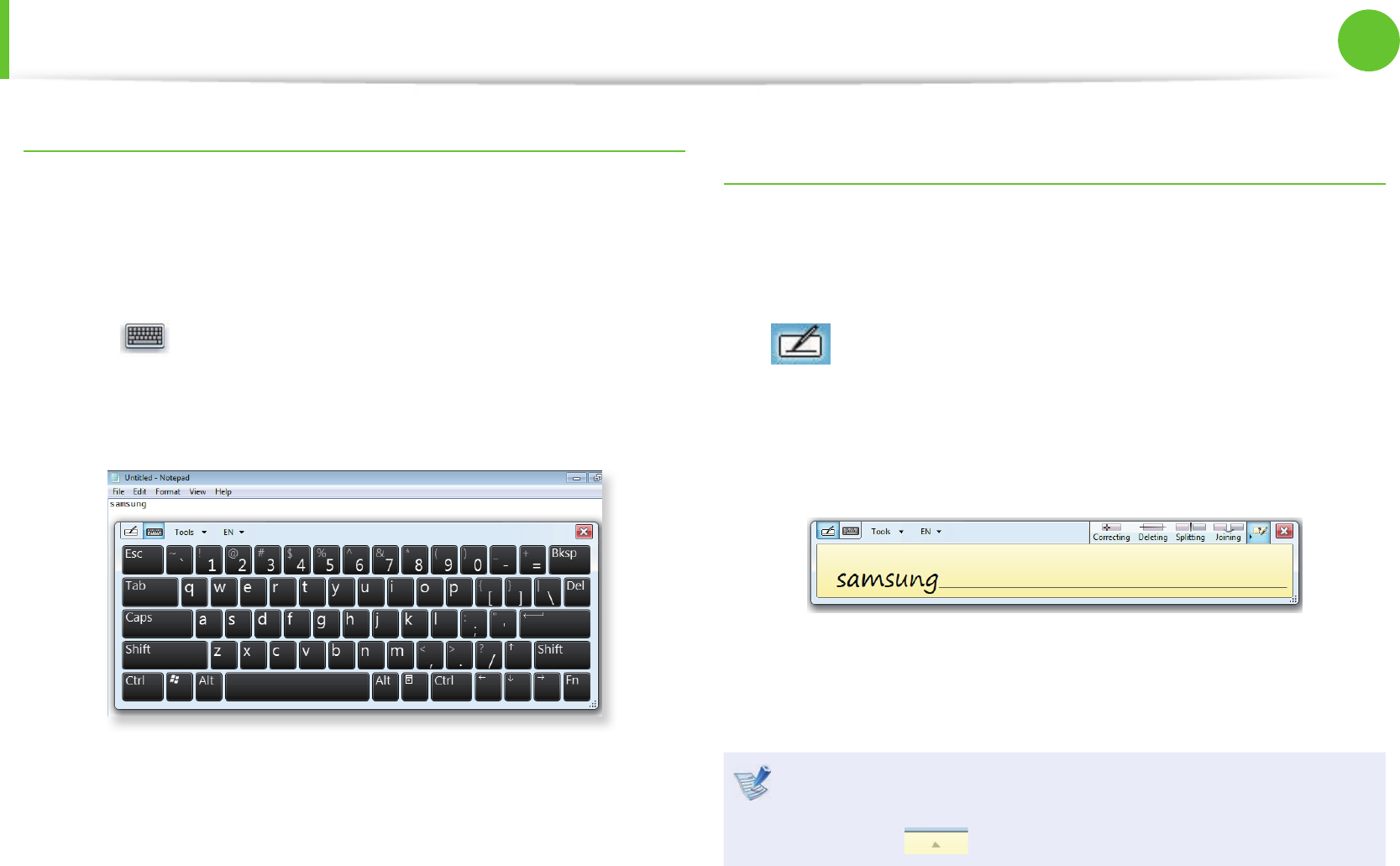
42
Chapter 2.
Using the computer
Entering Letters Using the Touch Screen
(For Windows 7 touch screen models only)
Entering letters using the touch keyboard
Using the touch keyboard, you can enter letters by touching the
corresponding keys on the keyboard that is displayed on the
screen as you do with a normal keyboard.
1 In the Tablet PC input panel, touch the touch keyboard
icon .
2 Enter letters by touching the corresponding keys on the
screen.
Entering letters with the writing pad
(hand-writing input mode)
In the touch screen, you can enter letters by directly writing letters
with your nger on the writing pad input panel.
1 In the Tablet PC input panel, touch the writing pad icon
.
2 Write a letter in the input area of the writing pad in the touch
screen and wait for a moment. Then the letter is converted to
the most likely letter.
3 If you touch the Insert button, the converted letter is
entered.
Modifying a letter
Over-write a new letter over an incorrectly recognized letter
or touch the above the letter and select a letter.
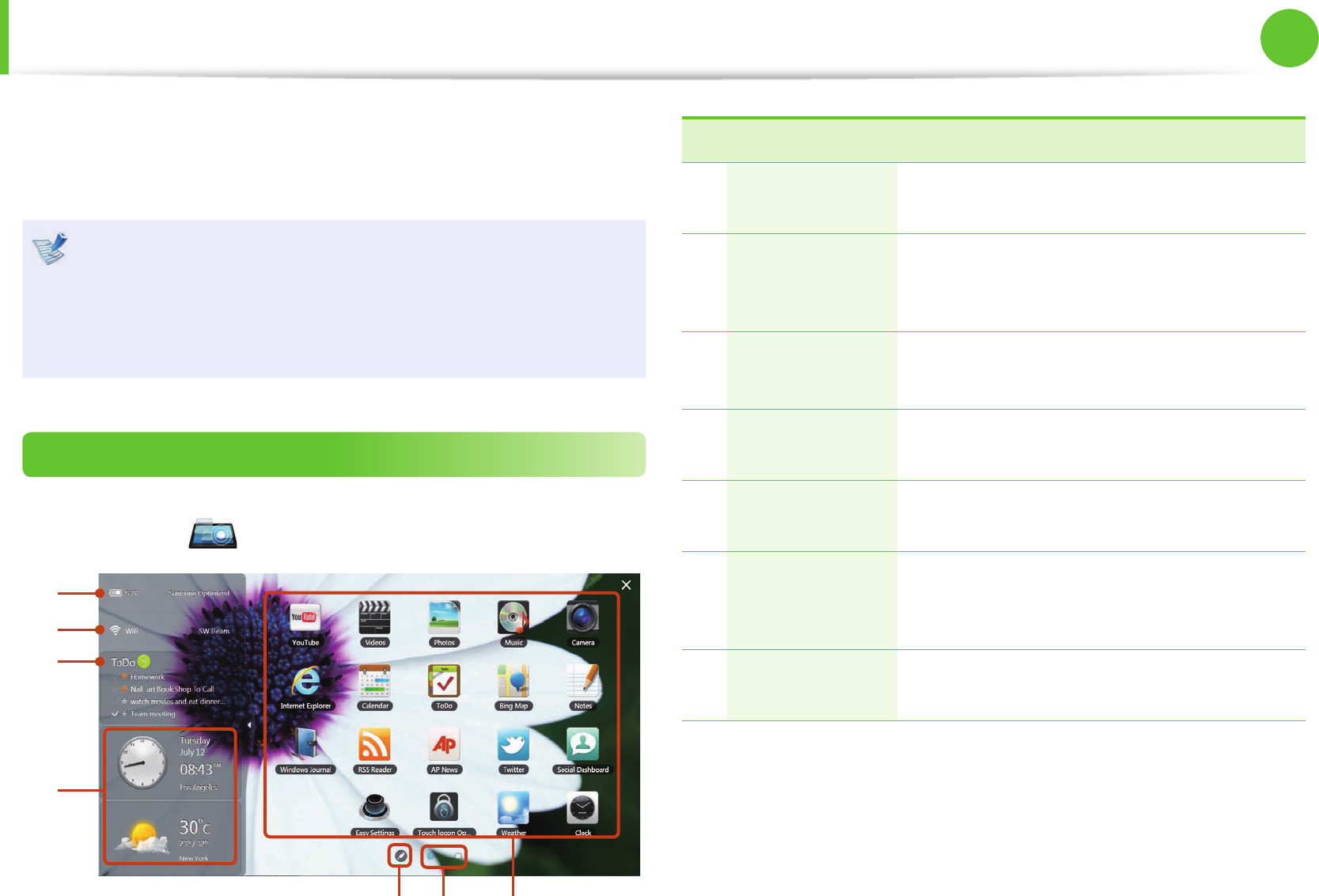
42
43
Chapter 2.
Using the computer
Using the Touch Launcher (For Windows 7 touch screen models only)
Touching the Launcher program enables you to easily play music
and video les and operate downloaded applications by touching
the screen with your nger on models with a touch screen.
The Touch Launcher is only provided for models with a •
touch screen and the terms and conditions, as well as the
appearance may di er depending on the model.
For programs to operate normally, the computer must be •
connected to the Internet.
Using the Touch Launcher (Optional)
Click Start > All Programs > Samsung > Play Touch and select
Touch Launcher to launch it.
1
2
3
4
65 7
No. Function Description
1Power Option Shows the remaining battery charge and
the currently con gured battery mode.
2Wi-Fi
Shows the Wi-Fi connection status. If
the computer is connected to Wi-Fi, the
connected AP name is displayed.
3ToDo
(Things to do)
Creates/Displays the ToDo list
You can create a list of things to do.
4Clock / Weather Shows the time and weather information
for the con gured region.
5Edit Mode Add group, Add program From Desktop,
Change wallpaper.
6Page Indicator
Shows the position of the current page. To
navigate the pages, click the Page Indicator
or drag the screen to the left or the right.
7Program area Shows the program list. To launch a
program, click the program icon.
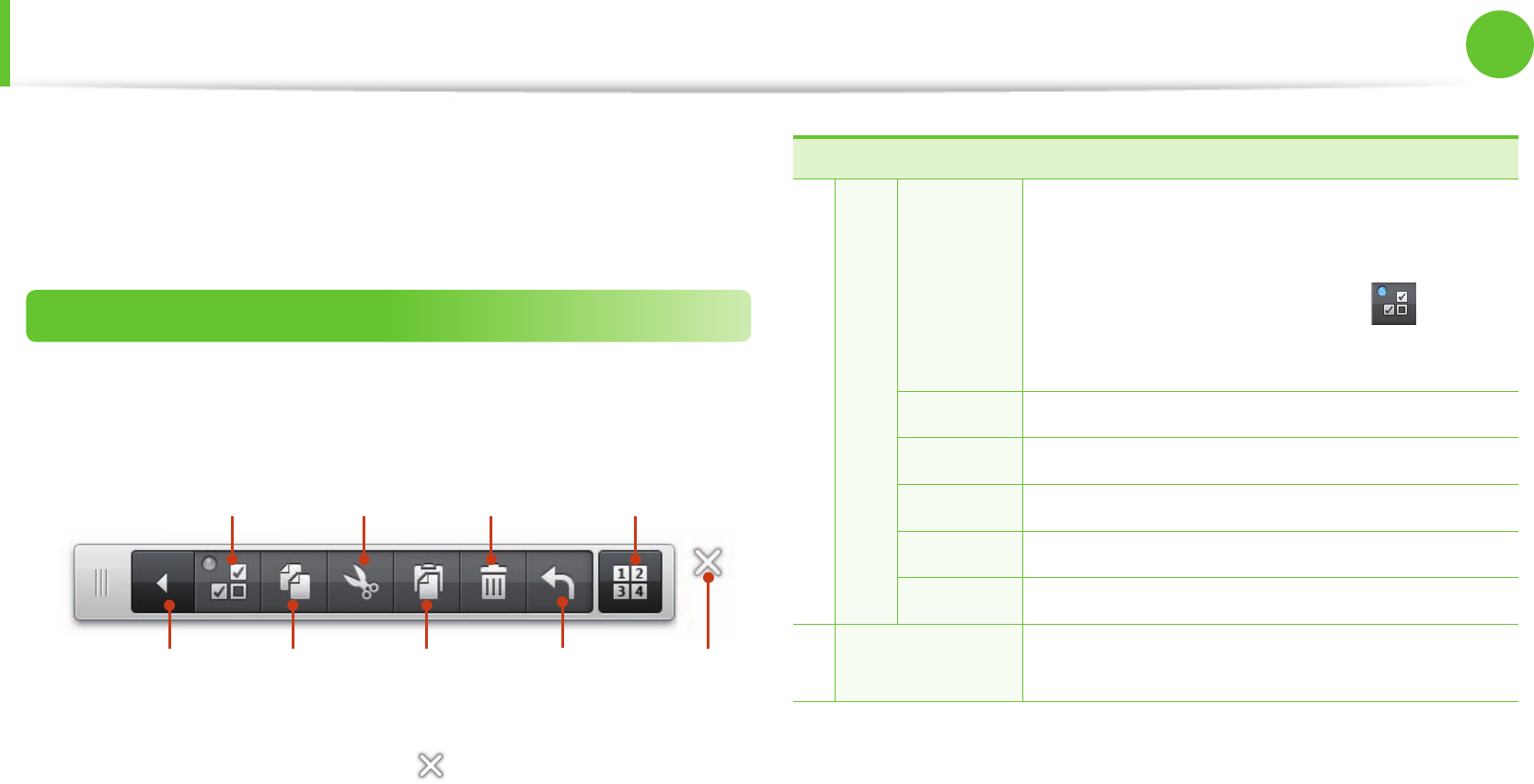
44
Chapter 2.
Using the computer
Using the Touch Supporter (For Windows 7 touch screen models only)
This program helps you to use functions that cannot be easily
used with touch operations more easily.
Launching the Touch Supporter
If you touch the screen with three ngers simultaneously the
touch support program is launched.
Copy Exit
Multiple-selection Cut Delete Numeric Pad
Show/Hide Hotkeys Paste Undo
To exit the Touch Supporter, click or touch the screen with
three ngers again.
No. Function Description
1Hot
key
Multiple-
selection
This performs the same function as the
Ctrl key. If you touch the multiple-selection
function, the indicator is lit. When the
multiple-selection is activated , and you
touch les with your nger one by one, all
touched les are selected.
Copy Copies the selected item.
Cut Cuts the selected item.
Paste Pastes the copied or cut item.
Delete Deletes the selected item.
Undo Cancels the last operation.
2 Numeric pad If you touch the numeric pad button, the
numeric and direction keyboard appears.
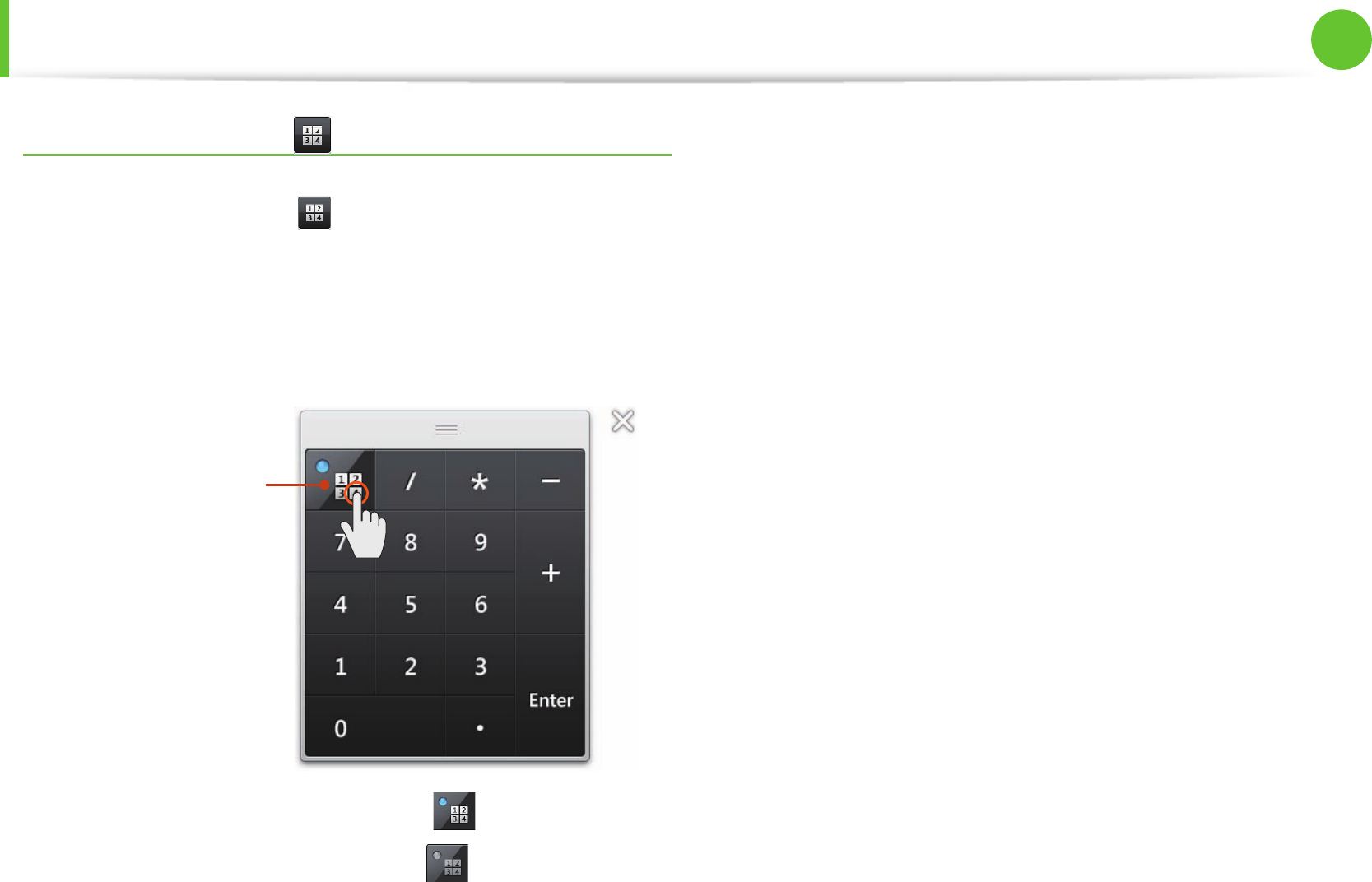
44
45
Chapter 2.
Using the computer
Using the Touch Supporter (For Windows 7 touch screen models only)
Using the Numeric Pad
1 Click the Numeric Pad . The Numeric Pad appears on the
screen.
2 If you touch the buttons of the Numeric Pad, the
corresponding numbers or symbols are entered on the
screen.
Switches the mode
between the numeric
and the direction key
input modes
To select direction key input mode, touch .
To select numeric key input mode, touch .
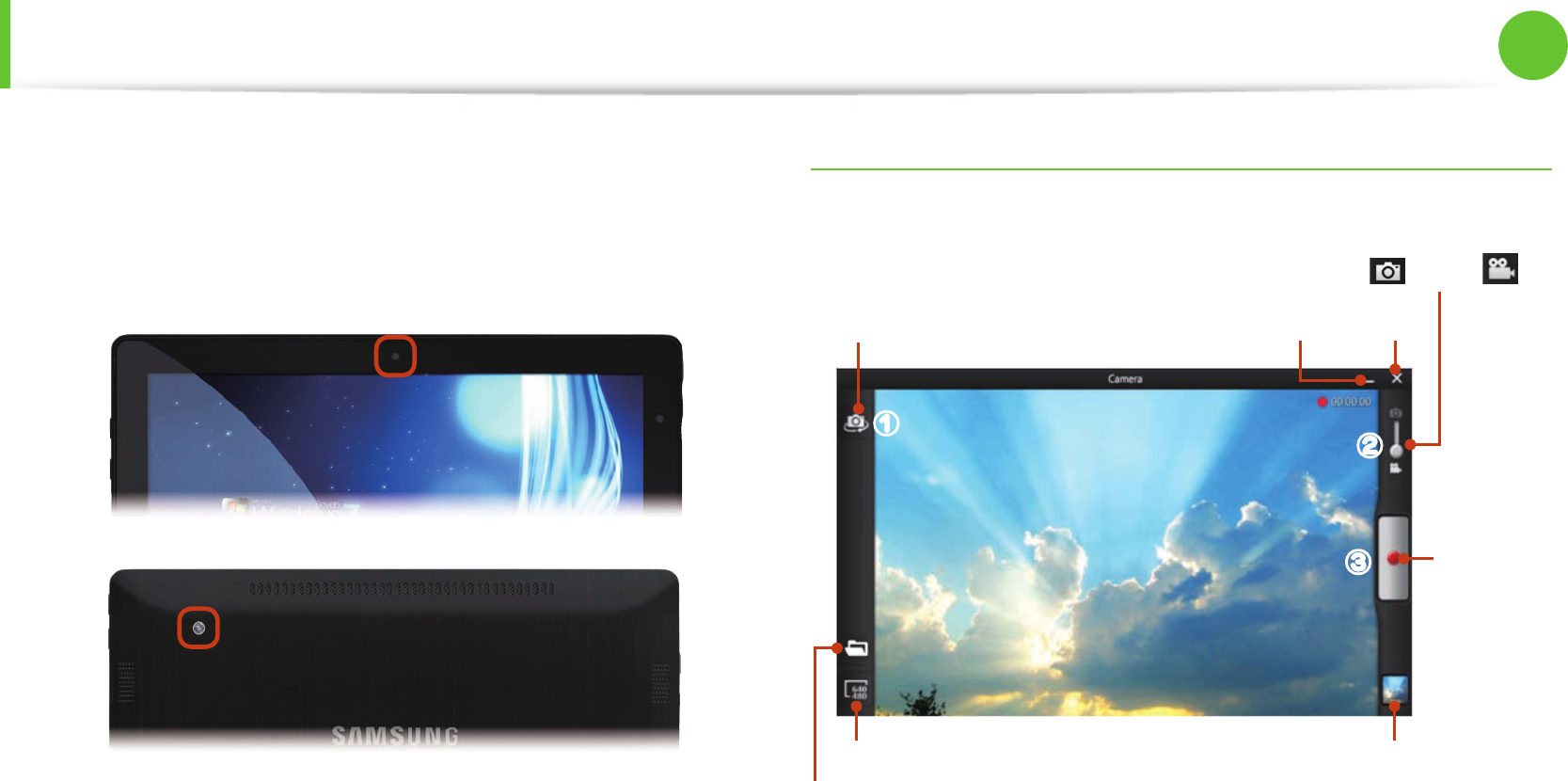
46
Chapter 2.
Using the computer
Using the camera
This product has 2 cameras(Optional). One is at the front and
the other is at the back. Using the touch camera program, you
can conveniently take a picture or record a video using touch
operations.
Using the Camera program
Click the Touch Launcher and launch the Camera.
Select the front or rear camera ExitMinimize
Select camera mode (camera , video )
Select the resolution. View the captured picture or video.
Take a
picture or
make a
recording
Open the folder to save the le with Explorer.
zx
c
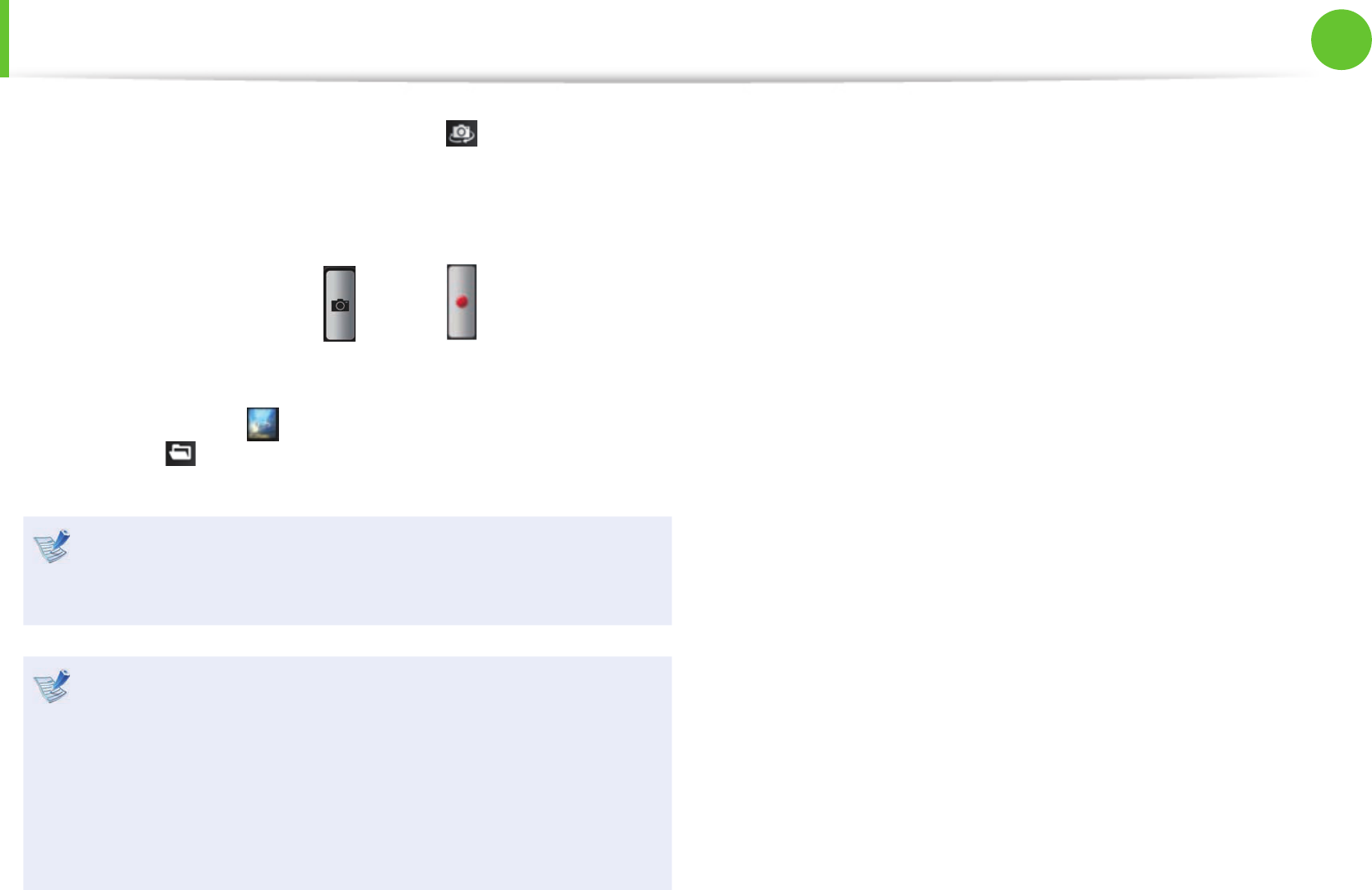
46
47
Chapter 2.
Using the computer
Using the camera
1 Touch the Select Front/Rear Camera to select either the
front or the rear camera that you will use.
2 To take a picture, select camera mode. To record a video,
select video mode.
3 Touch the Take a Picture /Record to take a picture or
record a video.
4 You can view the picture or recorded video through the
Preview function or the Open the saved folder with
Explorer .
You can record up to 20 minutes of video.•
If the free space of the computer reaches 500MB, video •
recording is stopped.
When you take a picture
Do not take a picture or record a video without the consent •
of the person you are recording.
Do not take a picture or record a video when it is •
prohibited.
Do not take a picture or record a video where it may invade •
a person’s privacy.
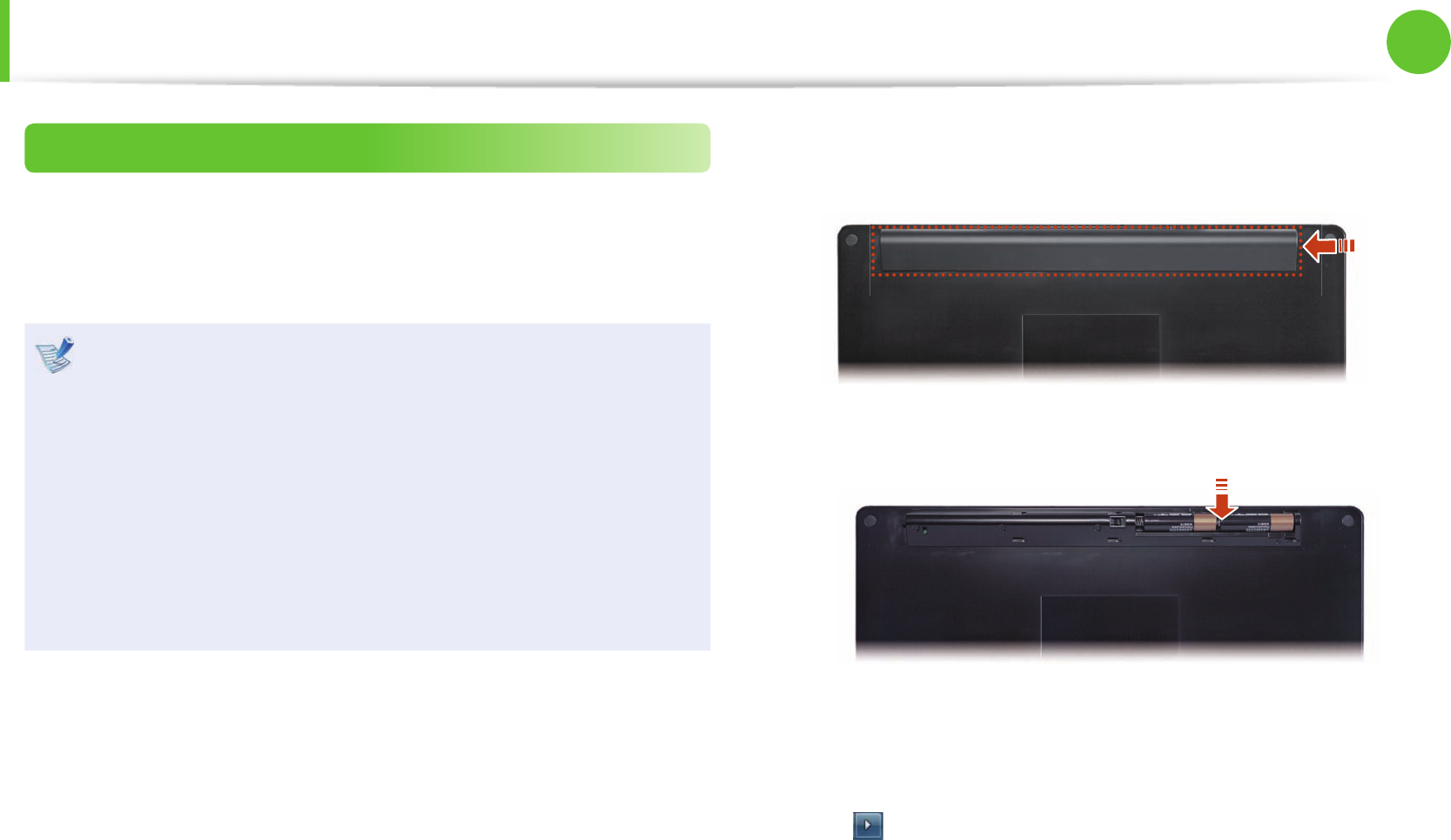
48
Chapter 2.
Using the computer
Keyboard (Optional)
Using the Bluetooth Wireless Keyboard
You can connect and use an external type keyboard. This section
describes how to connect a Bluetooth wireless keyboard provided
optionally by Samsung Electronics.
Bluetooth is wireless communications technology that •
allows access to nearby devices such as another computer,
a cell phone, printer, keyboard, mouse, etc. without a cable
connection.
The Bluetooth supporting function is only available •
between devices (a computer, cell phone, PDA, printer, etc.)
and the connection may be restricted according to the
pro le of the corresponding device.
The keyboard is optional and may not be provided •
depending on the model.
1 Remove the battery compartment cover at the back of the
computer.
2 Install the battery and close the cover.
3 If you press and hold the keyboard power button for 3
seconds after starting the computer, the Bluetooth LED will
blink in blue.
4 Click > Bluetooth Devices > Add a Device.
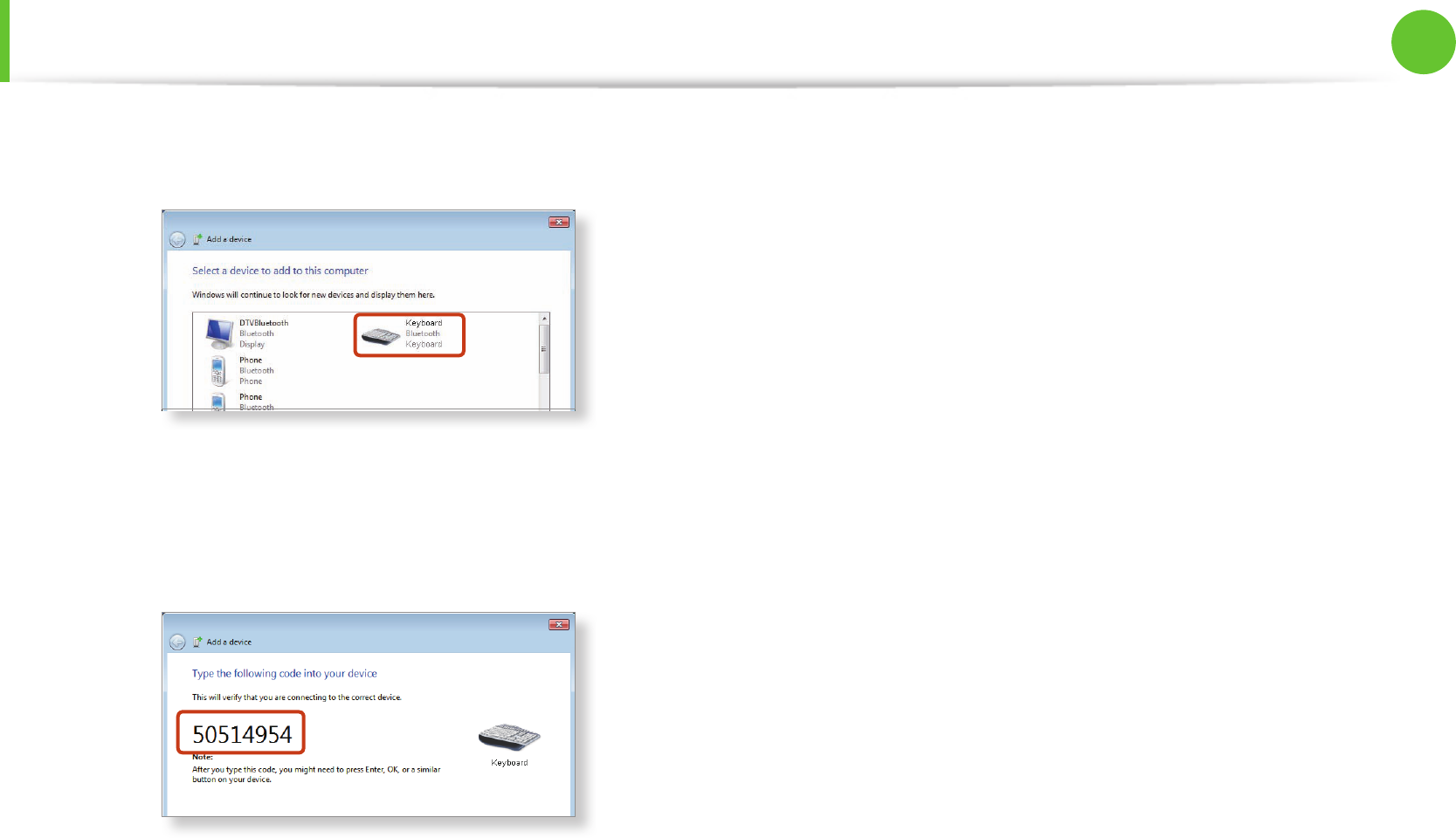
48
49
Chapter 2.
Using the computer
Keyboard (Optional)
5 Select the keyboard to be connected and click Next.
6 Enter the number displayed on the screen and press Enter.
This will connect the keyboard.
When the keyboard is connected, the blue Bluetooth LED of
the keyboard is turned o .
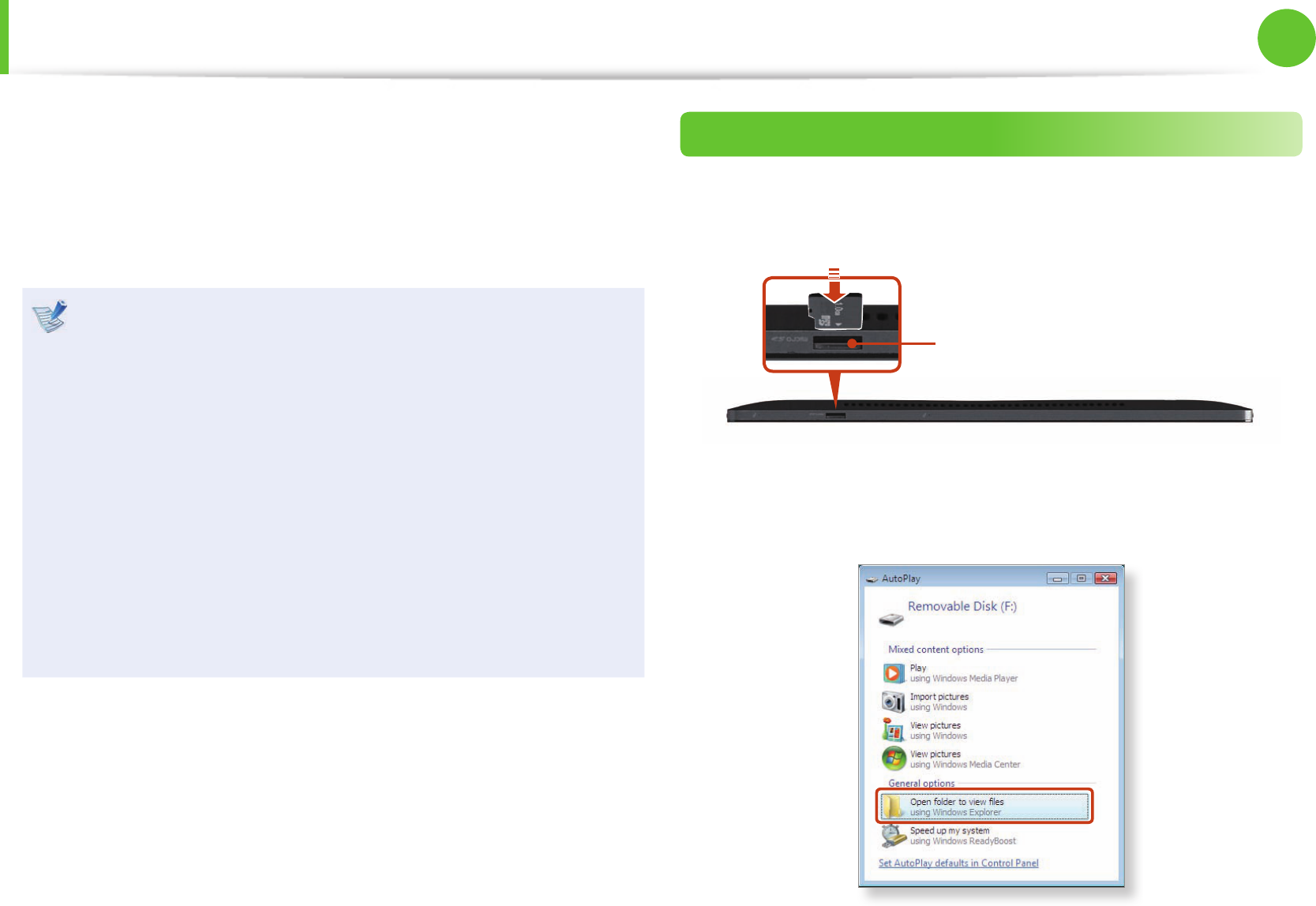
50
Chapter 2.
Using the computer
Micro SD Card Slot (Optional)
You can only use the micro SD card slot for micro SD cards.
You can use micro SD cards as removable disks and conveniently
exchange data with digital devices such as a digital camera, digital
camcorder, MP3, etc.
You have to additionally purchase a micro SD card with the •
necessary capacity depending on your requirements.
You can use a micro SD card just like any data storage •
device.
A copyright protection function is not supported.
Since a card may fall out and become lost when you move •
the computer, store it separately.
The gures used for the description are of a representative •
model. Therefore the gures may di er from the real ones.
These descriptions are written based on Windows 7, the •
latest operating system. Therefore, some descriptions and
gures may di er from your operating system. But as the
usage is similar to other Windows operating systems, you
can use these descriptions for reference.
Using the card
1 Insert the card into the micro SD card slot in the marked
direction.
Micro SD Card Slot
2 The card drive appears. Click Open folder and view les.
If the window does not appear, click Start > Computer.
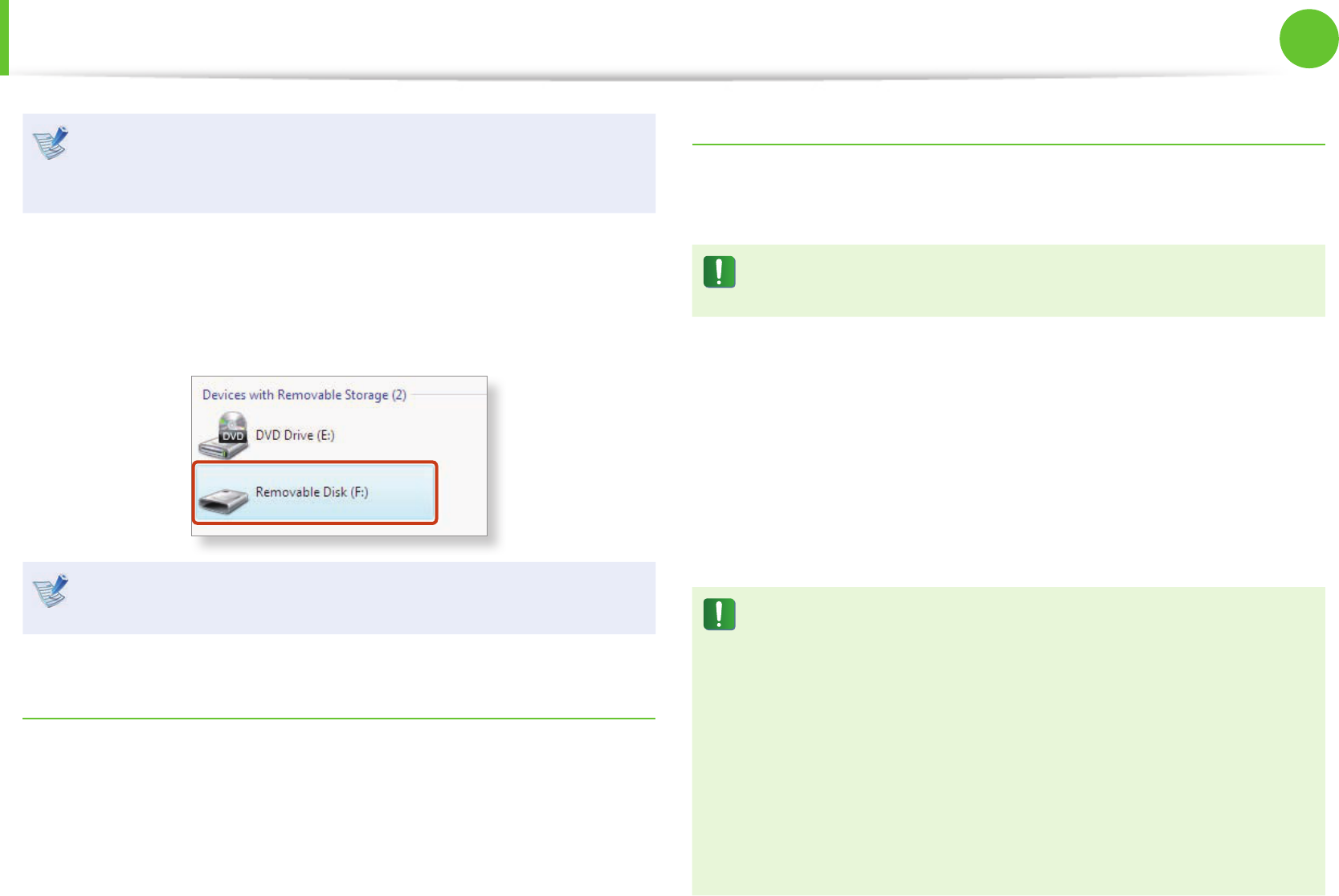
50
51
Chapter 2.
Using the computer
Micro SD Card Slot (Optional)
If a window asking to scan and change appears, click
Continue Without Scanning. This will proceed to Step 2
above.
3 You can save, move and delete data by double-clicking the
corresponding drive.
You can only use the card after formatting it.
The device name of the card drive may di er depending on
your computer model.
To remove a memory card
Press the card until it pops up, then pull it out by holding the end
of the card.
To format a memory card
When using the memory card for the rst time, you must format
the card before using it.
Formatting a card deletes all data saved on the card. If the
card includes data, backup the data before formatting it.
1 Click Start > Computer.
2 Right-click over a card drive with the touchpad and select
Format.
3 Click Start to the formatting.
To use a card to exchange data with a digital device such •
as a digital camera, formatting the data using the digital
device is recommended.
When you try to use a card, which is formatted in the •
computer, in another digital device, you may have to
format the card again in the device.
If the write-protect tab is in the • Lock position, you cannot
format, write or delete data on the card.
Take care when you insert or remove a micro SD card. The •
micro SD card may be damaged when not treated carefully.
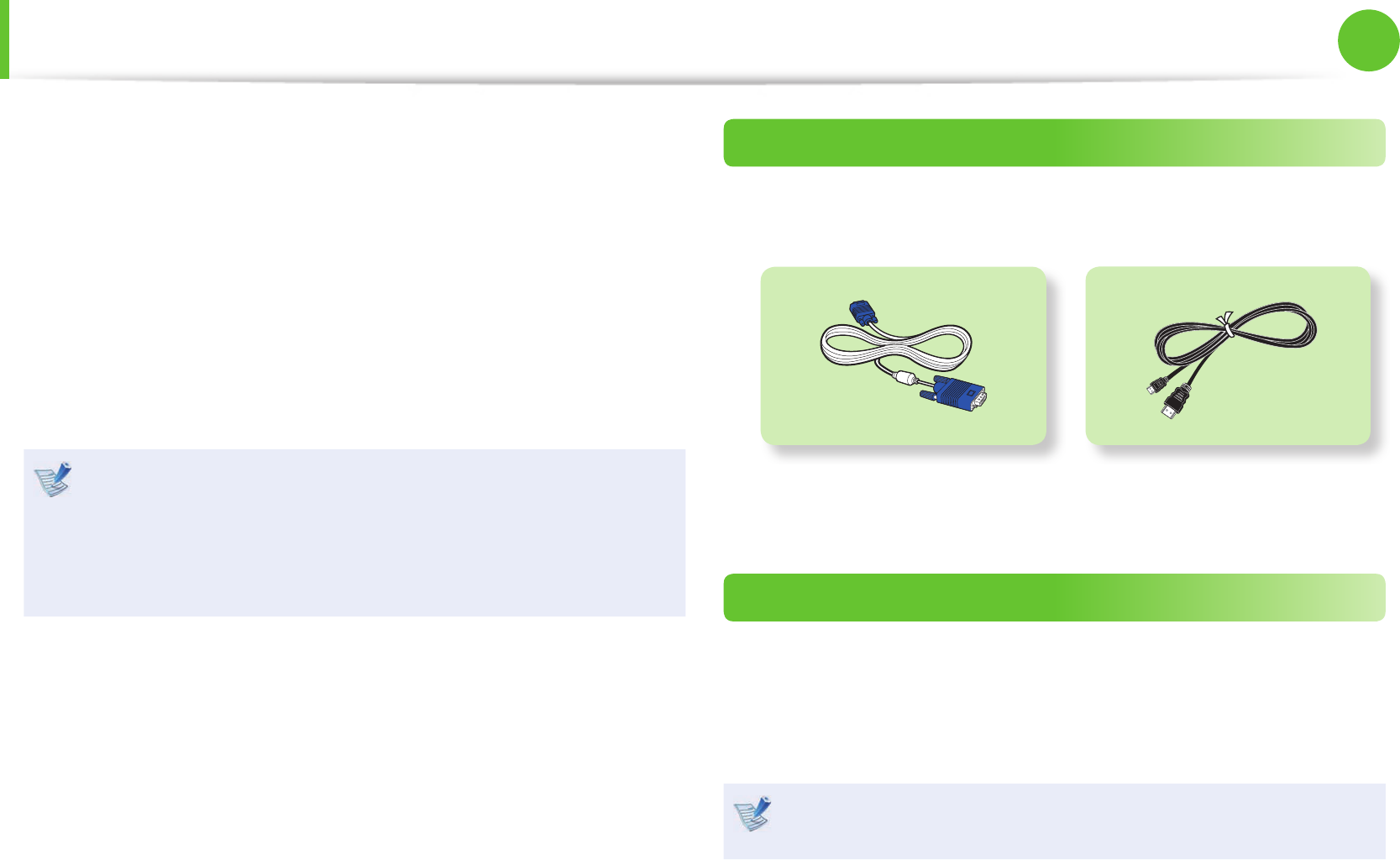
52
Chapter 2.
Using the computer
Connecting an External Display Device
If you connect an external display device such as a monitor, TV,
projector, etc., you can view the picture on the wider screen of the
external device when you give a presentation or watch a video or
movie.
There is an analog monitor port (RGB) and a micro digital video
and audio port (Micro HDMI).
Since the visual quality is higher for Micro HDMI than VGA, if more
than one port is available, connect the port that provides the
higher visual quality.
Before you start, check the port and cable of the external •
display device and then connect the display device to the
computer.
Due to restrictions of the operating system the DualView •
function is not supported for Windows 7 Starter.
About the connection cable
Users should additionally purchase the necessary connection
cables.
Analog Monitor (RGB) Cable
HDMI to micro HDMI Cable
Connecting to the monitor port (Optional)
You can experience a wider screen by connecting the computer to
a monitor, TV or projector with a monitor port.
You can give better presentations by connecting the computer to
a projector.
The VGA adapter is optional and may not be provided
depending on the model.
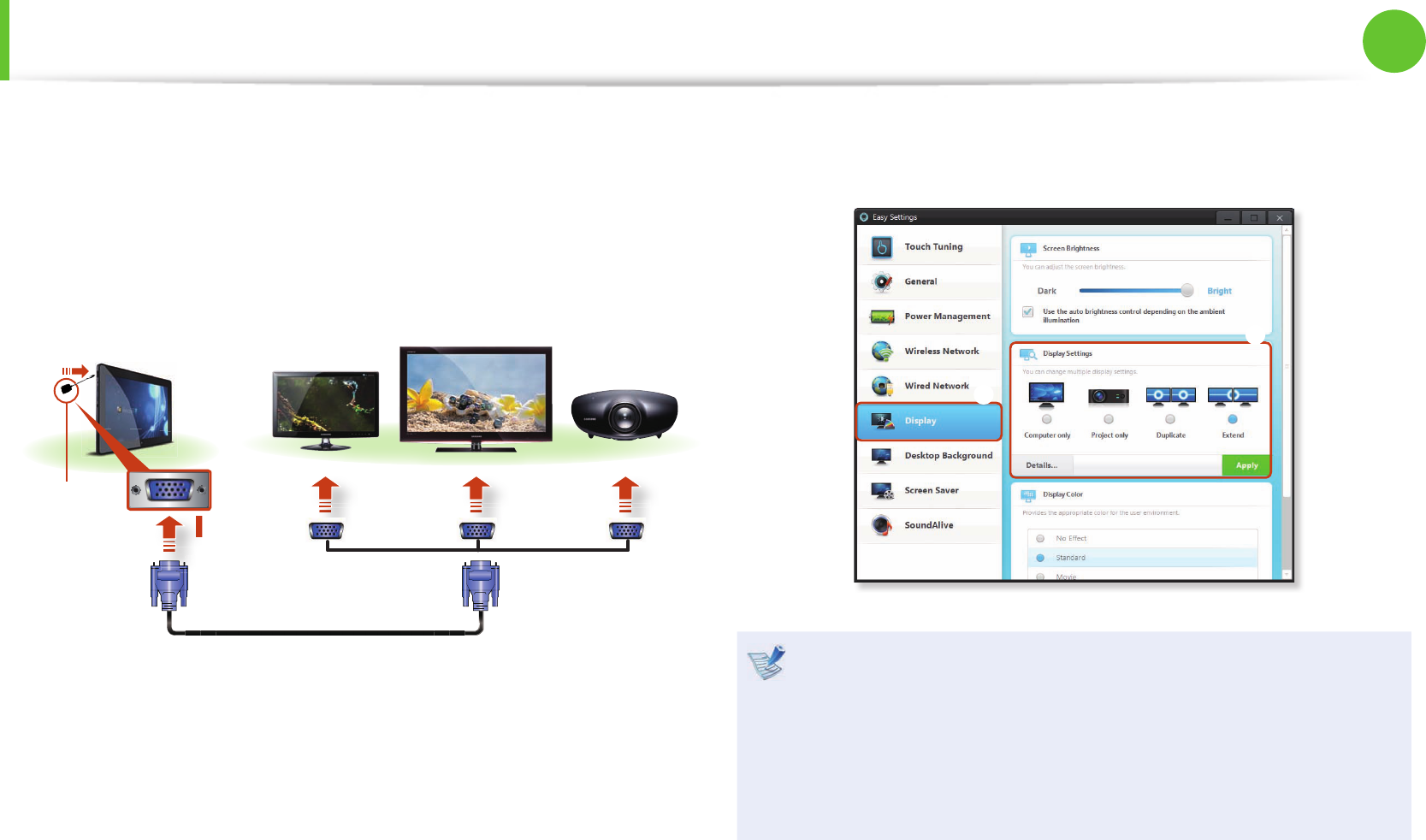
52
53
Chapter 2.
Using the computer
1 Connect the VGA adapter to the USB port.
2 Connect the VGA cable (15-pin) to the connected VGA
adapter and then connect the other end of the VGA cable to
the VGA port of the monitor or the TV.
x
External
Monitor TV
Projector
x
z
VGA
Adapter
3 Connect the power cord of the connected monitor, TV or
projector and turn the power on.
4 Launch the Easy Settings, click Display > Display Settings
and select a mode.
z
x
To use the function, the • Easy Settings must be installed.
Alternatively, to set up dual view:•
Open the Display Settings window in the Control Panel,
select Monitor 2 and select the Expand to t to this
monitor checkbox to set dual view. For more detailed
information, refer to the Windows online help.
Connecting an External Display Device
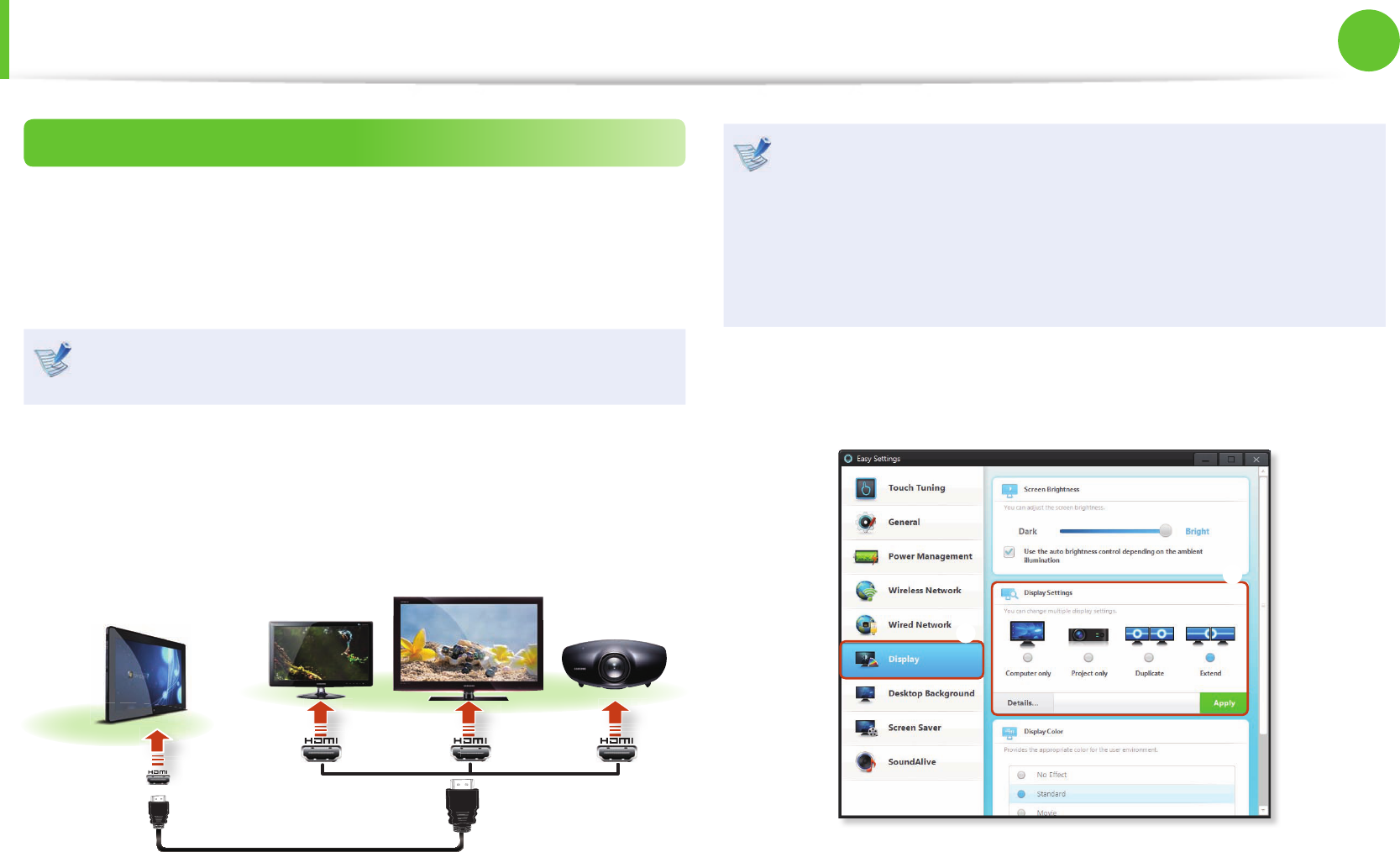
54
Chapter 2.
Using the computer
Connecting through the Micro HDMI port (Optional)
By connecting the computer to a TV with a HDMI port, you can
enjoy both a high visual quality and a high sound quality.
After connecting a TV through Micro HDMI, you have to con gure
the screen and sound.
You have to additionally purchase the HDMI to micro HDMI
cable.
1 Connect the HDMI to micro HDMI cable to the HDMI port of
the TV.
External
Monitor TV
Projector
HDMI to
micro HDMI
This is only supported for models that support a TV output •
port (HDMI).
When a TV provides more than one HDMI port, connect •
the computer to the DVI IN port.
When connecting the computer to a TV, switch the •
external input mode of the TV to HDMI.
2 Launch the Easy Settings, click Display > Display Settings
and select a mode.
z
x
Connecting an External Display Device
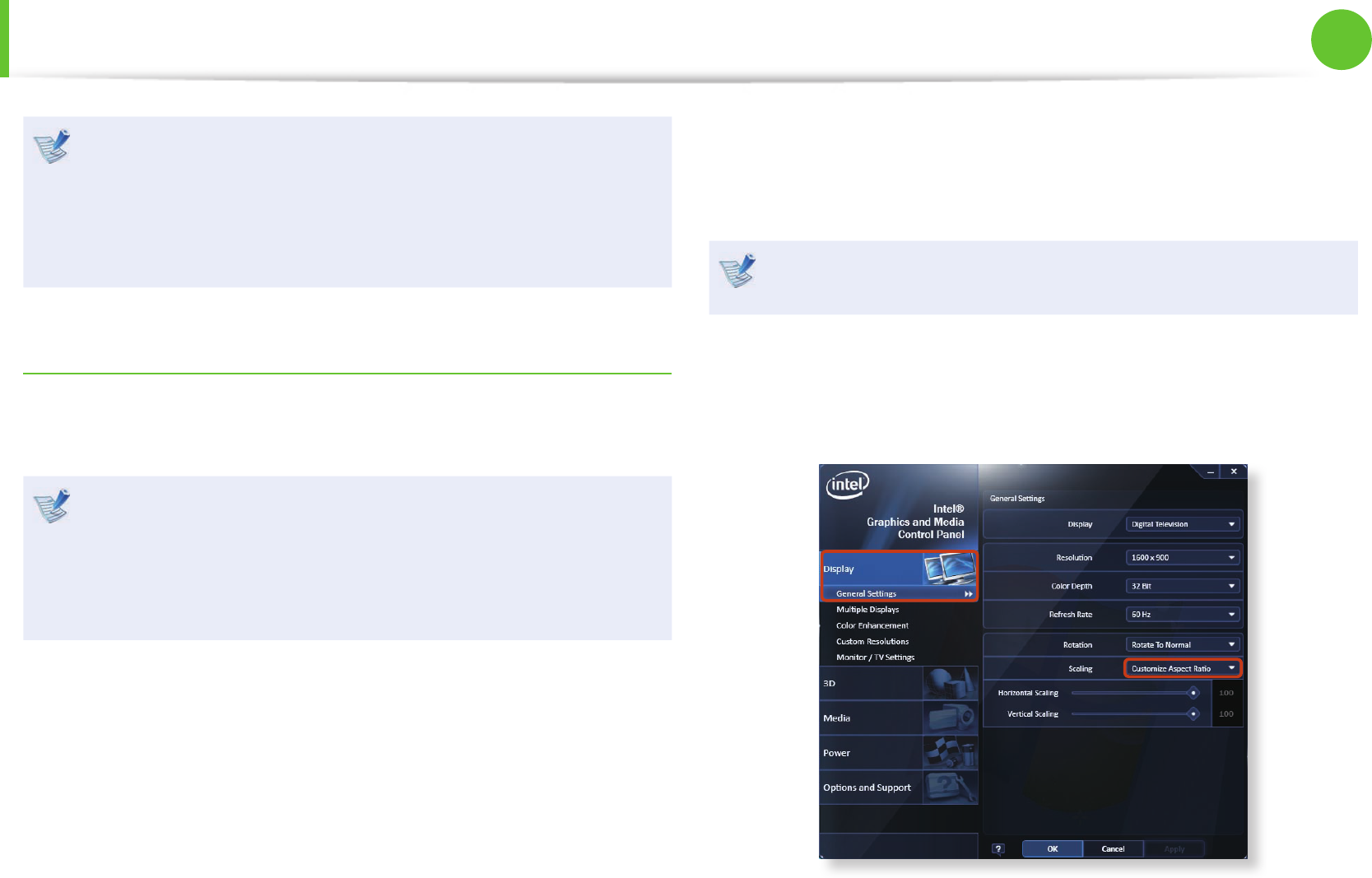
54
55
Chapter 2.
Using the computer
External Monitor / TV is not supported in the DOS •
Command Prompt window.
Simultaneous output to all 3 (LCD + CRT + HDMI) is not •
supported.
To use the function, the • Easy Settings must be installed.
Setting up HDMI TV video (Optional)
If the Desktop screen displayed on the TV does not t to the TV
screen, con gure it as follows depending on the graphics card.
You can view the graphics card type by selecting • Device
Manager > Display adapters and then clicking the +
symbol.
The screen images and terms may di er from actual product •
depending on the computer model and driver version.
► For Intel graphics cards
1 Right-click over the Desktop and select Graphics Properties.
If a window appears where you can select the mode, select
Basic Mode and click OK.
2 Click Display > General Settings, select Customize Aspect
Ratio in the Scaling eld, t the Desktop to the TV screen
and click OK.
Connecting an External Display Device
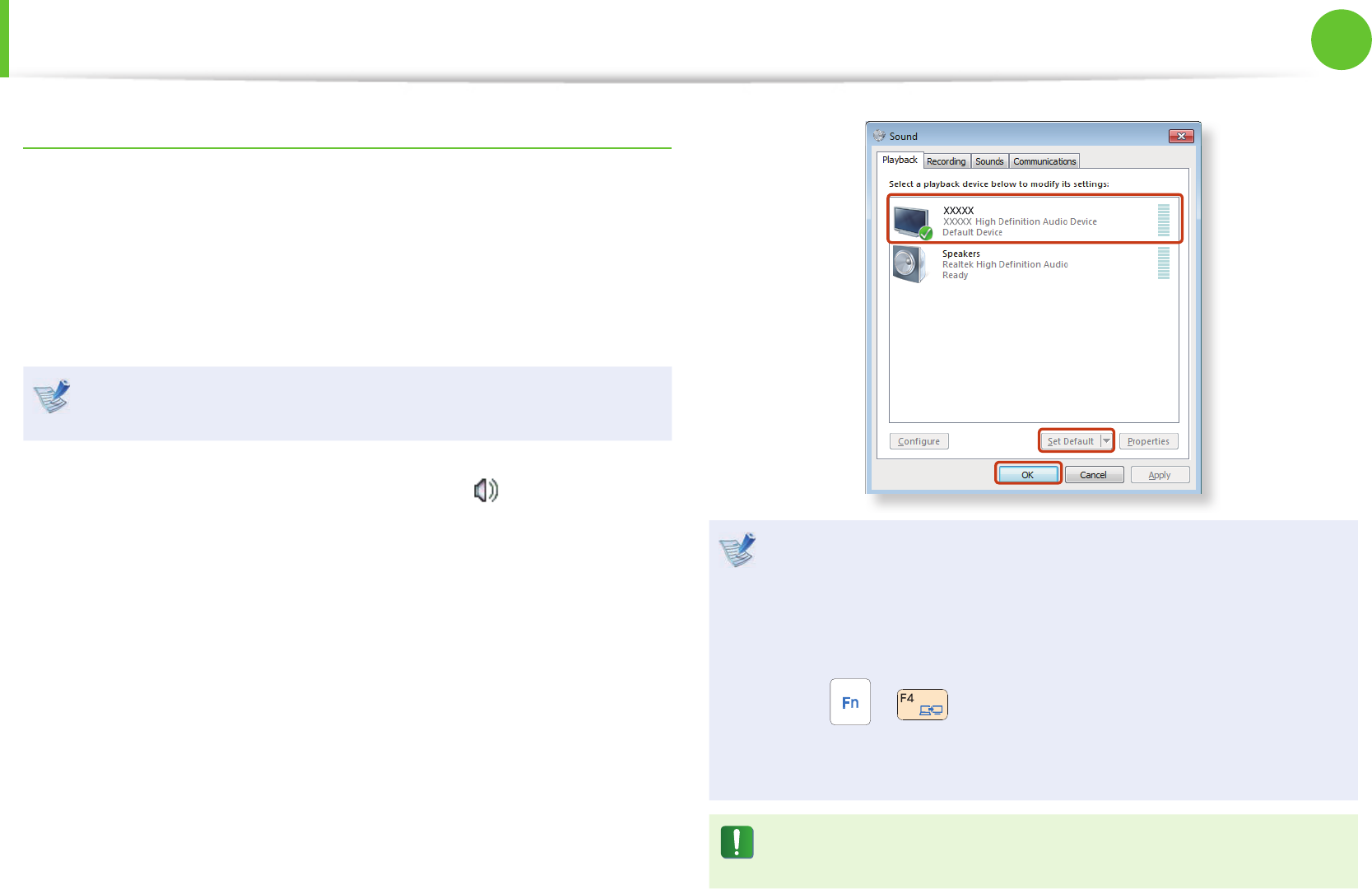
56
Chapter 2.
Using the computer
Setting up HDMI TV audio (Optional)
You can con gure the sound of the computer to be played
through the HDMI TV.
You have to con gure the sound device in the Control Panel
whenever you connect the HDMI TV in order to hear sound from
the computer on the TV.
The screen images and terms may di er from actual product
depending on the computer model.
1 Right-click over the Volume Control icon in the
noti cation area at the bottom right of the Desktop and
select Playback Devices.
(Alternatively, click the Control Panel > Hardware and
Sound > Sound.)
2 Change the setting to Digital Audio (HDMI), HDMI Device or
Digital Output Device, click Set Default and click OK.
HDMI Output Device may not appear on the playback •
device list depending on the computer model.
In this case, turn on the TV, connect the TV to the computer
using a HDMI cable and then switch to HDMI or LCD+HDMI
Clone or LCD+HDMI DualView mode using the Shortcut
Key( + ).
To use the hot keys, you have to use a keyboard. Please •
connect a keyboard rst.
To listen to sound on the computer after disconnecting the
HDMI TV, you have to set the Playback Device to Speakers.
Connecting an External Display Device
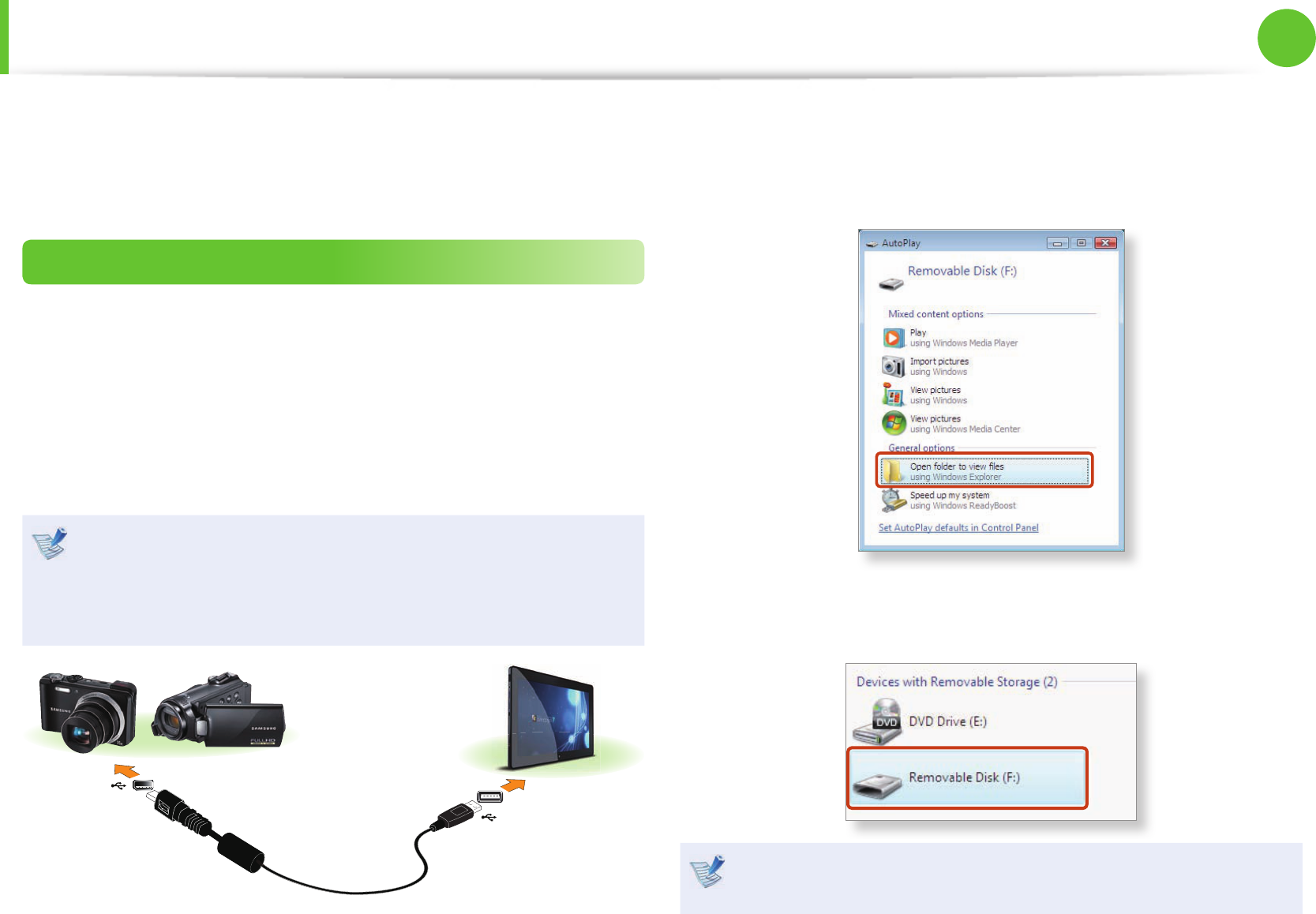
56
57
Chapter 2.
Using the computer
Connecting an External Digital Device
You can save a le stored on a device onto the computer by
connecting a digital device such as a camera, camcorder or mobile
phone to the computer and using the le management functions.
Connecting and using a camera or camcorder
If a digital device such as a camera or camcorder is connected with
the computer, it is recognized as a removable disk so that you can
copy or move the les on the device.
1 Connect the USB port of the notebook computer and the
USB port of the digital device such as a camera using the USB
cable.
Both the computer and the digital device must be turned •
on.
You have to additionally purchase the USB cable necessary •
to connect the computer and the device.
Camera Camcorder
2 The Auto run window appears. Click Open folder and view
l e s .
If the window does not appear, click Start > Computer.
3 Double-click the corresponding drive. You can then save,
move or delete data.
The device name of the card drive may di er depending on
the model.
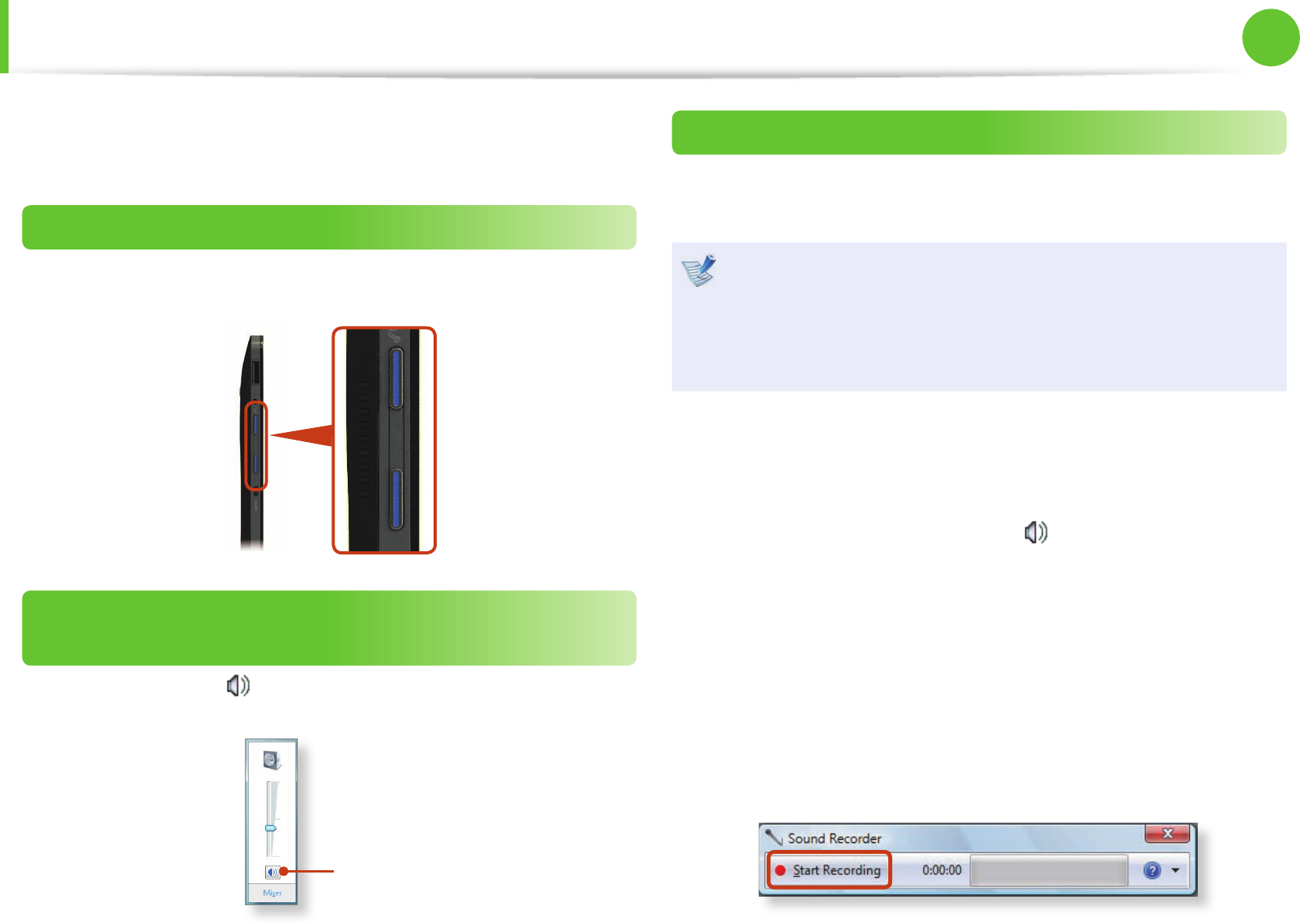
58
Chapter 2.
Using the computer
Adjusting the Volume
You can control the volume using the volume control buttons or
the volume control program.
Adjusting the volume with the buttons
You can control the volume by pressing the volume control button
on the left side of the computer.
Adjusting the Volume using the Volume
Adjustment Program
Click the Volume icon on the taskbar and slide the volume
control bar to adjust the volume.
Mute
Using the Sound Recorder
The procedures to record sound using the Windows Recorder are
described below.
These descriptions are written based on Windows 7, the latest
operating system. Therefore, some descriptions and gures
may di er from your operating system. But as the usage is
similar to other Windows operating systems, you can use
these descriptions for reference.
1 Connect a microphone to the microphone jack.
You can also use the internal MIC.
2 Right-click over the Volume icon on the taskbar and select
Recording Device.
3 Check if the microphone is set as the default recording
device.
If this is the case, it is already set as the default device. If not,
right-click over the microphone and select Set default.
4 Click Start > All Programs > Accessories > Sound Recorder
and click Start recording to start a recording.
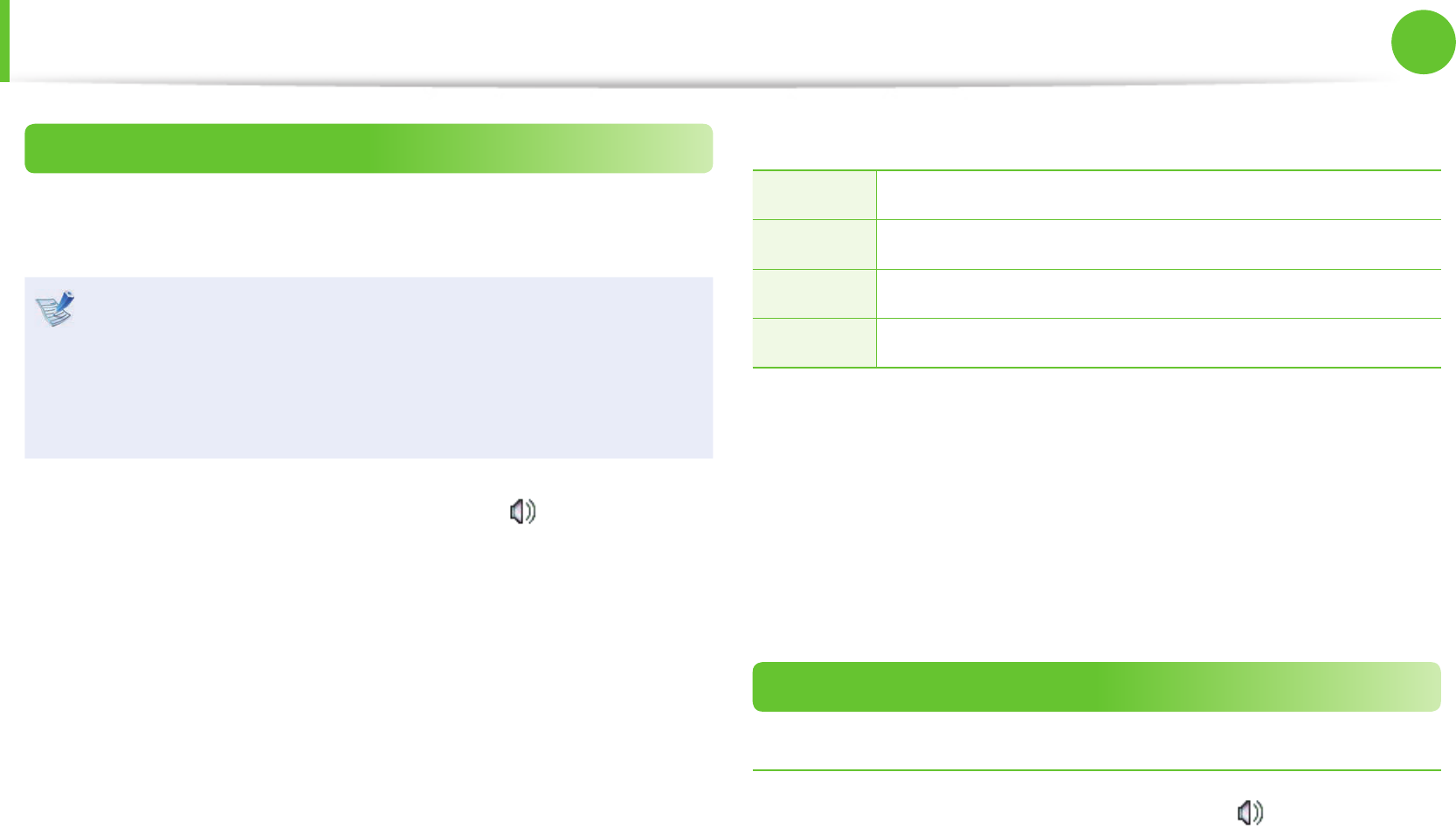
58
59
Chapter 2.
Using the computer
Using SoundAlive
The SoundAlive function enables you to experience more
stereophonic sound using stereo speakers.
SoundAlive is only supported in Windows 7.•
The software programs provider may vary, depending on •
your computer model.
In addition, some pictures may di er from actual product •
depending on the computer model and software version.
1 Right-click over the Volume Control icon in the
noti cation area at the bottom right of the Desktop and
select Playback Devices. (Alternatively, click the Control
Panel > Hardware and Sound > Sound.)
2 Right-click over the Speakers and select Properties.
3 Select the SoundAlive tab and select one of the modes.
► Basic Mode
Music Select this mode to listen to music.
Movie Select this mode to watch a movie.
Speech Emphasizes voice over other sounds.
Silver Silver mode is for people who have di culty in hearing.
► Advanced Mode
Finely tuned 25 presets are arranged on a square according to
their relative sound characteristics.
► User Mode
You can control a variety of sound e ects.
Connecting and using a Ear-set / headset Jack
Using the Ear-set / headset jack
1 Right-click over the Volume Control icon in the
noti cation area at the bottom right of the Desktop and
select Playback Devices. (Alternatively, click the Control
Panel > Hardware and Sound > Sound > Playback tab.)
2 Select the Speakers (Realtek High De nition Audio), click
Set Default and click OK.
Adjusting the Volume
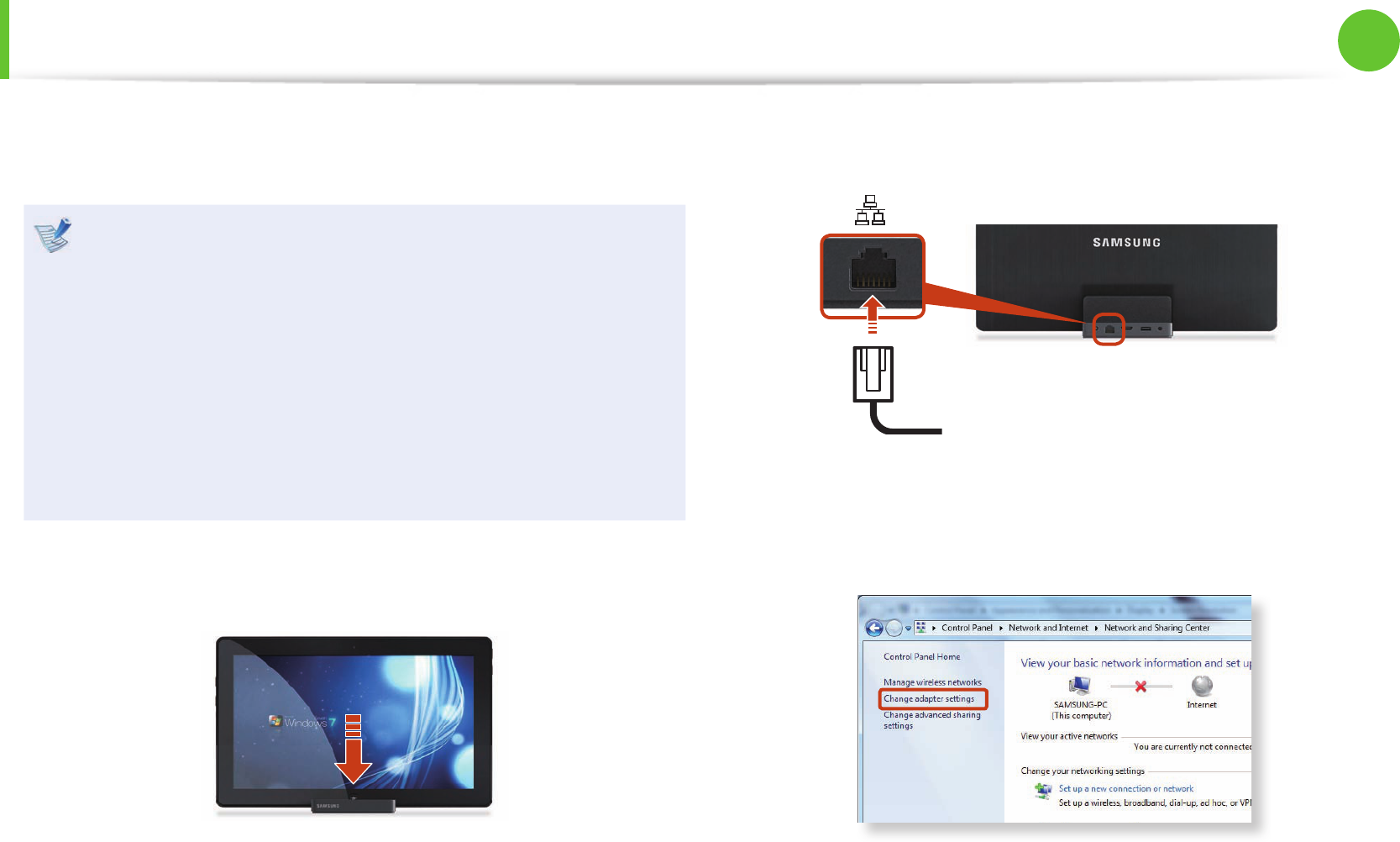
60
Chapter 2.
Using the computer
A wired network is a network environment used for a company
network or broadband internet connection at home.
The gures used for the description are of a representative •
model. Therefore the gures may di er from the real ones.
These descriptions are written based on Windows 7, the •
latest operating system. Therefore, some descriptions and
gures may di er from your operating system. But as the
usage is similar to other Windows operating systems, you
can use these descriptions for reference.
To use a wired network, you have to connect the Slate •
PC Dock. The Slate PC Dock is optional and may not be
provided depending on the model.
1 Connect the Slate PC Dock to the Slate PC Dock port of the
computer.
2 Connect the LAN cable to the LAN cable port of the Slate PC
Dock.
3 Click Start > Control Panel > Network and Internet >
Network and Sharing Center and click on Change adapter
settings in the left menu pane.
Wired Network (Optional)
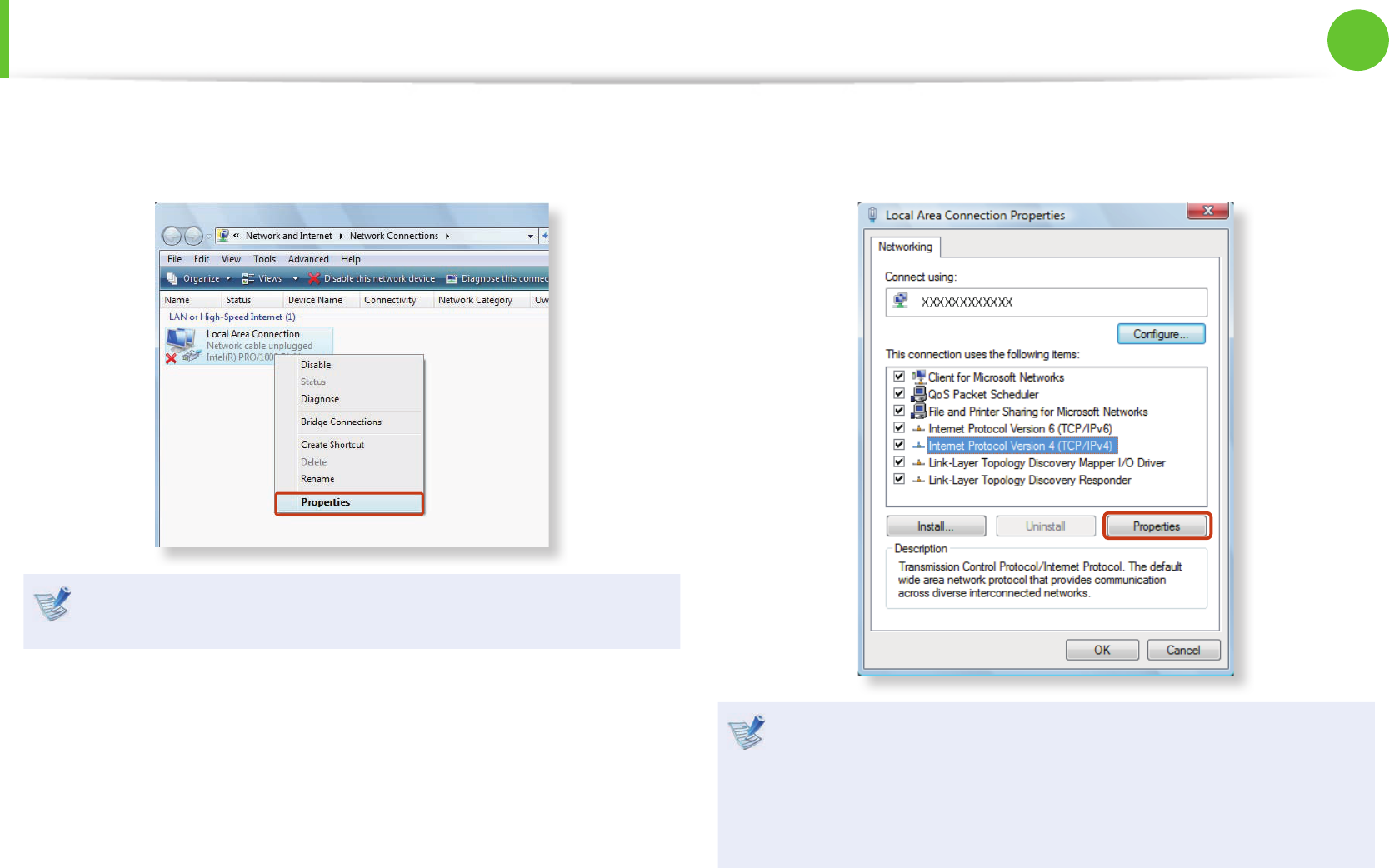
60
61
Chapter 2.
Using the computer
4 Select Local Area Connection and click the right button of
the touch pad and select Properties.
The LAN Device name may di er depending on your
computer’s Network Device.
5 Select Internet Protocol Version 4(TCP/IPv4) from the list
of Network Components and click Properties.
The Network Component name may di er depending on •
the Operating System Installed.
To add a network component, click • Install in the screen
shown in the gure above. You can add clients, services,
and protocols.
Wired Network (Optional)
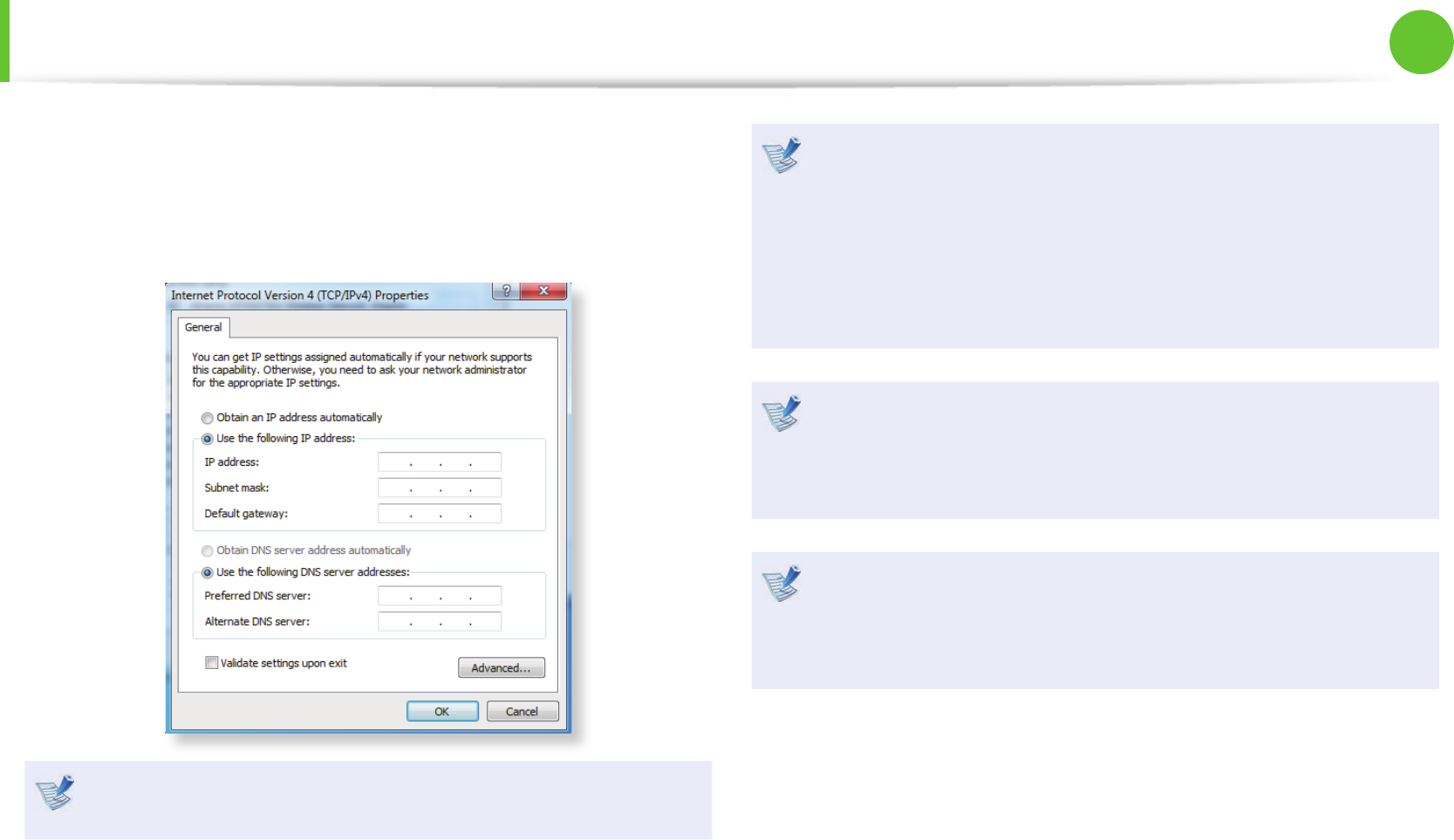
62
Chapter 2.
Using the computer
Wired Network (Optional)
6 Con gure the IP settings.
When using DHCP, select Obtain an IP address
automatically. To use a static IP address, select Use the
following IP address, and set the IP address manually.
When not using DHCP, ask your network administrator for the
IP address.
7 When you have completed the settings, click the OK button.
The network settings have been completed.
When connected to a 100Mbps/1Gbps wired LAN and the
computer exits Sleep/hibernation mode, a message appears
informing you of a connection to a 10Mbps/100Mbps
wired LAN. This happens because when the computer exits
standby/hibernate mode, restoring the network takes about
3 seconds. When the network is restored, it operates at
100Mbps/1Gbps.
When system is running on battery, some time it takes about
20sec after inserting LAN cable to be able to connect to
internet. This symptom happen as a result of power saving
feature to reduce battery consumption.
When system is running on battery, the Wired LAN speed
is decreased automatically to reduce battery consumption.
In such case, a 1Gbps /100Mbps LAN would function at
100Mbps/10Mbps speed.